The Codex of the Realms
A Comprehensive Guide to the World of Creatures & Chronicles
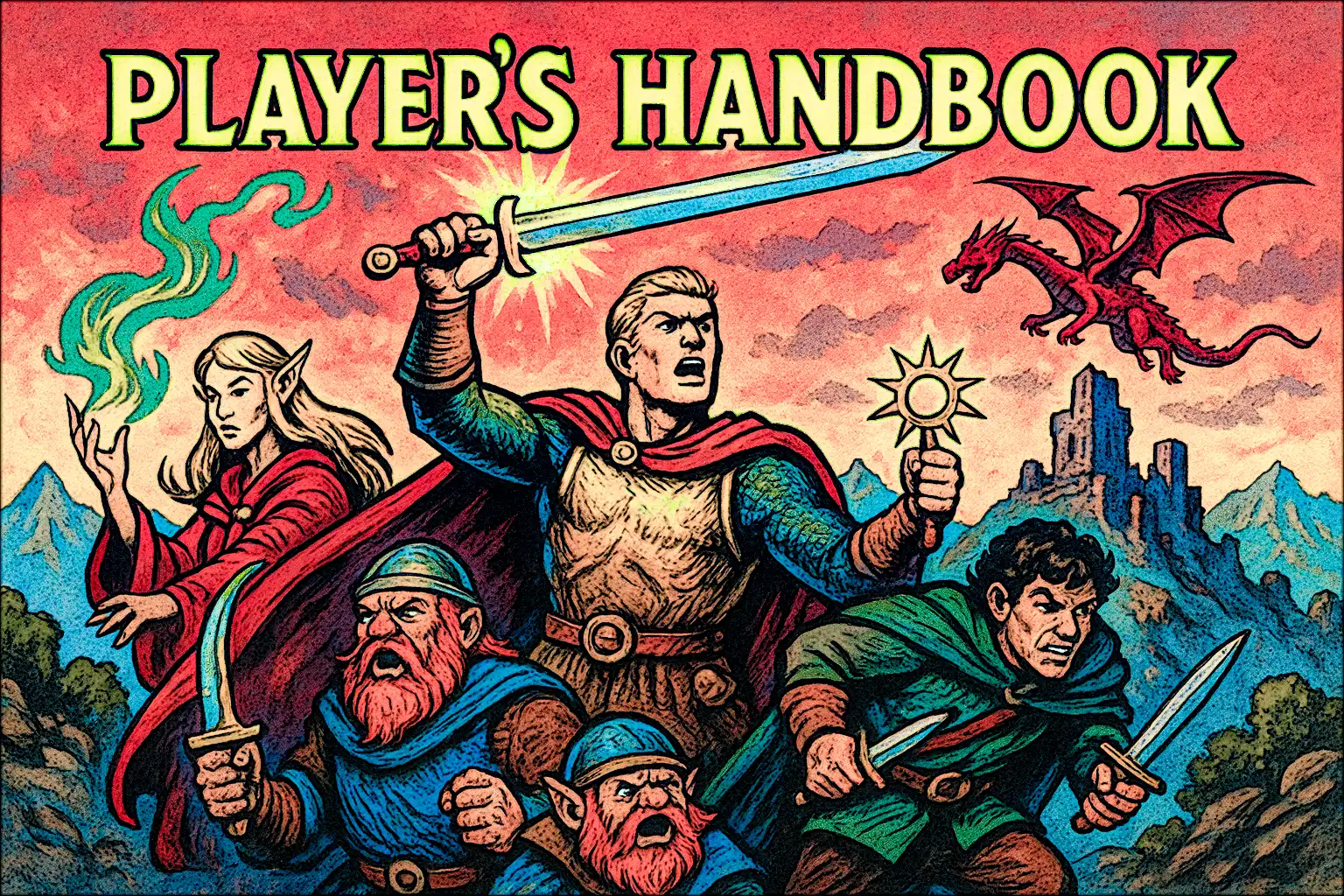
Introduction
Welcome, intrepid soul, to a tapestry woven from myth and might, from whispered prophecies and the clash of steel – welcome to the very heart of Creatures & Chronicles! You now hold not merely a guide, but a key: a portal into realms teeming with ancient wonders, shadowed perils, and the boundless potential of adventures yet unwritten. This Codex, a labor of many hands – from the cloistered sage to the grizzled sellsword – is your torch in the deepening twilight, your compass in lands uncharted.
Hark, aspirant, and attune thy senses to the echoes of ages past, for thou holdest a key – a gateway to the manifold realities that constitute Creatures & Chronicles. This humble codex, penned by diverse hands from sage to sellsword, is more than mere parchment and ink; it is a repository of foundational truths, a whispered guide through shadowed vales and sun-scorched plains. Within these passages lie the accumulated wisdom of those who have walked these paths before: the battle-cries of legendary warriors, the intricate formulae of archmagi, the fervent prayers of devout clerics, and the cunning stratagems of masters of stealth.
Whether thy destiny is to cleave foes with gleaming steel, to unravel the very fabric of magic, to mend the broken with divine grace, or to tread unseen where others falter, this tome shall serve as thy constant companion. It details the myriad races that populate these lands, the sacred callings that shape an adventurer's soul, the perilous dance of combat, the subtle and awesome power of magic, the tools of the trade, and the arduous path of growth and experience.
Let it be known, however, that this compendium offers but a framework. The true tapestry of adventure is woven from the threads of thy choices, thy courage, and thy companionships. The rules herein provide structure, but imagination breathes life into the world. Study these words with diligence, for in the crucible of the unknown, knowledge is a sharper blade than any forged, a stronger shield than any tempered. The path ahead is fraught with peril and promise; let this Codex illuminate thy way.
What is Roleplaying?
At its heart, roleplaying is a collaborative act of imagination, a shared journey into a world of wonder and consequence. It is a game where you, the player, step into the boots of a fictional character—an adventurer, a hero, perhaps even a scoundrel with a hidden heart of gold. You decide how this character thinks, what they say, and what actions they take in response to the myriad situations presented by the Game Master (GM).
The Game Master is your guide and the world's narrator, describing the environments your character explores, the creatures they encounter, and the challenges they face. Together, you and your fellow players, each embodying unique individuals, weave a story that is spontaneous, unpredictable, and uniquely your own. It's a conversation, a performance, and a puzzle all rolled into one, where the dice may guide fate, but your choices shape destiny. In Creatures & Chronicles, roleplaying is the art of becoming someone else, somewhere else, and forging a legend that will echo through the ages.
A Glimpse of Myriad Worlds: The Tapestry of Your Imagination
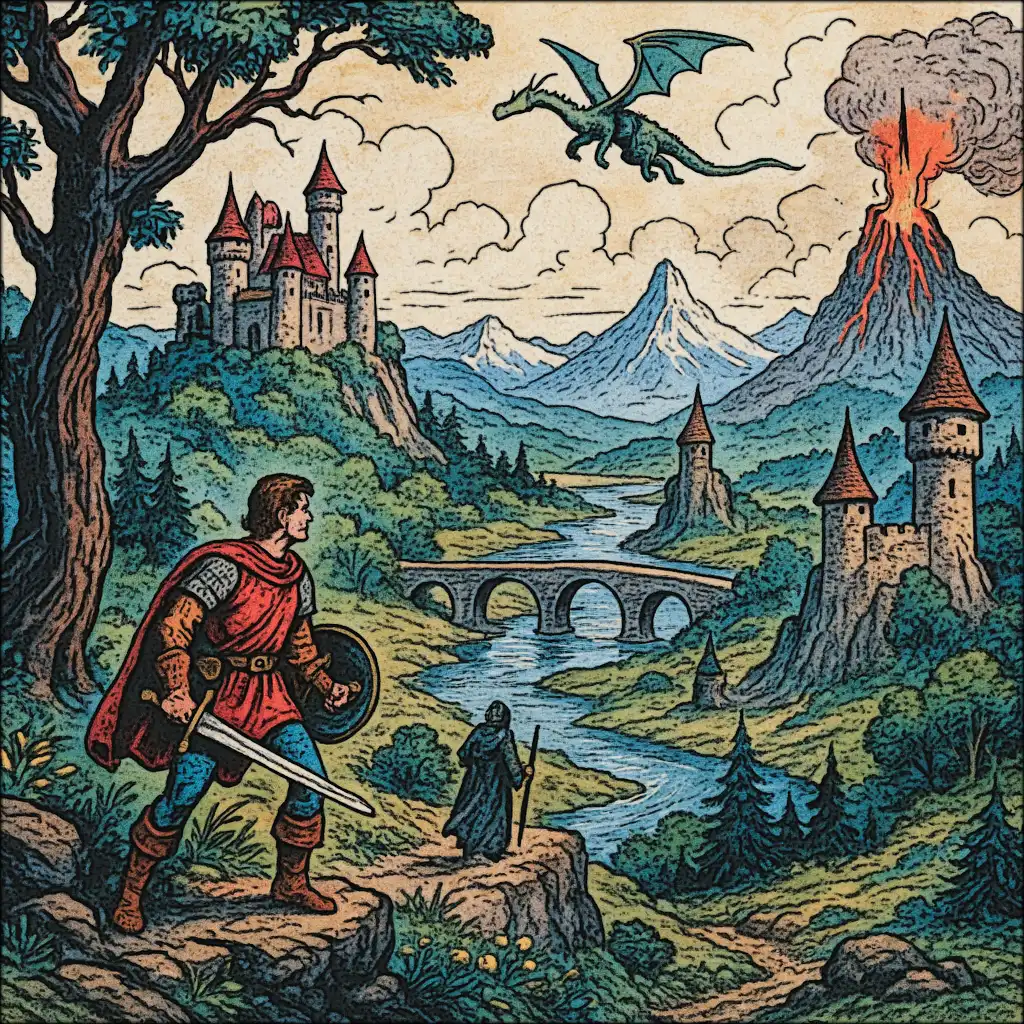
The realms of Creatures & Chronicles are as boundless as the collective imagination. Here, there is no single, predefined world, but an infinite expanse of potential settings, each waiting to be born from the minds of its players and Game Masters. Envision worlds steeped in ancient magic, scarred by forgotten wars, or illuminated by the flickering light of nascent empires of your own design. Picture jagged, dragon-haunted peaks giving way to whispering, primeval forests where fey cities might gleam; imagine sun-scorched deserts where lost civilizations sleep, or bustling, intrigue-filled port cities on storm-wracked coasts – all landscapes you can bring to life.
History itself is a canvas for your chronicles. Will your adventures unfold in a land with a detailed saga of rising and falling powers, of divine interventions and mortal ambitions clashing like thunder? Or will you explore a world fresh and new, its history yet to be written by your deeds? The elder races – the wise Elves, the stoic Dwarves, the enigmatic Gnomes – may remember ages of potent magic and colossal beasts, or they may be fledgling peoples finding their way in a universe you define. Humankind, ever restless and adaptive, can carve out kingdoms or republics, their cities vibrant hubs of trade, innovation, and conflict, all according to the narratives you weave. Halflings might tend their peaceful shires, contentedly apart or reluctantly drawn into grand dramas – the choice is yours.
Magic within these myriad worlds can be a wild and potent force, a subtle art, a divine gift, or a dangerous corruption. Arcane energies may pulse through ley lines you map, their power coveted by mages of your creation. Divine entities, diverse and often inscrutable, may lend their might to faithful clerics and paladins, their influence shaped by the pantheons you establish. For every benevolent deity, darker powers can stir in forgotten places, their cults plotting to unleash evils of your own devising upon unsuspecting worlds.
The central theme of Creatures & Chronicles is the power of story, the thrill of discovery, and the enduring spirit of adventure in settings limited only by your creativity. Civilizations may teeter on the brink, caught between echoes of a glorious past and the shadows of an uncertain future. Monsters, both familiar and uniquely conceived, can prey upon the unwary, and ambitious warlords might seek to forge empires. Yet, amidst these challenges, heroes will emerge. Your characters – individuals of courage, skill, and perhaps a touch of destiny – will rise to defend the innocent, explore the unknown, and carve their names into the chronicles of the age. This is the boundless potential you are about to enter – a place where your choices create the world, where your actions shape its fate, and where legends are born from the spark of imagination.
How to Use This Book: Your Guide to Adventure
This Codex is your companion and reference, designed to be both an introduction to the world of Creatures & Chronicles and a steadfast guide during your adventures. It is organized to lead you from the fundamental concepts of play to the intricate details of magic, combat, and the myriad creatures you might encounter.
-
Introduction & Core Concepts: You are here! This section lays the groundwork, welcoming you to the world and explaining the basic principles of roleplaying and how this handbook is structured. -
Chapter I: Races of the Realms: Delve into the diverse ancestries available for your character, each with unique traits and rich cultural backgrounds. -
Chapter II: Character Classes: Explore the various professions and callings, from the mighty Fighter to the cunning Thief, understanding their abilities and roles. Chapter III: The Art of Magic: Uncover the secrets of arcane and divine spellcasting, with comprehensive lists and descriptions of spells.-
Chapter IV: Combat Mechanics: Master the rules of battle, from initiative and attack rolls to damage and healing. Chapter V: Skills & Proficiencies: Learn about the various skills, talents and proficiencies your character can acquire.Chapter VI: Experience and Advancement: Understand how your character grows in power and renown.Chapter VII: Equipping for Adventure: All about equipment and treasure. Discover the tools of the trade, the spoils of your quests, and the flow of commerce.-
Chapter VIII: Wealth & Commerce: The economy of Creatures & Chronicles and it's many facets. Chapter IX: The Bestiary: A comprehensive guide to the creatures, great and small, that inhabit these lands.Appendices: Here you will find quick reference charts, glossaries, and perhaps even a blank character sheet to begin your journey.
We encourage you to read the initial chapters thoroughly to grasp the fundamentals. Later sections, such as detailed spell lists or creature descriptions, can be consulted as needed during gameplay. Look for highlighted text, sidebars with lore, and illustrative examples designed to clarify rules and immerse you further into the world. May this Codex serve you well!
Core Concepts & Game Philosophy: The Engine of Adventure
Creatures & Chronicles is built upon a few fundamental principles that govern how stories unfold and challenges are resolved. Understanding these core concepts will empower you to navigate the game world with confidence.
The Dice Decide Fate (Often): Many actions with uncertain outcomes, from swinging a sword to persuading a stubborn merchant, are resolved by rolling dice. Typically, this involves a 20-sided die (d20). You'll add relevant modifiers (from your character's attributes, skills, or situational factors) to the die roll. If the total meets or exceeds a target number (often called a Difficulty Class or DC, or determined by an opponent's Armor Class), your character succeeds. A natural roll of 20 on the d20 is often a "critical success," yielding exceptional results, while a natural 1 can be a "critical fumble," leading to unfortunate complications. Other dice (d4, d6, d8, d10, d12, d100/percentile) are used for determining damage, the magnitude of effects, or other variable outcomes.
The Game Master (GM): The GM is the storyteller, the referee, and the custodian of the C&C world. They describe the environment, portray the non-player characters (NPCs) and creatures, present challenges, and interpret the rules. The GM doesn't play "against" the players; rather, they collaborate to create a fun and engaging story for everyone. Their goal is to provide a challenging but fair world for your characters to explore and interact with.
The Players: You and your fellow adventurers are the protagonists of the story. Your choices and actions drive the narrative. Collaboration is key; work with your party members, leveraging your diverse skills and abilities to overcome obstacles that would be insurmountable alone.
The Goal of Play: While specific quests and adventures will have their own objectives, the overarching goal of Creatures & Chronicles is to create memorable stories, explore a rich and detailed world, develop compelling characters, and, most importantly, have fun! Whether you seek fame, fortune, justice, knowledge, or simply the thrill of adventure, the path is yours to forge. Embrace the unexpected, learn from your mistakes, celebrate your victories, and let your legend unfold.
Chapter I:
Races of the Realms
The vast and ancient world of Creatures & Chronicles is a vibrant mosaic, home to a diverse tapestry of sentient beings, each shaped by unique histories, environments, and inherent natures. From the bustling, ephemeral cities of humankind to the timeless sylvan glades of the elves, from the stoic, subterranean kingdoms of the dwarves to the rolling, peaceful shires of the halflings, the choice of one's race is perhaps the most fundamental decision an adventurer makes. It dictates not only physical stature and innate talents but also deep-seated cultural perspectives, potential lifespans, and how the other denizens of these complex realms – from lowly goblins to mighty dragons, from shrewd merchants to suspicious guards – will perceive and react to thee. Choose, therefore, with foresight and wisdom, for thy lineage is the bedrock upon which thy legend shall be built.
Humans: The Sundered Flame

Ubiquitous and endlessly varied, humankind stands as the most populous and perhaps most paradoxical of the major races. Possessing neither the elves' ageless grace nor the dwarves' stony resilience, humans compensate with a fierce adaptability and an unquenchable fire of ambition that has seen them raise empires from dust and explore the farthest reaches of the known world. Their lifespans, fleeting compared to the elder races, often fuel this relentless drive, creating a dynamic tension between the pursuit of immediate glory and the desire for lasting legacies.
Physical Characteristics: Humans exhibit the widest range of physical variation, with skin tones from pale alabaster to deep ebony, hair like spun gold or midnight shadow, and eyes reflecting every hue of the gem-seller's tray. Their height typically ranges from five to well over six feet.
Racial Abilities & Traits: Humans possess no inherent bonuses or penalties to their core attributes (Strength, Dexterity, Constitution, Intelligence, Wisdom, Charisma), reflecting their balanced nature. Their greatest asset is their boundless potential; humans face no racial limitations on the levels they can achieve in any character class, allowing them to pursue mastery in any field to which they dedicate themselves.
Culture & Society: Human societies are extraordinarily diverse, ranging from highly structured feudal kingdoms and sprawling bureaucratic empires to nomadic horse tribes, maritime trading confederations, and isolated religious communes. Their faiths are equally varied, venerating vast pantheons or adhering to strict monotheistic creeds. This cultural plasticity allows humans to integrate into almost any environment or social structure, though it can also lead to profound internal conflicts and shifting alliances. They are builders, innovators, conquerors, and scholars, their history a turbulent cycle of creation and destruction.
Elves: The Whispering Leaves

Dwellers of ancient forests and keepers of lore forgotten by younger races, the elves move through the world with an ethereal grace born of centuries of existence. They perceive time differently, their lives unfolding with the slow patience of growing things. Possessing a deep, intrinsic connection to the natural world and the subtle currents of magic that flow through it, elves often seem aloof or melancholic to those whose lives burn bright and brief.
Physical Characteristics: Elves are typically tall and slender, with fine features, pointed ears, and eyes that hold an unnerving depth of wisdom and age. Their movements are fluid and economical. They reach physical maturity at roughly the same pace as humans but cease to show overt signs of aging for many centuries, their lifespans often exceeding seven hundred years.
Racial Abilities & Traits: Their natural agility grants them a +1 bonus to Dexterity, aiding their skills in archery, stealth, and fine manipulation. However, their lighter frames are less hardy, resulting in a -1 penalty to Constitution. Elves possess a remarkable resistance to sleep-inducing and charm-based magic (often gaining a 90% resistance or significant bonus on saving throws against such effects), their minds subtly different and more resilient. Their keen senses include Infravision, allowing them to perceive heat signatures in darkness up to 60 feet, effectively seeing in the dark. They are also adept at noticing secret or concealed doors when actively searching, finding them more readily than other races (often on a roll of 1-2 on a d6, versus 1 for other races when passing within 10 feet).
Culture & Society: Elven society values art, music, nature, and magic. Their cities, often seamlessly integrated with the natural landscape, are places of breathtaking beauty and subtle enchantment. While generally leaning towards good alignments, their detachment can sometimes manifest as arrogance or a frustrating neutrality in the face of immediate crises that seem trivial from their long perspective. They excel as Mages (tapping into their innate magical sensitivity) and Rangers (masters of their woodland homes), and often blend these paths as Fighter/Mages or Mage/Thieves. However, their focus on finesse and magic means they may face limitations progressing to the highest echelons of purely martial classes like the Fighter, or find the rigid dogma of some Clerical orders incompatible with their worldview (though elven deities of nature and magic certainly exist and grant power). Level limits often apply to elves in non-favored classes.
Dwarves: The Children of Stone
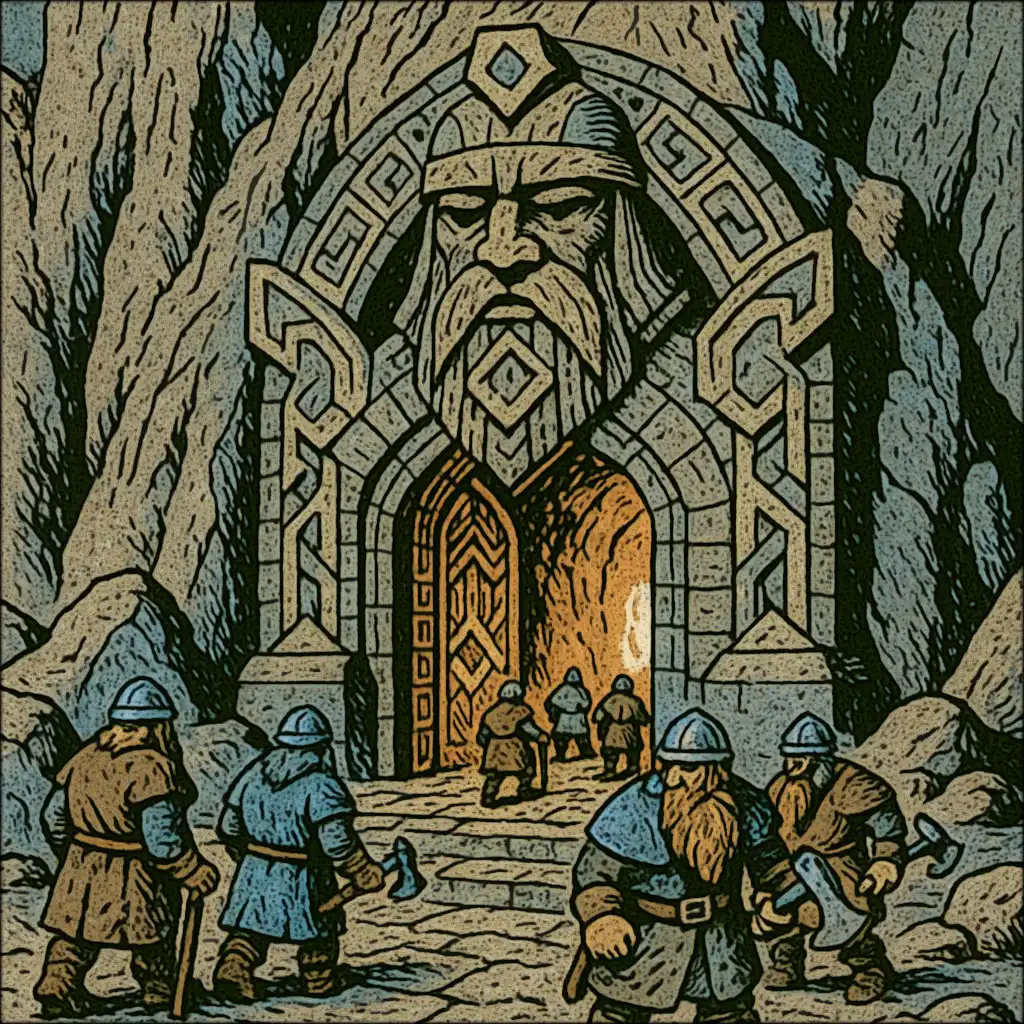
Hewn from the bedrock of the world, the dwarves are a folk of enduring strength, unwavering loyalty, and legendary stubbornness. Their kingdoms lie deep beneath the mountains, vast networks of mines, forges, and stone halls echoing with the ring of hammers and the songs of ancient lineage. Short and stocky, yet immensely powerful, dwarves are masters of metalcraft, stonemasonry, and warfare, particularly in the close confines of their subterranean homes.
Physical Characteristics: Dwarves stand between four and five feet tall but are broad and densely muscled, often weighing as much as a taller human. Their skin tones range from deep tan to ruddy brown, and they cultivate magnificent beards and hair, often intricately braided and adorned with rings, as symbols of status and honor. They typically live for several centuries (around 350-450 years), though not as long as elves.
Racial Abilities & Traits: Their inherent toughness grants them a +1 bonus to Constitution, making them exceptionally resilient to hardship and poison. Their gruff, pragmatic demeanor, however, can sometimes be perceived as churlish, resulting in a -1 penalty to Charisma when dealing with other races. Like elves, dwarves possess Infravision up to 60 feet. Generations of subterranean life have honed their senses to the nuances of stonework; they have an uncanny ability to detect slanting passages, hidden construction (like traps or secret doors in stone), shifting walls, and structural weaknesses in stone or earth (often on a roll of 1-4 on d6 when actively searching within 10 feet). Their age-old wars against giants, goblins, and other denizens of the deep have honed their combat skills, granting them specific combat bonuses when facing such ancestral foes (+1 to hit is typical for Orcs, Goblins, Hobgoblins; potentially higher vs Giants). They are also highly resistant to magic and poison, gaining substantial bonuses (often +1 per 3.5 points of Constitution, rounded down) to saving throws against spells, rods, staves, wands, and poison.
Culture & Society: Dwarven society is organized around clans, guilds, and ancient codes of honor. They value craftsmanship, tradition, ancestral ties, and the accumulation of wealth (particularly in the form of gold, gems, and finely wrought items). They are often lawful in alignment, adhering strictly to oaths and contracts, but their loyalty is primarily to their own kin and clan. Dwarves make peerless Fighters, their strength and resilience perfectly suited to frontline combat, and many serve devoutly as Clerics of deities representing stone, smithing, and righteous battle. Their innate resistance to magic, coupled with a cultural suspicion of arcane forces they cannot shape with hammer and tongs, makes the path of the Mage entirely inaccessible to them. They may also face level limitations in classes other than Fighter or Cleric.
Halflings: The Quiet Folk
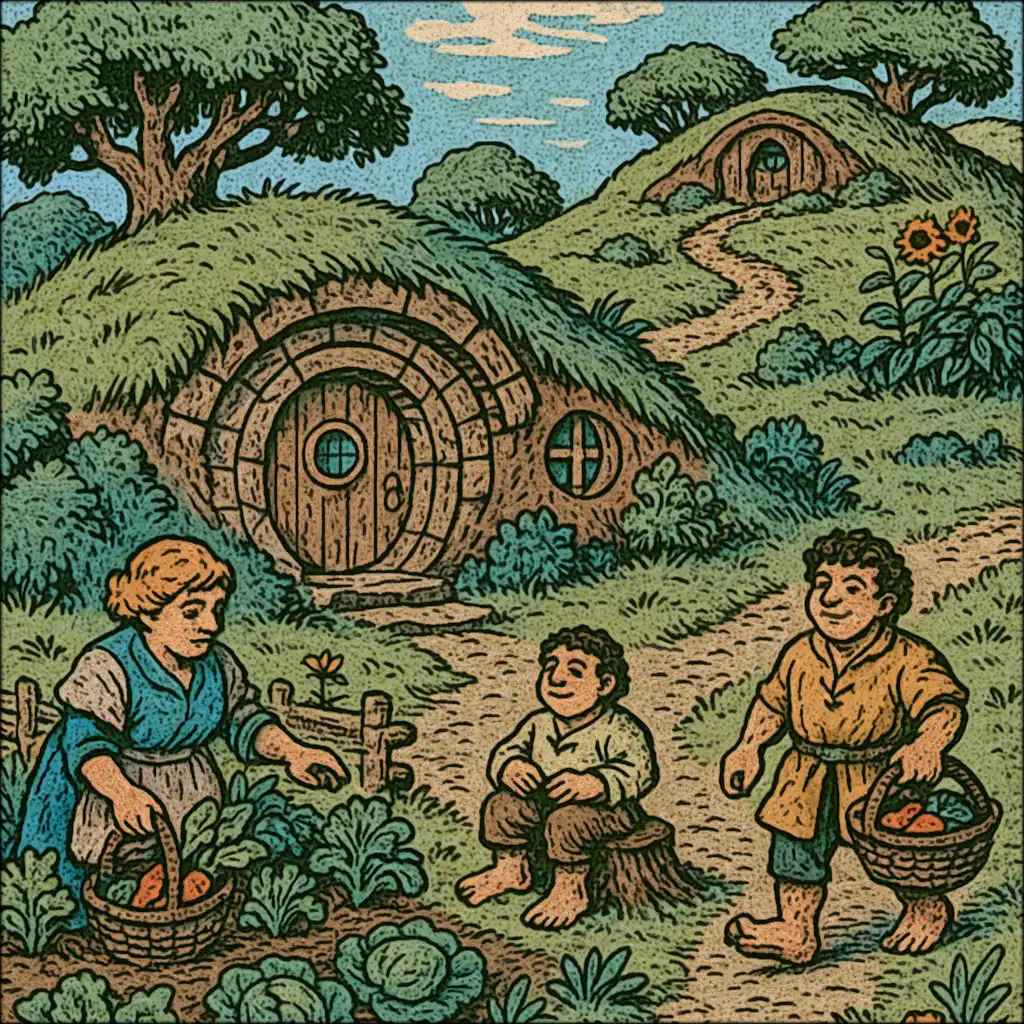
Often overlooked, dwelling in pastoral tranquility, the halflings are a race whose small stature belies a surprising resilience and a deep appreciation for the comforts of hearth and home. Preferring rolling hills, fertile river valleys, and close-knit communities, they value peace, good meals, fine pipeweed, and the company of friends and family above the grand ambitions that drive other races. Yet, when danger threatens their idyllic existence, or when the lure of adventure proves irresistible, halflings can display remarkable courage and unexpected resourcefulness.
Physical Characteristics: Averaging only three to four feet in height, halflings are nimble and often slightly stout, with faces that easily break into smiles. They favor comfortable, practical clothing and often go barefoot, their feet possessing tough, leathery soles. They age similarly to humans, typically living just over a century.
Racial Abilities & Traits: Their small size and natural agility grant them a +1 bonus to Dexterity, making them adept at moving quietly and dodging attacks. This same slightness results in a -1 penalty to Strength. Halflings possess an almost preternatural luck, gaining substantial bonuses (often +1 per 3.5 points of Constitution, rounded down) to saving throws versus spells, poison, and effects from magical rods, staves, or wands – matching the dwarves in this regard. They are also remarkably skilled with thrown weapons and slings (+1 to hit). In natural surroundings, particularly outdoors amongst foliage or shadows, their ability to Hide in Shadows or Move Silently is significantly better than other races (often reflected as a bonus to Thief skill checks or a separate base chance for success). Their small size allows them to hide more effectively in cover appropriate to their stature.
Culture & Society: Halfling society is centered around the village, the hearth, and the pantry. They are generally good-natured (often Neutral or Good alignment), curious, and fiercely loyal to their friends and communities. While capable warriors when pressed (particularly with slings or short swords), their strengths lie overwhelmingly in stealth and evasion. This makes them exceptional Thieves, their small size and natural talents aligning perfectly with the skills of infiltration and subterfuge. Some halflings also follow the path of the Fighter, relying on agility and ranged attacks rather than brute force. However, their inherent disinclination towards grand quests and physically demanding professions means they face significant level limitations in most classes, particularly those requiring great strength (like Fighter, where they might cap at a low-to-mid level) or arcane power (like the Mage, which is utterly beyond them). Clerics are rare among halflings, their faith often more personal and less formalized.
Gnomes: The Keepers of Hidden Ways

Hidden away in cleverly concealed burrows within wooded hills or beneath the gnarled roots of ancient trees, the Gnomes are a race of diminutive folk renowned for their affinity with the earth, their intricate craftsmanship, their surprisingly potent illusions, and an irrepressible, often mischievous, sense of humor. Though smaller even than halflings, gnomes possess a resilience and a keen intellect that makes them formidable in their own right. They are masters of gem-cutting, intricate clockwork mechanisms, and the subtle arts of illusion.
Physical Characteristics: Gnomes typically stand between 3 and 3.5 feet tall, with earthy skin tones (often ruddy or brown), and bright, intelligent eyes. They tend to have prominent noses and often sport neatly trimmed beards or elaborate hairstyles. They age at a similar rate to dwarves, often living for several centuries (350-500 years).
Racial Abilities & Traits: Their sharp minds grant them a +1 bonus to Intelligence, making them quick studies and adept problem-solvers. Their small frames, however, result in a -1 penalty to Strength. Gnomes, like their dwarven cousins, possess Infravision up to 60 feet. They are naturally resistant to many forms of magic, gaining saving throw bonuses (often +1 per 3.5 points of Constitution, rounded down) against spells, rods, staves, and wands – similar to dwarves and halflings. Their deep connection to the earth grants them an innate ability to detect sloping passages, unsafe stonework, approximate depth underground, and determine direction while subterranean with remarkable accuracy (often on a roll of 1-4 on d6). They are also known for their particular enmity towards kobolds and goblins, often gaining a +1 bonus to attack rolls against these specific foes due to generations of territorial squabbles.
Culture & Society: Gnomish communities are tight-knit, valuing hard work, cleverness, good jokes, and beautifully crafted objects. Their burrows are often marvels of hidden engineering, filled with ingenious contraptions and sparkling gems. Gnomes are generally good-natured (often Neutral Good or Lawful Good) and enjoy elaborate pranks, though these are rarely malicious. Their primary contributions to adventuring parties often come in the form of Illusionists (their high Intelligence and natural affinity for deceptive magic making them particularly potent), Thieves (their small size and dexterity serving them well), or Fighter/Illusionists and Fighter/Thieves. Some gnomes also become Clerics, often dedicated to deities of the earth, craft, or trickery. Due to their physical stature and specific aptitudes, they may face level limitations in purely martial classes like Fighter, and the path of the Paladin is rarely trod by their kind. They cannot become Mages (the structured arcane study being different from their innate illusionism) or Druids.
Chapter II:
Character Classes
Beyond the legacy of one's race, the path an adventurer chooses to walk is defined by their Class – a specialized calling that dictates their skills, abilities, and role within a fellowship of questers. Each class is a distinct tradition, a body of knowledge and practice honed over generations, offering unique advantages in the face of peril, but also imposing certain limitations and demanding specific aptitudes. The selection of a class is a commitment, a vow to master a particular set of disciplines. Whether one chooses the way of the stalwart Fighter, the devout Cleric, the arcane Mage, the cunning Thief, or the hardy Ranger, this choice will profoundly shape thy capabilities and thy destiny.
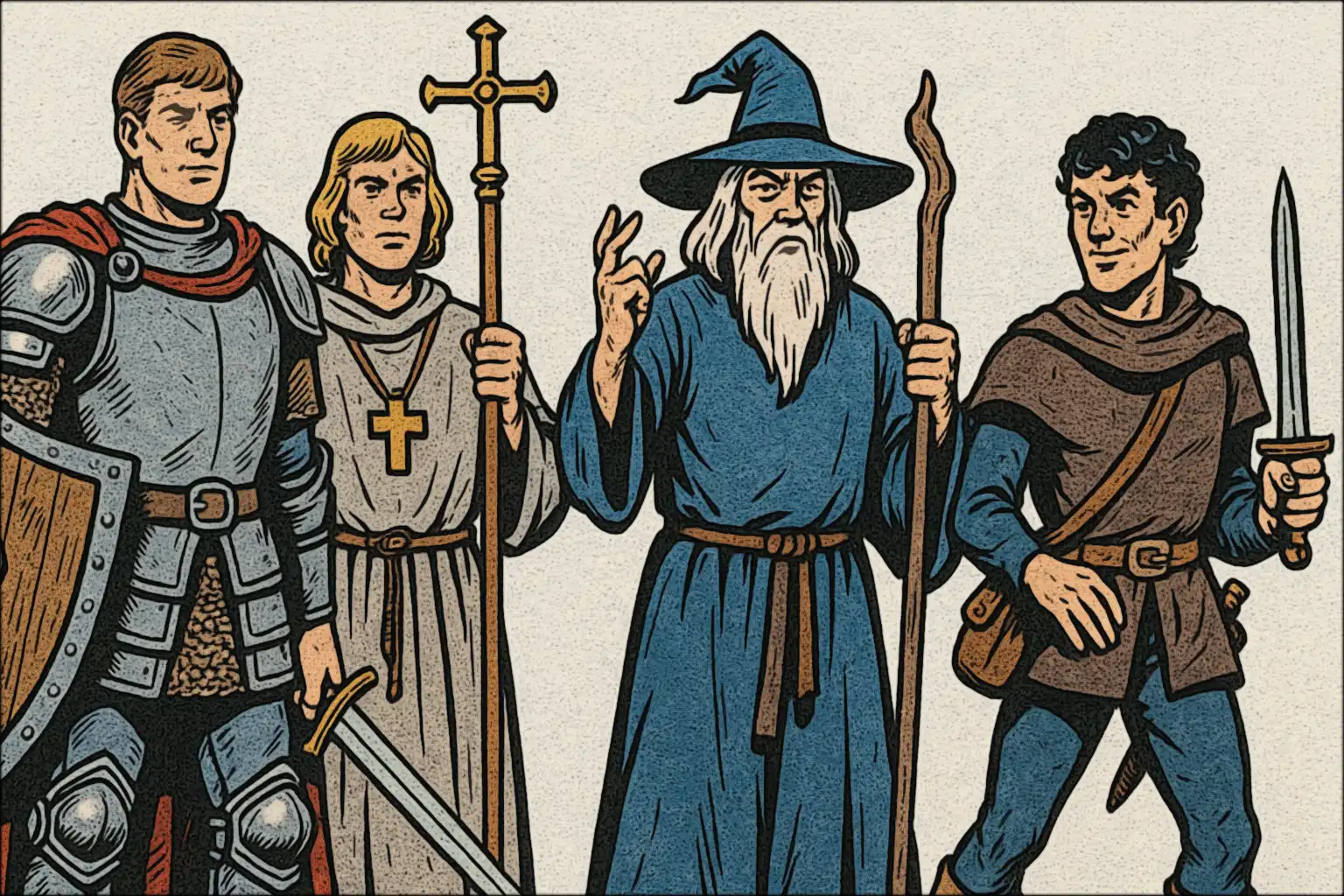
Fighters: The Pillars of Battle
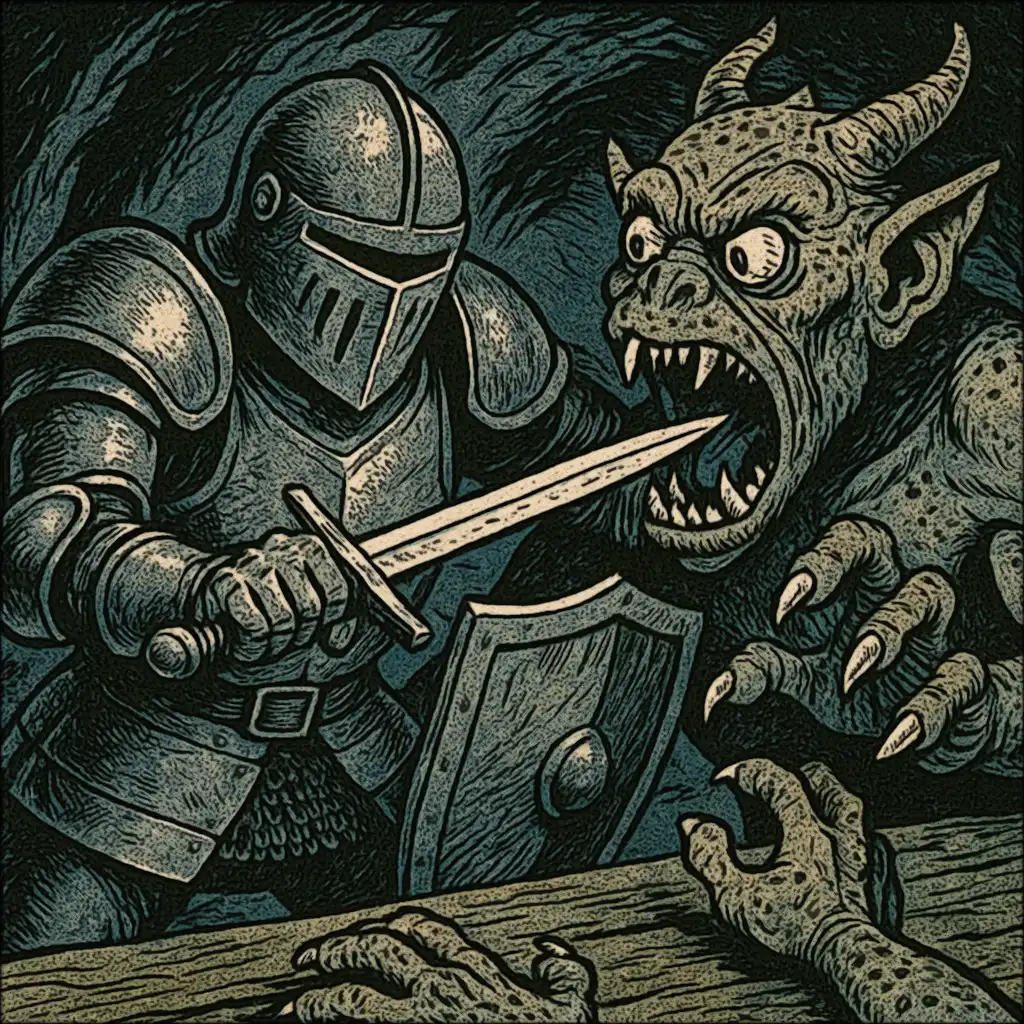
In the chaotic maelstrom of combat, the Fighter stands as a bulwark, a master of arms and armor whose courage and skill turn the tide of desperate engagements. Primary Attributes: Strength is paramount for dealing damage in melee, enhancing the might of their blows and allowing them to wield heavier weapons effectively. Constitution determines the Fighter's resilience, their capacity to withstand punishment, represented by their substantial pool of hit points. Dexterity aids in defense (improving Armor Class by making them harder to hit) and governs proficiency with ranged weapons.
Hit Dice: d10 per level, the highest available, reflecting their exceptional physical conditioning and ability to endure grievous wounds.
Armor & Weapon Proficiencies: Uniquely versatile, Fighters are proficient with all forms of armor (Padded, Leather, Studded Leather, Chain, Scale, Plate) and shields, suffering no penalties for their use beyond standard encumbrance rules regarding movement and fatigue. They are likewise proficient with all common melee and ranged weapons, from the humble club to the mighty two-handed sword, from the simple sling to the powerful longbow.
Special Abilities: The Fighter's core strength lies in pure combat capability. They begin with more weapon proficiency slots than any other class (typically 4), allowing broad versatility or early specialization. As they advance, they gain additional proficiency slots, which uniquely among classes, can be used to Specialize in a chosen weapon type (e.g., Longsword Specialization). Weapon Specialization (costing extra slots, often 2 for the first specialization) grants significant bonuses, such as +1 to attack rolls and +2 to damage rolls with that specific weapon, and often an increased number of attacks per round with that weapon at higher levels (e.g., 3 attacks every 2 rounds starting around 7th level, then perhaps 2 attacks per round around 13th level). Further mastery might even be possible at legendary levels. Their THAC0 (To Hit Armor Class 0) improves more rapidly than any other class, making them increasingly accurate and deadly as they gain experience.
Role & Advancement: The Fighter is the frontline combatant, the protector absorbing blows meant for frailer companions, the shock trooper breaking enemy lines. Their path is one of physical discipline, tactical awareness, and relentless honing of martial skills. While lacking the overt magic or subtle skills of other classes, their sheer martial prowess makes them indispensable. Humans and Dwarves often excel as Fighters due to their resilience or lack of level limits, though any race may pursue this path (subject to racial level restrictions). Their advancement focuses primarily on improving hit points, THAC0, saving throws (especially physical ones), and gaining more attacks or refining their weapon specialization.
From the Tactica Militarum: "Let the mage weave his spells and the thief pick his locks; when the Orcish horde breaks upon your lines, it is the iron will and sharp steel of the Fighter that will hold the day. Fear is a luxury a warrior cannot afford; valor, their daily bread. Their armor is their argument, their blade the final word."
Clerics: Vessels of Divine Might

Where mortal skill falters and arcane energies prove insufficient, the Cleric calls upon powers beyond the ken of ordinary folk, serving as a conduit for the will of the gods or the fundamental forces of the cosmos (such as cosmic balance, or the primal energies of life itself). Primary Attributes: Wisdom is the most critical attribute, determining the power and number of spells the Cleric is granted each day, and potentially affecting their resistance to mental attacks. Charisma influences their ability to Turn Undead, lead followers, and interact persuasively. Strength and Constitution are important for their role as capable combatants and their ability to survive on the front lines.
Hit Dice: d8 per level, indicating good resilience tempered by their divine duties and focus on spiritual matters over pure physical training.
Armor & Weapon Proficiencies: Clerics are proficient with all armor types and shields, allowing them to stand alongside Fighters in the thick of battle. However, their divine oaths or the nature of their faith often restricts them to weapons that do not draw blood with an edge – Maces, War Hammers, Flails (often considered acceptable despite chains/spikes), Clubs, Quarterstaves, and Slings are their typical armaments. Using edged weapons like swords or axes may violate their tenets and risk divine disfavor or penalties.
Special Abilities: The Cleric's defining ability is Divine Spellcasting. They gain access to spells through prayer and devotion, organized into levels of increasing power (1st level spells, 2nd level, etc.). The number and level of spells they can prepare per day depends on their character level and Wisdom score (high Wisdom often grants bonus spells). Clerical spells typically focus on healing (Cure Wounds series, Heal), protection (Bless, Protection from Evil, Sanctuary, Resist Fire/Cold), buffing allies (Aid, Prayer, Chant), detection and divination (Detect Magic, Detect Evil, Find Traps), utility (Create Water, Light), and combating specific foes (Hold Person, Dispel Magic, Silence 15' Radius, Flame Strike). Their other signature ability is Turning Undead: by channeling divine power through their holy symbol (requiring its presentation), they can force undead creatures (skeletons, zombies, ghouls, shadows, wights, etc.) to flee in terror or be utterly destroyed. The effectiveness of turning (represented by a chart comparing Cleric level vs. Undead Hit Dice/type) depends heavily on the Cleric's level relative to the power of the undead. Success is determined by a d20 roll. At higher levels, Clerics may gain the ability to establish temples, attract faithful followers (including lesser clerics and loyal men-at-arms), and even craft certain holy items.
Role & Advancement: The Cleric is the party's primary healer, spiritual guide, knowledgeable resource on religion and the undead, and often a capable secondary combatant, particularly effective against undead and evil outsiders. Their advancement grants more spells per day, access to higher-level spells, improved Turning ability, better THAC0, hit points, and saving throws (especially against mental or divine effects). Humans, Dwarves, and sometimes Elves (depending on the setting's deities) often become Clerics. Their alignment must typically match that of their deity or divine source.
A Cleric's Invocation: "By the light that banishes shadow, by the truth that shatters lies, by the faith that moves mountains, I beseech thee, O Great Power! Grant thy servant strength to protect the innocent, wisdom to guide the lost, and courage to face the encroaching dark. Ward us from evil, mend our wounds, and let thy righteous judgment fall upon the unholy!"
Mages: Weavers of Arcane Energies
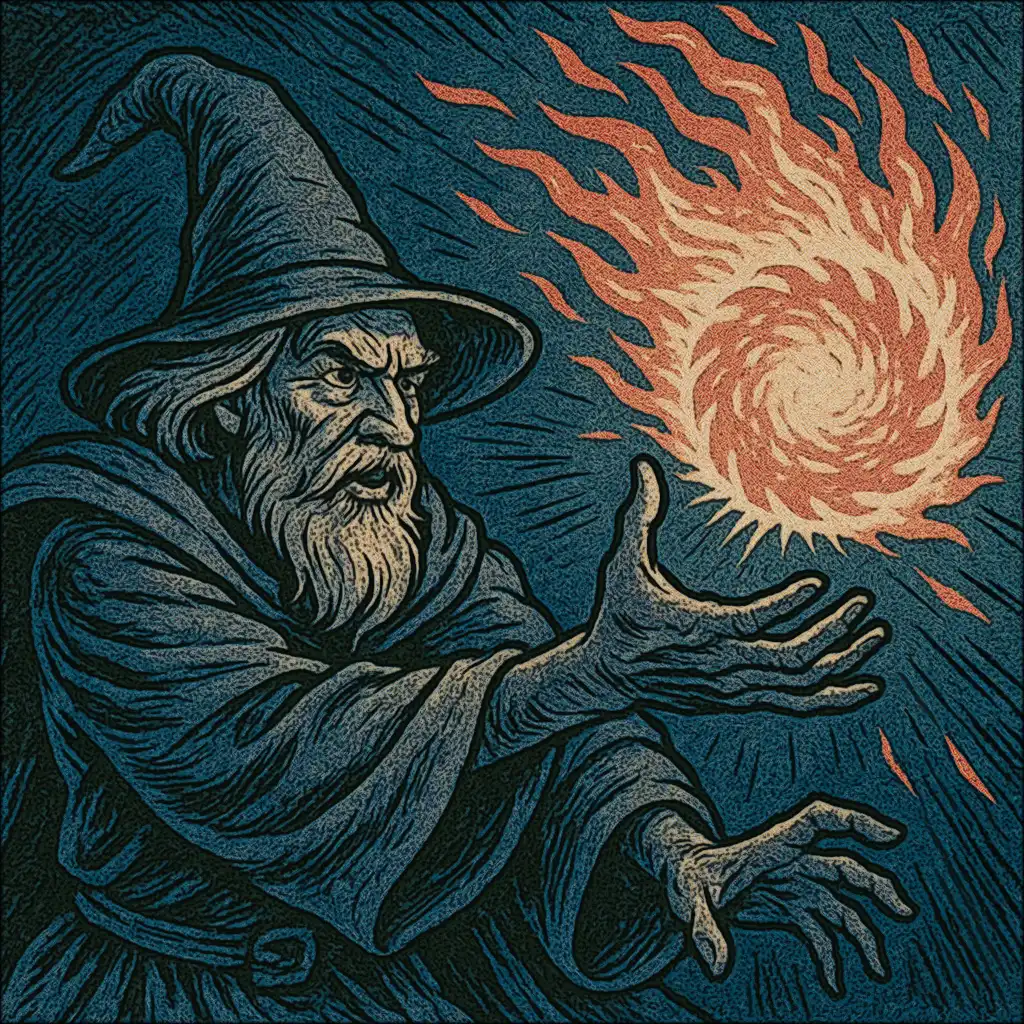
The Mage walks a perilous but potent path, delving into the esoteric secrets of arcane magic – the fundamental energies of creation and entropy – to bend reality to their will. Primary Attributes: Intelligence is the cornerstone of a Mage's power, dictating the maximum spell level they can learn and cast, the number of spells they can understand and scribe into their spellbook per level, their chance to successfully learn a spell from a scroll or captured tome, and the number of spells they can memorize per day. Dexterity can aid their poor Armor Class by making them harder to hit, while Constitution is vital for survival due to their low hit points.
Hit Dice: d4 per level, the lowest of all classes, emphasizing their physical vulnerability and reliance on magical defenses or stalwart companions.
Armor & Weapon Proficiencies: Mages are proficient with no armor or shields. Donning any armor interferes with the complex somatic (gestural) components of their spellcasting, causing spells to fail. Their only weapon proficiencies are typically the Quarterstaff (a walking stick and focus) and the Dagger (a tool for inscribing runes or last resort defense).
Special Abilities: The heart of the Mage class is Arcane Spellcasting. They learn spells through intense study and discovery, inscribing the complex formulae into their precious spellbooks. They must memorize spells daily (usually requiring several hours of uninterrupted study) from their book to hold them in their mind, ready for casting (the Vancian system). Once cast, the mental energy is discharged, and the spell must be re-memorized. The number of spells memorizable per level per day depends on the Mage's character level and Intelligence. Arcane spells cover a vast and versatile range of effects: direct damage (Magic Missile, Burning Hands, Lightning Bolt, Fireball), illusions and deception (Phantasmal Force, Invisibility, Mirror Image), protective wards (Shield, Protection from Evil, Resist Fire/Cold, Stoneskin), divination and knowledge (Detect Magic, Read Magic, Identify, Wizard Eye), utility and manipulation (Light, Read Languages, Knock, Levitate, Fly, Teleport), summoning (Find Familiar, Monster Summoning series), and potent control effects (Sleep, Web, Charm Person, Hold Monster, Polymorph Others). As they advance, Mages gain the ability to cast more spells per day and access higher, more reality-bending spell levels (up to the legendary 9th level). At higher levels, they may also gain the ability to research entirely new spells, scribe magical scrolls for later use or sale, and craft certain powerful magic items (like wands, staves, rings, or potions).
Role & Advancement: The Mage is the arcane powerhouse, the solver of mystical problems, the source of devastating offensive capabilities, and the controller of battlefield conditions, but requires careful protection from physical threats. Advancement brings more spells per day, access to higher spell levels, improved saving throws (particularly against spells and wands), and potentially expanded arcane research and item creation abilities. Humans (with their unlimited potential) and Elves (with their innate magical affinity) are the races most commonly drawn to the arcane arts. Dwarves and Halflings, inherently resistant or disinclined towards such magic, cannot become Mages.
From the Grimoire of Archmage Valerius: "Magic is not a hammer to shatter, but a key to unlock. It is a river, and the caster but a conduit. Force its flow, and it will consume thee. Understand its currents, and it will carry thee to wonders unimaginable. Respect the limits, study diligently, and never, ever assume thou hast mastered that which is fundamentally boundless. The price of hubris in our art is often oblivion. Keep thy spellbook close, and thy wits sharper."
Thieves: Masters of Shadow and Subterfuge

Where warriors clash and mages unleash arcane barrages, the Thief operates in the spaces between, a creature of shadow, cunning, and deft skill, turning obstacles into opportunities. Primary Attributes: Dexterity is paramount, governing nearly all their unique thieving skills (Pick Pockets, Open Locks, Find/Remove Traps, Move Silently, Hide in Shadows), as well as improving their Armor Class, ranged attacks, and initiative. Intelligence aids in deciphering languages, understanding complex mechanisms (like traps), and figuring out puzzles. Charisma can be useful for deception, bluffing guards, or gathering information in the underworld.
Hit Dice: d6 per level, reflecting greater agility and street-honed toughness than a Mage, but less raw endurance than a Fighter or Cleric.
Armor & Weapon Proficiencies: Thieves are restricted to light armor only – typically Padded, Leather, or Studded Leather, as heavier types impose significant penalties on their stealth and dexterity-based skills. They cannot use shields effectively without similar penalties. Their weapon selection favors those usable with stealth, precision, or concealability: Dagger, Short Sword, Club, Sling, Shortbow, and sometimes light crossbows, depending on the specific rules interpretation.
Special Abilities: The Thief class is defined by a suite of unique percentile-based skills: Pick Pockets (lifting valuables unnoticed from another person), Open Locks (bypassing mundane locks without a key), Find/Remove Traps (detecting and carefully disarming mechanical traps like poisoned needles, pits, or scything blades), Move Silently (moving without making audible noise), Hide in Shadows (becoming effectively invisible when in areas of dim light or substantial cover), Detect Noise (hearing faint sounds like conversations or approaching footsteps through doors or walls), and Climb Walls (scaling sheer surfaces that lack obvious handholds). The base chance for success in these skills often depends on race (Halflings excel, Elves are good) and Dexterity score, and improves significantly as the Thief gains levels, with points allocated by the player among the skills. Their other key offensive ability is the Backstab : when attacking an opponent who is unaware of their presence (e.g., surprised or attacked from behind) with an appropriate melee weapon, a Thief gains a significant bonus to hit (e.g., +4) and multiplies the damage dealt on a successful hit (typically x2 damage at levels 1-4, x3 at levels 5-8, x4 at levels 9-12, and potentially x5 at higher levels). At higher levels (often around 10th), Thieves may gain the remarkable ability to read and understand magical languages and potentially use arcane scrolls (though often with a percentage chance of failure or mishap, unlike a Mage).
Role & Advancement: The Thief is the scout, the infiltrator, the disabler of deadly traps, the acquirer of guarded objects, and a source of surprising burst damage via opportune backstabs. They navigate the hazards of the dungeon and the complexities of urban intrigue. Advancement primarily focuses on improving their percentile skill chances across their chosen areas of expertise, along with standard improvements to hit points, THAC0 (at a slower rate than Fighters), saving throws (often excelling at saves vs. traps and devices), and the backstab multiplier. Humans and Halflings make natural Thieves, while Elves can also excel due to their high Dexterity. Dwarves, typically less nimble and subtle, rarely follow this shadowy path.
A Thief's Motto: "The strongest lock is merely a puzzle awaiting a solution. The deepest shadow, a welcome cloak. The heaviest purse, an invitation. Why smash a door when a whisper of skill can open it? The best victory is the one the enemy never knew was won... until their prized jewel is warming my pocket."
Rangers: Wardens of the Untamed Wilds
The Ranger is a figure of the borderlands, a skilled warrior and adept survivalist who bridges the gap between the structured settlements of civilization and the untamed, often dangerous, wilderness. Primary Attributes: A Ranger requires a blend of attributes. Strength is needed for combat effectiveness. Dexterity is crucial for stealth, archery, and defense. Constitution ensures survival in harsh conditions. Wisdom is vital for their tracking abilities, understanding nature, and for any minor divine spellcasting they might gain later in their career. High minimum scores in these key attributes are often required to even qualify for the class.
Hit Dice: d8 per level, same as Clerics, signifying their robust nature forged by life in the wilds.
Armor & Weapon Proficiencies: Rangers are proficient with all weapon types, reflecting their versatile combat training. They can use any armor and shields, but they often favor lighter types (Leather, Studded Leather, Chain Mail) that allow for greater mobility and do not unduly hinder their stealth abilities when moving through natural terrain. Wearing heavy, noisy plate armor may negate their stealth advantages in the wild.
Special Abilities: Rangers possess superior Tracking skills, far exceeding those of non-specialized characters, able to follow trails across difficult terrain and discern subtle clues about their quarry. They select a type of "Favored Enemy" at the start of their career, typically chosen from Giant-class humanoids (like goblins, orcs, hobgoblins, gnolls, bugbears, ogres, trolls, giants), reflecting their specialized training in combating these common threats to border regions. Against these specific creatures, the Ranger gains a significant damage bonus (often +1 point of damage per character level). Rangers surprise opponents more easily in outdoor, natural settings (improving their chance on the surprise roll) and are themselves harder to surprise by enemies in such environments. They gain bonuses to Move Silently and Hide in Shadows attempts when in natural surroundings (though perhaps not as high as a Thief's maximum potential). At higher levels (often around 8th or 9th), Rangers gain the ability to cast a limited selection of nature-based divine spells, typically drawing from both the Cleric and Druid spell lists (focusing on animal-, plant-, and element-related magic), though their spellcasting progression is much slower than that of primary casters. Some high-level Rangers may also attract loyal animal companions or even a small band of followers (like scouts or woodsmen) impressed by their skills and leadership.
Role & Advancement: The Ranger excels as a scout, tracker, wilderness guide, and versatile combatant, effective both at range with a bow and in melee with blades. They are protectors of the wilds, guardians against monstrous incursions, and often serve as intermediaries between civilization and the forces of nature. Advancement improves their combat skills (THAC0 - often matching Fighters for several levels, HP, saves), tracking ability, favored enemy damage bonus, stealth capabilities, and eventually grants spellcasting. Humans and Elves are commonly drawn to the Ranger class, valuing their connection to nature or their adaptability. Strict alignment requirements (often mandating some form of Good alignment) usually apply to Rangers, reflecting their role as protectors.
A Ranger's Creed: "The wind is my confidant, the trees my shelter, the beasts my kin. The city-dweller sees only a tangled wood; I see a thousand signs, a thousand trails – the broken twig, the scent on the breeze, the cry of the hawk that marks the serpent below. My quarry may run, but it cannot hide from the ancient wisdom of the wild, nor from the swift arrow loosed from my bow when justice demands it."
| Armor Type | Base AC | Weight (lbs) |
|---|---|---|
| No Armor | 10 | 0 |
| Leather Armor | 8 (or 7 by some reckonings) | 15 |
| Chain Mail | 5 | 40 |
| Scale Mail | 6 (or 4 by some reckonings) | 45 |
| Plate Mail (Includes Brigandine, Splinted Mail) | 4 (or 3) | 45-50 |
| Field Plate / Full Plate | 2 (or 1 with full helm & optimal fit) | 50-70 |
| Shield, Small (Buckler) | -1 bonus | 3-5 |
| Shield, Medium (Heater/Kite) | -1 bonus | 8-10 |
| Shield, Large (Tower) | -1 bonus (or -2 vs. some missiles) | 15-20 |
Note: The exact values for AC, weight, maximum Dexterity bonus, movement penalties, and spell failure percentages can vary based on the specific crafting quality, materials used (e.g., mithral vs. steel), precise design, and any magical enchantments present. A shield improves Armor Class by making the wielder harder to hit (e.g., wearing Chain Mail AC 5 with a Medium Shield results in AC 4). The "Spell Failure %" primarily applies to arcane spellcasters undertaking spells with somatic components; divine casters may face different restrictions based on their faith (e.g., Druids often eschew metal armor entirely).
Chapter III:
The Art of Magic
In the tapestry of existence, there are threads of power that weave through all things. Magic is the art of grasping these threads, bending them to one's will, and reshaping reality itself. It is neither inherently benevolent nor malevolent, but a force of tremendous potential that answers to those with the knowledge, discipline, and innate capacity to command it.In Creatures & Chronicles, magic is divided into two fundamental traditions: Arcane and Divine, each with distinct origins, methods, and limitations.
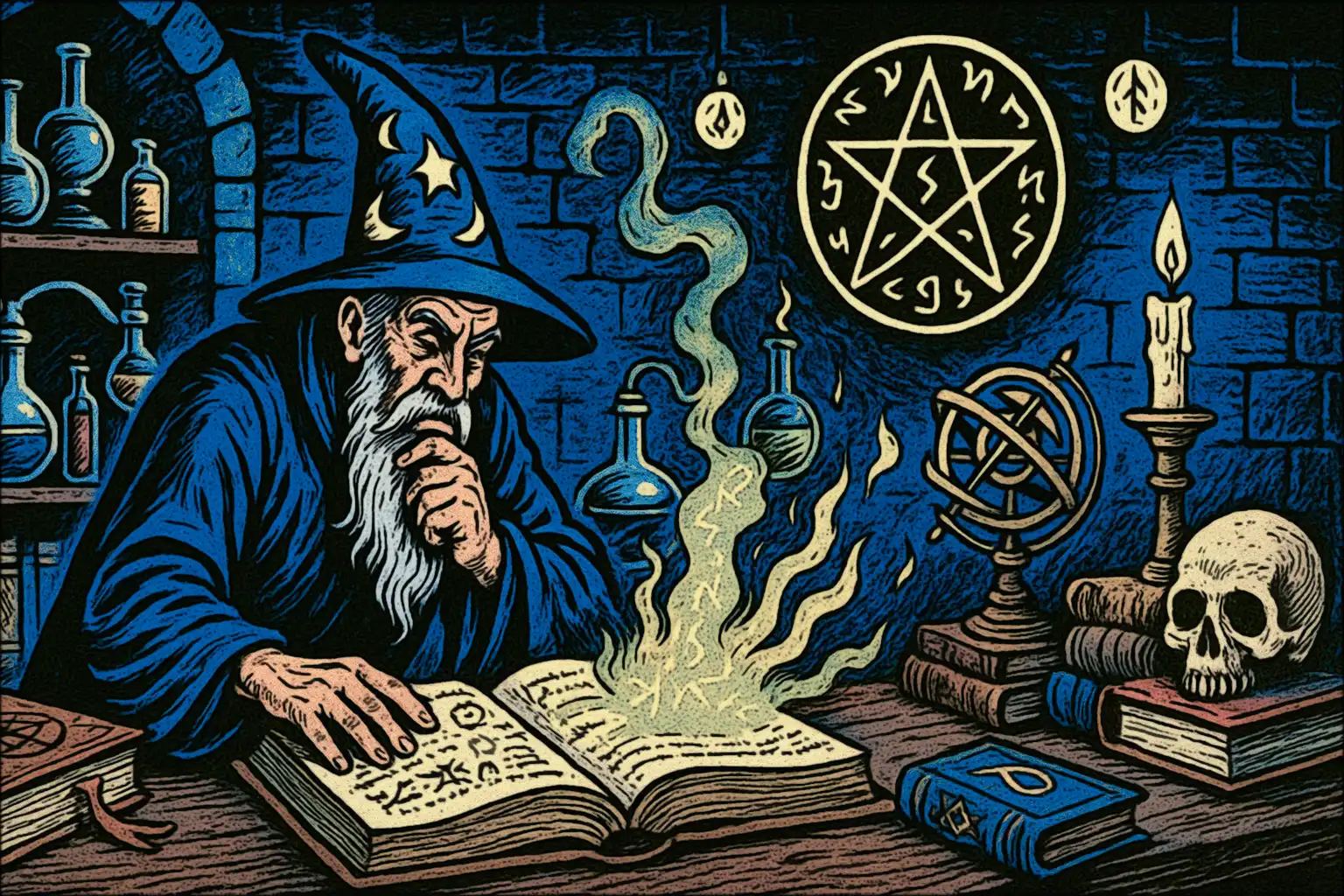
Arcane Magic: The Art of Will and Words
Arcane magic is the manipulation of raw magical energies through precise formulas, careful study, and exacting gestures. It is the magic of Mages and their specialized counterparts, the Illusionists. Wielding arcane magic requires exceptional intelligence, years of disciplined study, and meticulous preparation.
The Spellbook: The cornerstone of an arcane caster's power is their spellbook – a jealously guarded tome containing the complex formulae, diagrams, and incantations that define each spell. Without this vital resource, a mage is severely limited, able to cast only those few spells they have committed completely to memory. Spellbooks are highly personalized, reflecting their owner's magical style and understanding. Two mages might have entirely different inscriptions for the same spell, though the fundamental principles remain similar.
Components of Spellcasting: Most arcane spells require three types of components to cast successfully:
-
Verbal Components (V): Precise incantations spoken in ancient or mystical languages. A silenced mage cannot cast spells with verbal components. -
Somatic Components (S): Specific hand gestures and body movements. Wearing armor or being physically restrained prevents the precise movements required. -
Material Components (M): Physical ingredients consumed or focused through during casting. These range from common (a bit of fur for a Detect Invisibility spell) to rare and valuable (a diamond worth 5,000 gold pieces for a Resurrection spell).
Memorization: Arcane casters must prepare spells in advance through a process commonly referred to as "memorization," though scholars prefer terms like "spell preparation" or "formula fixing." Each morning (or after 8 hours of rest), the caster studies their spellbook, fixing specific spells into their mind. The number of spells they can prepare is determined by their experience level and Intelligence score. Once cast, a spell is wiped from the caster's mind and must be re-prepared before it can be cast again.
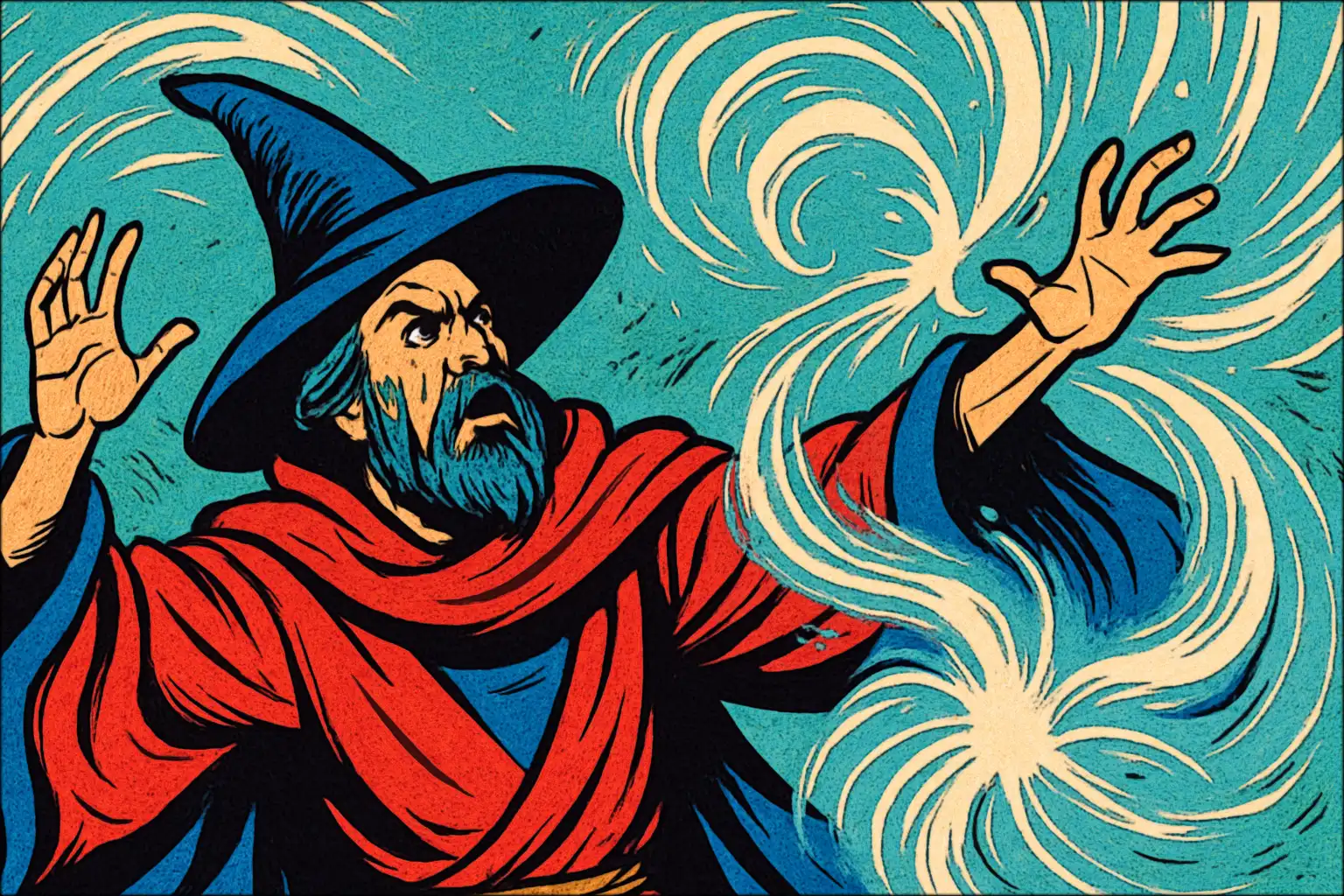
Schools of Magic: Arcane spells are categorized into distinct schools, each representing a different approach to manipulating magical energies:
-
Abjuration: Protective magic that shields, wards, or banishes. (Shield, Protection from Evil) -
Alteration (Transmutation): Magic that transforms, shapes, or alters physical properties. (Polymorph, Enlarge) -
Conjuration/Summoning: Magic that calls forth objects, creatures, or energies. (Monster Summoning, Magic Missile) -
Divination: Magic that reveals information and unveils secrets. (Identify, Detect Magic) -
Enchantment/Charm: Magic that influences minds and emotions. (Charm Person, Sleep) -
Illusion/Phantasm: Magic that deceives the senses and creates false perceptions. (Invisibility, Phantasmal Force) -
Invocation/Evocation: Magic that manipulates energy and creates powerful effects. (Fireball, Lightning Bolt) -
Necromancy: Magic that manipulates life forces, often dealing with death. (Animate Dead, Vampiric Touch)
Spell Levels: Arcane spells are categorized by their power into levels from 1 to 9. A first-level spell like Magic Missile represents a relatively simple formula, while a ninth-level spell like Wish or Time Stop represents the pinnacle of mortal spellcasting. A mage's ability to cast higher-level spells depends on their experience and intelligence, with even the most talented novice limited to first-level spells, while grandmasters of the art might command the reality-bending power of ninth-level spells.
Spell Failure: The precision required for arcane spellcasting means several factors can cause spells to fail or go awry. Being struck while casting disrupts concentration, causing the spell to fail and be lost from memory. Some spells require concentration to maintain, which can be broken by damage or significant distractions. In rare cases, attempting to cast in areas where magic is unstable or prohibited can lead to unpredictable results, from simple failure to dangerous wild magic surges.
Divine Magic: The Gift of Faith

Divine magic flows not from study and formulae but from devotion and faith. It is the magic of Clerics, Druids, and to a lesser extent, Paladins and Rangers. Unlike arcane casters who rely on their own knowledge and will, divine casters act as conduits for power granted by greater entities – deities, primordial forces, or the fundamental essence of nature itself.
Prayer and Preparation: Divine casters prepare their spells through prayer and meditation, communing with their deity or source of power. This typically requires an hour of uninterrupted devotion at a specific time (often dawn). The spells available to a divine caster are determined by their class and deity's domains, with higher-level casters gaining access to more potent divine magic. Unlike arcane casters, divine spellcasters have access to their entire spell list when preparing spells, though they must still decide which ones to prepare each day.
Spell Components: Divine spells require similar components to arcane spells (verbal, somatic, material), though the focus is often symbolic rather than consumed. Divine casters typically require a holy symbol (or druidic focus) to channel their magic effectively. Many divine spells replace material components with a Divine Focus component, represented by this holy symbol.
Favor and Disfavor: Divine casters must maintain good standing with their deity or source of power. Acting against alignment, breaking sacred oaths, or violating tenets of faith can result in temporary or permanent loss of spellcasting abilities. In extreme cases, a deity might even withdraw favor entirely, leaving the character to seek atonement or a new path. Conversely, acts of exceptional devotion or service might occasionally result in spontaneous divine intervention or temporarily enhanced spellcasting powers.
Spheres of Influence: Divine spells are organized into spheres that reflect different aspects of divine power:
-
Healing: Restoration of health and removal of afflictions. (Cure Wounds, Remove Disease) -
Protection: Wards, shields, and defensive magic. (Protection from Evil, Sanctuary) -
Combat: Divine power channeled against enemies. (Spiritual Hammer, Flame Strike) -
Divination: Divine insight and revelation. (Augury, Commune) -
Creation: Manifestation of divine substance. (Create Food and Water, Wall of Stone) -
Elemental: Command over fundamental elements. (Call Lightning, Control Weather) -
Necromantic: Control over life force and undead. (Animate Dead, Raise Dead) -
Plant: Influence over flora. (Entangle, Wall of Thorns) -
Animal: Communion with fauna. (Animal Friendship, Insect Plague)
A cleric's access to specific spheres depends largely on their deity's domains and interests. A war deity might grant abundant access to combat and protection spells but limit healing capabilities. A nature deity might emphasize elemental, plant, and animal spheres while restricting necromantic spells.
Magic in the World
The presence and perception of magic varies greatly across different realms and civilizations. In some lands, magic is commonplace, with enchanted items available in marketplaces and magical services readily accessible. In others, it is rare and mysterious, viewed with suspicion or outright fear by the general populace.
Common magical items like potions of healing, scrolls of protection, or simple enchanted tools might be available to wealthy merchants or nobles, while legendary artifacts of great power remain the stuff of myth and quest. The creation of magical items requires specific knowledge, rare materials, and considerable time and energy – making even minor enchanted objects valuable and sought-after.
Locations where magic flows strongly – nexuses of ley lines, ancient sacred groves, or sites of tremendous magical events – often exhibit unusual properties. Strange creatures may gather there, spells might be enhanced or unpredictable, and prolonged exposure can affect living beings in unpredictable ways.
| Spell Level | Mage Level Required | Example Arcane Spell | Cleric Level Required | Example Divine Spell |
|---|---|---|---|---|
| 1st | 1st | Magic Missile, Sleep | 1st | Bless, Cure Light Wounds |
| 2nd | 3rd | Invisibility, Web | 3rd | Hold Person, Silence |
| 3rd | 5th | Fireball, Fly | 5th | Create Food, Remove Curse |
| 4th | 7th | Polymorph, Dimension Door | 7th | Cure Serious Wounds, Neutralize Poison |
| 5th | 9th | Teleport, Wall of Force | 9th | Flame Strike, Commune |
| 6th | 12th | Disintegrate, True Seeing | 12th | Heal, Word of Recall |
| 7th | 14th | Power Word Stun, Teleport Without Error | 14th | Resurrection, Holy Word |
| 8th | 16th | Mind Blank, Maze | - | - |
| 9th | 18th | Wish, Time Stop | - | - |
"Magic is like fire: a tool of tremendous utility in careful hands, a raging destruction in careless ones. Respect it, study it, and never forget that there are forces in this world that respond to belief as readily as to science." - Archmage Meliamne
Chapter IV:
Combat Mechanics
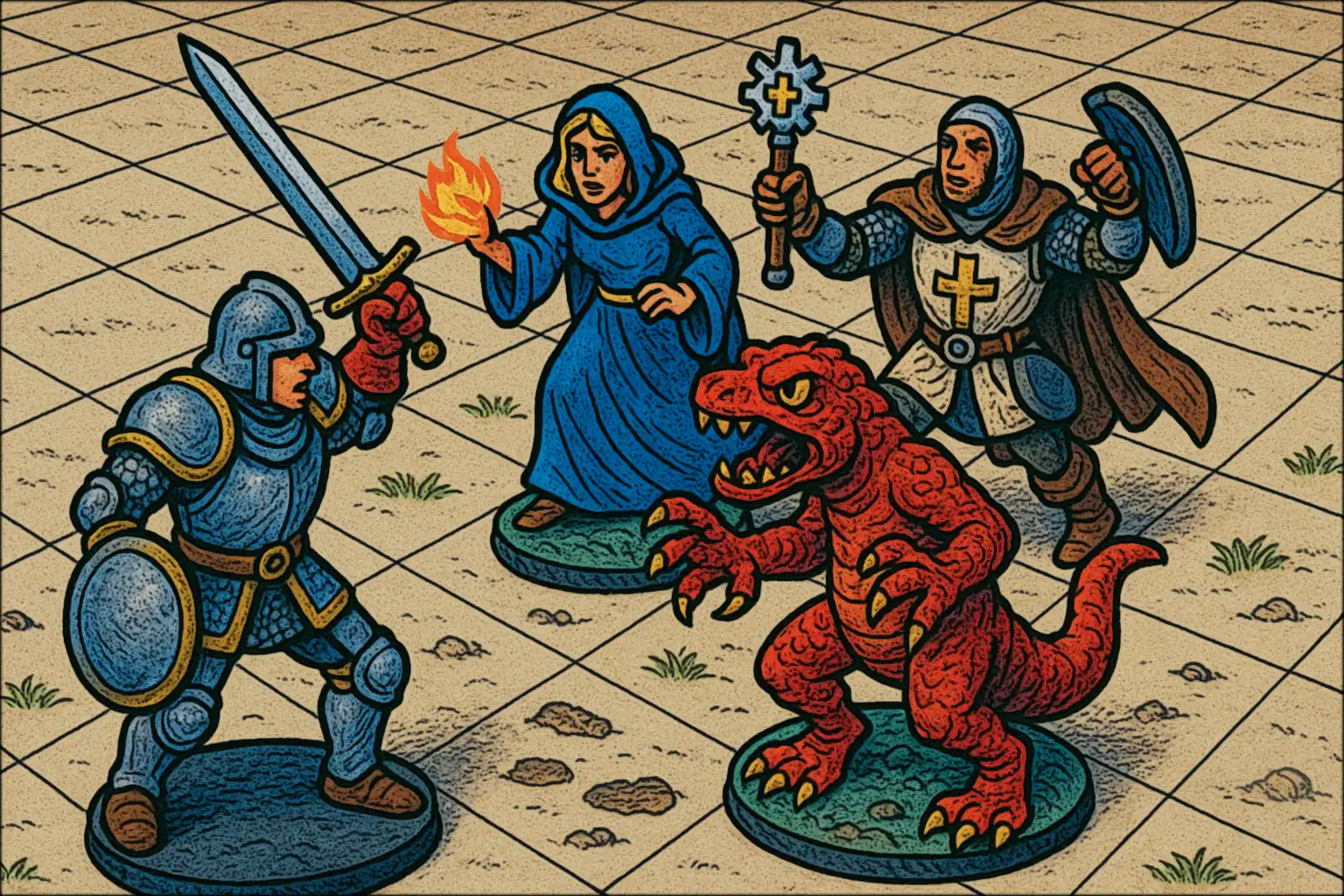
Combat in Creatures & Chronicles is a dangerous and dynamic affair, a lethal ballet resolved in a series of structured rounds where fortune favors the bold, the prepared, and the tactically astute. Each round represents a brief, intense flurry of action – perhaps six to ten seconds of game time – during which all participants have an opportunity to maneuver, attack, cast spells, or utilize skills. Victory often hinges upon careful positioning on the battlefield, wise expenditure of limited resources (like spells or arrows), canny exploitation of enemy weaknesses, a measure of luck with the polyhedral dice, and perhaps most importantly, effective teamwork and coordination within the adventuring party.
The Combat Round: Sequence of Actions
While the flow of battle can seem chaotic, it is resolved using a structured sequence to ensure fairness and clarity. A typical combat round unfolds in the following phases:
-
1. Declaration Phase (Optional but Recommended for Complex Actions): At the very start of the round, the Game Master might ask players intending to cast spells, activate complex magic items, or perform intricate maneuvers (like charging or attempting a specific combat stunt) to declare their intentions. This helps resolve situations where actions might interfere with one another (e.g., two characters attempting to move through the same narrow space, or a spell being disrupted before completion). -
2. Initiative Determination: All combatants or sides determine their order of action for the round. This crucial step dictates who acts first and can significantly influence the flow of battle. (See details below). -
3. Action Phase: Beginning with the side or individual with the lowest initiative result and proceeding in ascending order, participants take their actions. A character can typically perform a limited amount of movement (based on their race, armor, and encumbrance) and take one primary action (such as making a melee or ranged attack, casting a spell, using a class skill like Turn Undead or Find Traps, drinking a potion, activating a magic item, attempting a specific maneuver like parrying or disarming, or taking a purely defensive stance like dodging). -
4. Resolution Phase: The immediate effects of actions taken during the phase are determined – attack rolls are made, damage is calculated and applied, saving throws are rolled against spells or special attacks, conditions (like paralysis or fear) are potentially inflicted. -
5. End of Round Phase: Any effects that last for a specific duration are checked. Creatures subject to ongoing damage (like burning oil) take that damage. Morale checks might be required for NPCs or monsters who have suffered significant losses or face fearsome opponents. Once all end-of-round effects are resolved, a new combat round begins, starting again with the Declaration or Initiative phase.
From the Drillmaster's Primer: "Hesitation is death. Know thy capabilities, declare thy intent swiftly if need be, seize the initiative when fortune allows, and strike with purpose. A moment's delay can grant thy foe the killing blow."
Initiative: Determining Who Acts First
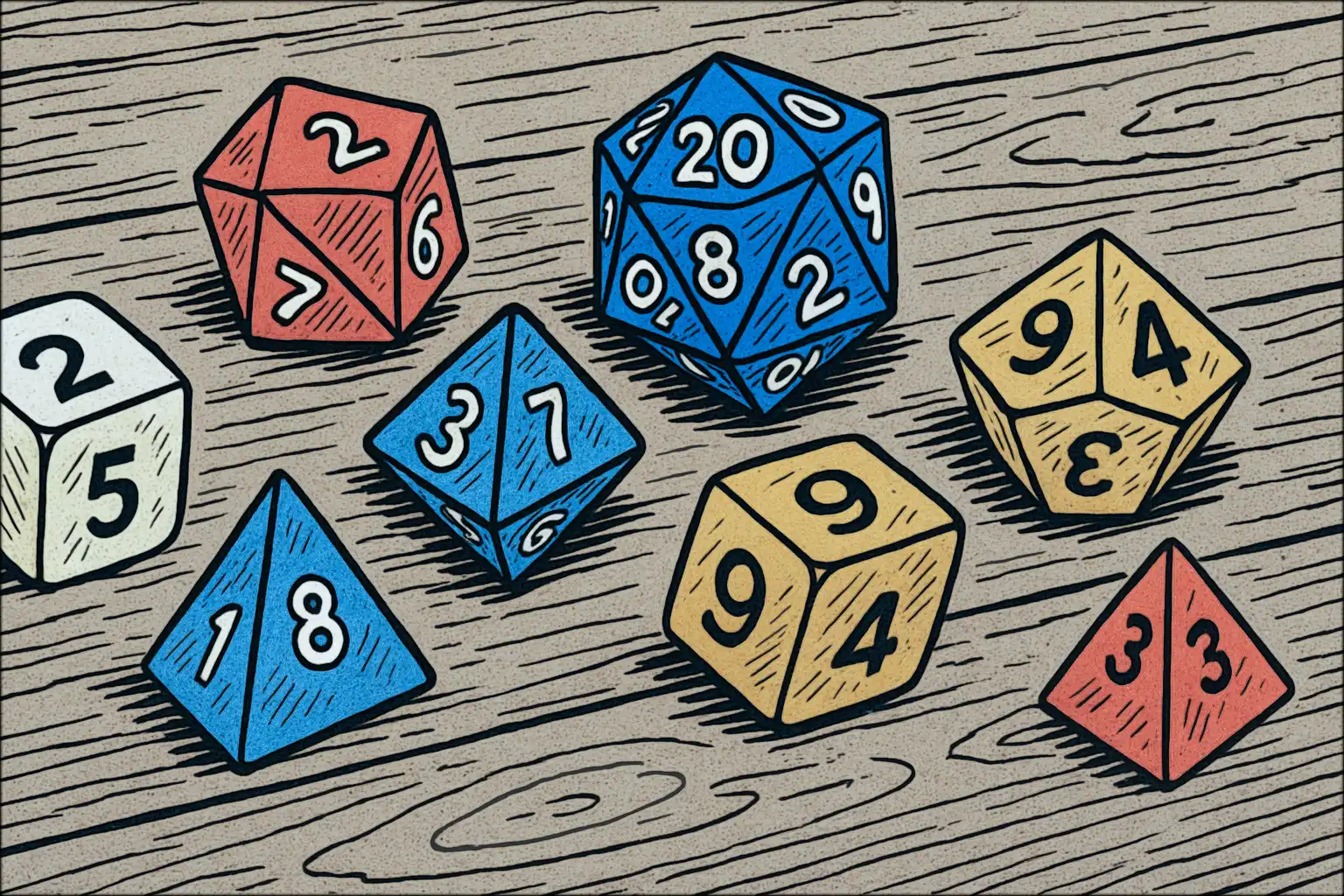
At the commencement of each combat round, initiative is rolled to establish the precise sequence of actions. Speed and reaction time are critical. Several methods exist, but a common one involves each side (players as a group, monsters as one or more groups) rolling a single die (often a d6 or d10). The side with the lower roll wins initiative and acts first during the round. Ties might be re-rolled, or determined by comparing Dexterity scores or other factors.
Individual Initiative & Modifiers: A more granular system involves each individual character and monster rolling initiative, potentially modified by various factors. Common modifiers include:
-
Dexterity Adjustments: High Dexterity often grants a bonus (subtracting from the roll, resulting in faster action), while low Dexterity may incur a penalty (adding to the roll). -
Weapon Speed Factor: Heavier, more cumbersome weapons (like Two-Handed Swords, Great Axes, Polearms, Heavy Crossbows) typically have a higher speed factor (e.g., 7-10+). This number is added to the initiative roll, making the wielder act later in the round. Lighter, quicker weapons (Daggers, Short Swords, Hand Axes) have lower speed factors (e.g., 2-4), potentially allowing earlier action. -
Armor Type: Heavy, restrictive armor (like Plate Mail) can slow reaction time, adding a penalty (e.g., +1 or +2) to the initiative roll. -
Spellcasting Time: Spells have a "casting time," often measured in segments (where a round might consist of 6 or 10 segments). A spell with a casting time of 3 segments means the caster completes the spell during the 3rd segment of the round (assuming they started at the beginning). Faster initiative allows a caster to begin sooner. If a spellcaster is struck or significantly disrupted (e.g., forced movement, loud noise nearby) before their spell's casting time is completed, they typically must make a concentration check (often based on Wisdom or Constitution) or lose the spell for that round (though the memorized slot might not be expended until completion). -
Haste & Slow Effects: Magical effects that alter speed directly impact initiative, with Haste providing a bonus and Slow imposing a penalty. -
Surprise: If one side catches the other completely unaware, they typically gain a significant initiative advantage, possibly acting before the surprised side can react at all, or even gaining a full round of actions before normal initiative is rolled. Factors influencing surprise include stealth, visibility, alertness, and detection skills.
Action resolution occurs in initiative order. If two combatants have the same initiative result, their actions might be considered simultaneous, or ties resolved by comparing Dexterity or weapon speed factors.
Attack Rolls: Striking True in the Fray
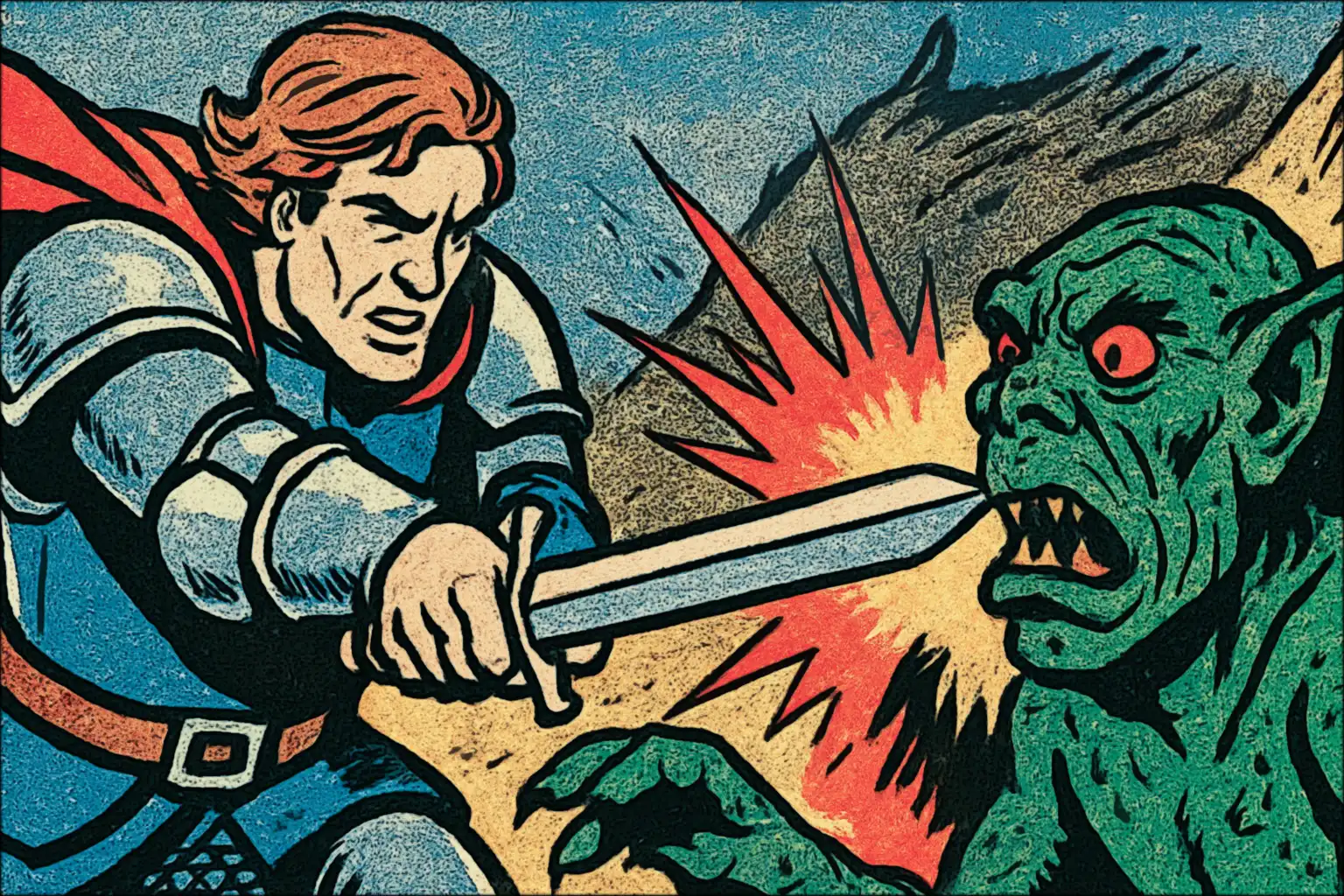
To make a physical attack, whether with a flashing blade, a crushing mace, or a swift arrow, the aggressor must determine if their strike connects effectively. This is resolved via an Attack Roll. The attacker rolls a 20-sided die (d20) and applies all relevant modifiers. If the final modified result equals or exceeds the number required to hit the target's specific Armor Class (AC), the attack is successful and damage is rolled. Failure means the blow was deflected, dodged, or simply missed.
Understanding THAC0: A common system for determining the target number is THAC0, which stands for "To Hit Armor Class 0." Each character class has a THAC0 value that improves as they gain levels (lower THAC0 is better). This number represents the result needed on the d20 roll (before most modifiers) to hit an opponent whose Armor Class is 0. To find the number needed to hit any other AC, simply subtract the target's AC from the attacker's THAC0.
Example: A 5th-level Fighter might have a THAC0 of 16. If they attack a goblin wearing leather armor (AC 8), the Fighter needs to roll 16 - 8 = 8 or higher on their d20 to hit. If attacking a heavily armored knight (AC 2), they would need 16 - 2 = 14 or higher. If attacking a magically protected foe with AC -3, they would need 16 - (-3) = 16 + 3 = 19 or higher.
Common Attack Roll Modifiers: Numerous factors can influence the chance to hit:
-
Strength Bonus/Penalty (for melee attacks): High Strength adds a bonus to hit; low Strength imposes a penalty. -
Dexterity Bonus/Penalty (for ranged attacks, and sometimes finesse-based melee): High Dexterity aids ranged accuracy; low Dexterity hinders it. -
Magical Weapon Bonuses: A "+1 Longsword" grants a +1 bonus to the attack roll. -
Range Penalties: Firing a ranged weapon beyond its optimal short range typically imposes penalties (e.g., -2 at medium range, -5 at long range). -
Cover: If the target is partially obscured (behind a low wall, tree, or another creature), the attacker suffers a penalty (e.g., -2 to -4 depending on degree of cover). -
Visibility: Poor lighting or obscuring effects (fog, darkness) impose penalties. -
Attacker/Defender Status: Attacking while prone, grappling, or suffering certain conditions usually incurs penalties. Conversely, attacking a helpless (e.g., sleeping, paralyzed) or prone defender often grants significant bonuses. -
Spells and Special Abilities: Effects like Bless (+1), Prayer (+1), Chant (+1), Haste (extra attacks), or racial bonuses (Dwarf vs. Giant) modify attack rolls.
Critical Hits and Fumbles: A natural roll of 20 on the d20 (the die shows 20 before modifiers) is typically a critical hit, often resulting in double damage, maximum possible damage, or some other significant effect determined by the GM. Conversely, a natural roll of 1 is usually a critical miss or fumble, meaning the attack fails spectacularly, potentially resulting in a dropped weapon, hitting an ally, or leaving the attacker momentarily vulnerable.
Damage, Healing, and the Brink of Death
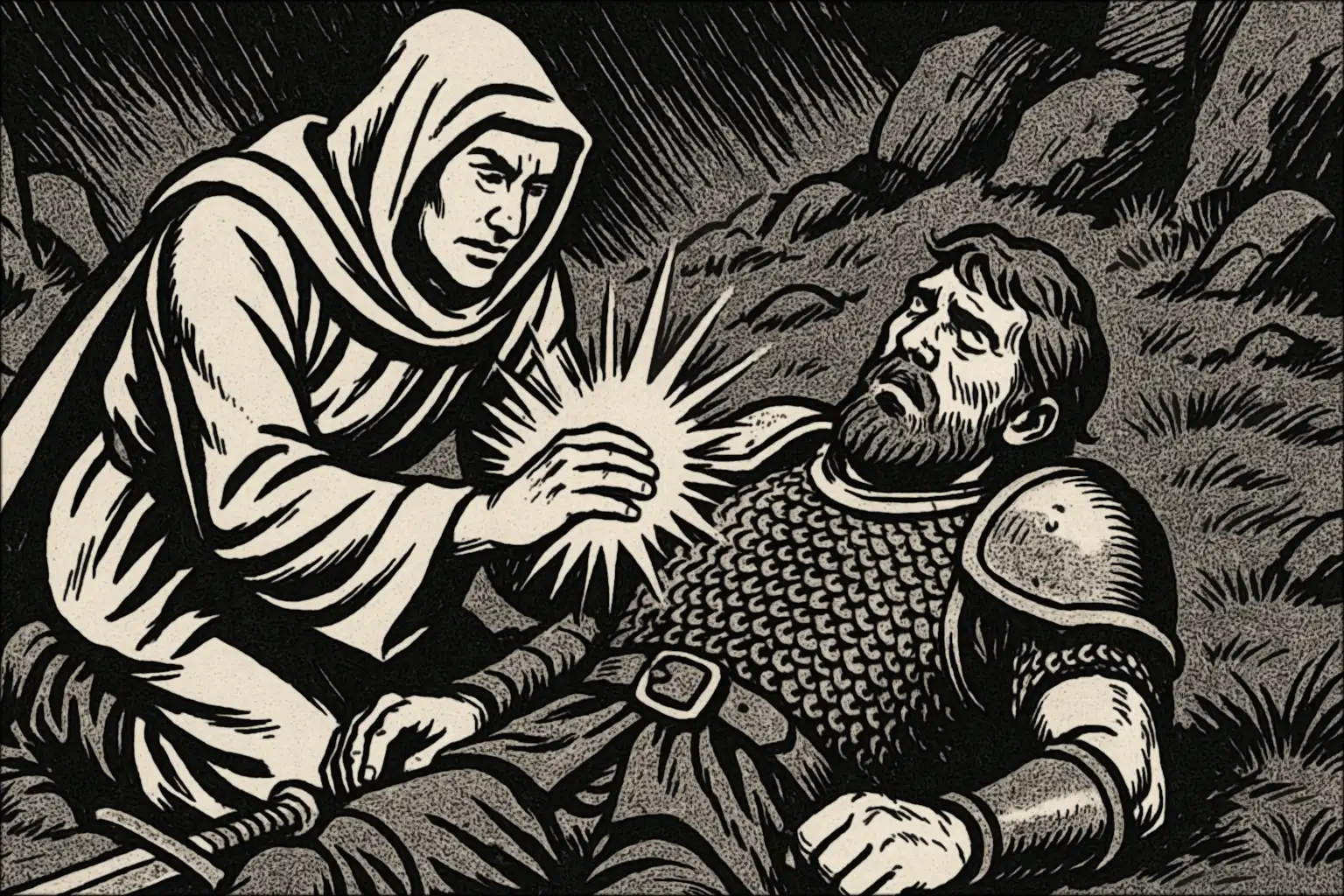
Upon confirming a successful attack, the attacker rolls the appropriate damage dice specified for their weapon or spell, adding any relevant modifiers (such as Strength bonus for most melee weapons, magical weapon bonuses, or bonuses from high-level spell effects). This total damage is subtracted from the target's current hit points (HP), which represent their ability to sustain injury and continue fighting.
Reaching Zero Hit Points: When a creature's hit points are reduced to exactly 0, they typically fall unconscious and are in a perilous state, incapacitated and unable to act. They are not yet dead, but are bleeding out or suffering from systemic shock.
Dying and Death: If a creature at 0 HP suffers further damage, their hit points drop into negative values (e.g., -1, -2, etc.). They are now actively dying. Death typically occurs when a creature reaches a specific negative hit point threshold (often -10 HP, or sometimes equal to their Constitution score in negative points). Alternatively, even if no further damage is taken, a creature at 0 HP may die from their wounds after a short period if not stabilized (often within a number of rounds equal to their Constitution score). Certain powerful effects, like disintegration spells or massive critical hits, might cause instant death regardless of hit points.
Stabilization and Healing: A dying character (negative HP) or one at 0 HP can be stabilized with successful use of a Healer's Kit, certain medical proficiencies, or magical healing. Stabilization stops further HP loss due to bleeding/shock but does not restore consciousness or hit points. Healing requires magical intervention (like Cure Wounds spells or potions of healing) or extended natural rest. Natural healing is slow; a character undertaking complete bed rest might regain only 1 hit point per full day, perhaps slightly more (1d3 HP) if under the care of someone with healing skills or in a very safe, comfortable environment. Magical healing instantly restores lost hit points but cannot typically raise a character above their normal maximum.
From the Field Surgeon's Guide: "A warrior at zero hit points is teetering on the brink. Staunch the bleeding, bind the wounds, offer a prayer or potion if ye have it, but above all, protect them from further harm. For the next blow may well be their last. Consciousness may not return until positive hit points are restored; until then, they are but fragile clay in Death's grasping hands."
Weapon Types and Damage Categories
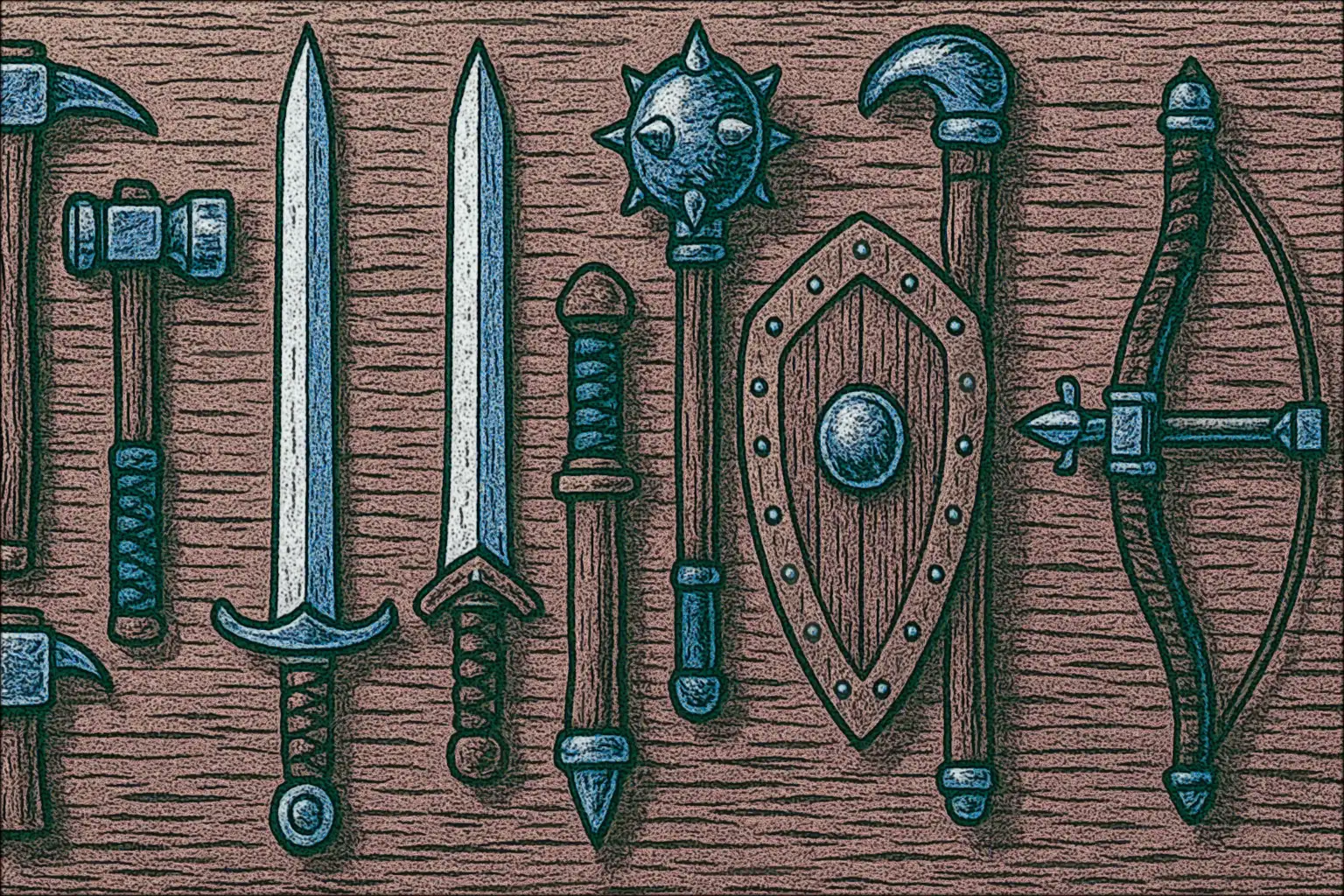
The instruments of battle are diverse, each suited to different tactical needs and governed by specific mechanical considerations. Understanding the nature of your weapon is as vital as knowing how to wield it, for in the subtle distinctions lie practical advantages that may preserve thy life in dire circumstance.
Damage Types: Weapons in Creatures & Chronicles inflict three primary types of damage, each interacting differently with various armors and creature resistances:
-
Piercing (P): Rapiers, spears, arrows, and daggers excel at penetrating defenses by concentrating force on a single point. Such weapons may find openings in certain armors (especially chain mail) but fare poorly against creatures with tough, leathery hides. Most effective against foes where precision strikes can reach vital organs. -
Slashing (S): Swords, axes, and similar edged weapons deliver devastating cutting damage. They excel against lightly armored opponents and creatures of flesh and sinew, but may glance off plate armor or hardened scales. Many warriors favor these for their versatility and battlefield presence. -
Bludgeoning (B): Maces, hammers, flails and clubs rely on concussive force rather than cutting edges. While sometimes considered crude, they excel against heavily armored foes by transferring energy through metal plates to damage the wearer beneath. Often preferred against skeletal undead, where sharp weapons find little purchase between bones.
Melee weapons typically employ Strength for both attack and damage bonuses. The raw power behind a swing directly translates to greater accuracy (finding gaps in defense) and impact force. For every point of Strength above 15, characters gain cumulative bonuses (+1 at 16, +2 at 17, etc.) to their damage rolls.
Multi-Classed Characters: When a character possesses levels in multiple warrior classes (Fighter/Thief, Fighter/Mage), they retain the better THAC0 progression, allowing them to maintain combat effectiveness despite dividing their training.
Critical Hits and Backstab: When rolling a natural 20 on an attack roll, a critical hit occurs. This doubles the damage dice rolled (e.g., a longsword normally dealing 1d8 damage would roll 2d8), before adding any damage modifiers. The Thief's backstab ability functions similarly but with greater potency, using an escalating multiplier based on the Thief's level (2x at levels 1-4, 3x at levels 5-8, 4x at levels 9-12, 5x at levels 13-16, etc.).
Armor Class and Defensive Considerations

Unlike simpler combat systems that treat Armor Class as a singular value, Creatures & Chronicles recognizes that different armors protect differently against various attack types. This nuanced approach better reflects the realities of armed conflict and creates tactical depth in combat encounters.
Differentiated Protection: Most characters have three distinct Armor Class values:
-
AC vs. Piercing (acPierce): Representing defense against stabbing weapons and arrows. -
AC vs. Slashing (acSlash): Defense against cutting and chopping weapons. -
AC vs. Bludgeoning (acBludgeon): Protection from crushing and impact damage.
Within this system, chain mail excels at protecting against slashing attacks but is less effective against piercing strikes that might slip between the links. Conversely, plate armor provides superior all-around protection but is particularly effective against piercing attacks that struggle to penetrate solid metal plates.
The Defensive Value of Dexterity: A character's natural agility, represented by their Dexterity score, improves Armor Class by making them harder to hit. This bonus applies to all three AC types:Dexterity 15: -1 bonus to AC (improving AC 5 to AC 4)Dexterity 16: -2 bonus to ACDexterity 17: -3 bonus to ACDexterity 18: -4 bonus to AC
Magical Protection: Spells like Shield, Barkskin, and Armor enhance AC through arcane or divine means. Potent protective magic can temporarily improve Armor Class to negative values (e.g., AC -2), representing extraordinary protection where only the most precisely aimed strikes from skilled attackers have any chance of connecting.
| Armor Type | AC vs. Slash | AC vs. Pierce | AC vs. Bludgeon | Weight (lbs) |
|---|---|---|---|---|
| Leather Armor | 8 | 8 | 7 | 15 |
| Studded Leather | 7 | 7 | 6 | 25 |
| Chain Mail | 5 | 5 | 6 | 40 |
| Scale Mail | 6 | 4 | 5 | 45 |
| Plate Mail | 4 | 3 | 3 | 50 |
| Full Plate | 2 | 1 | 2 | 65 |
Saving Throws: Resisting Peril Beyond the Blade
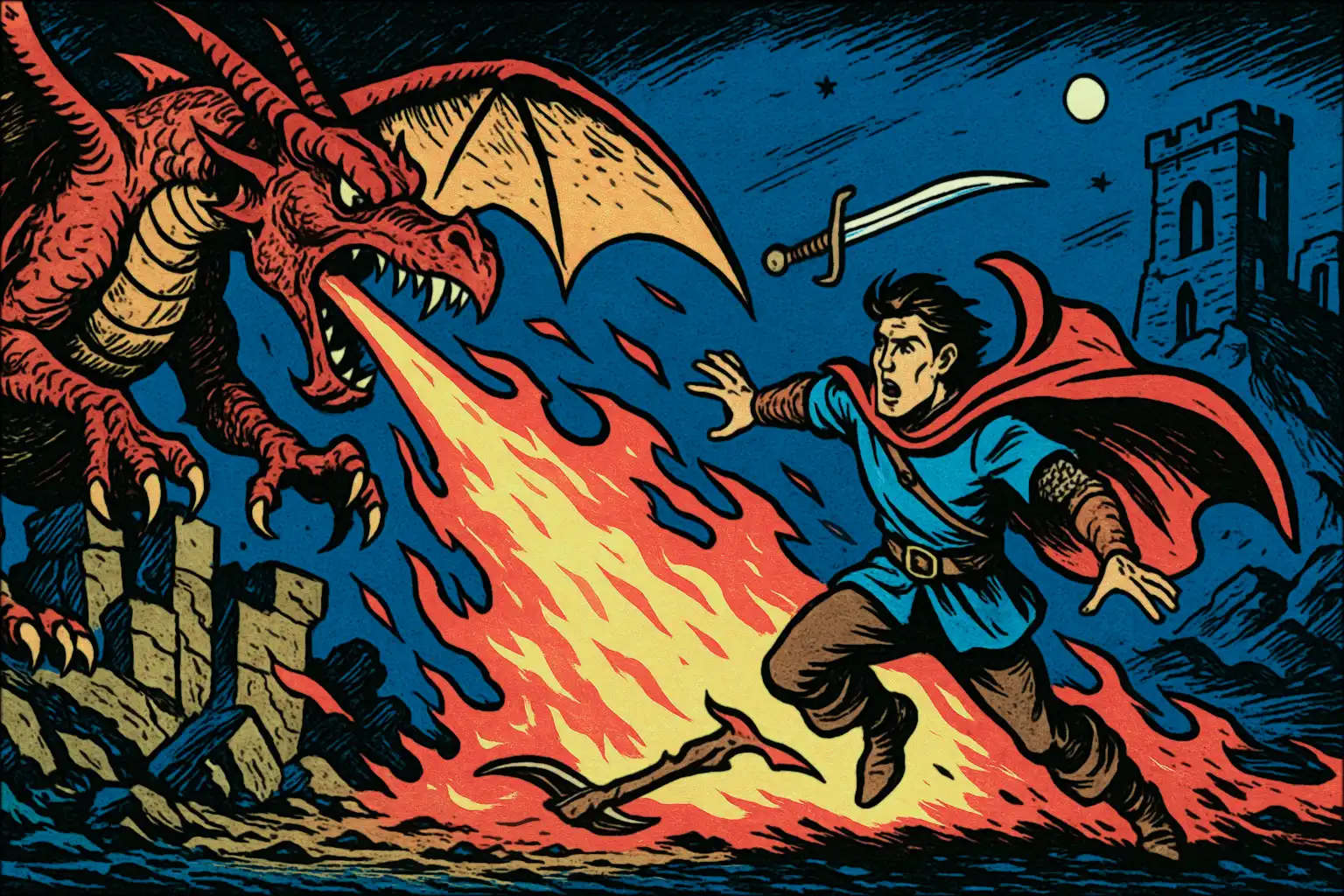
Not all threats in the adventuring world come from sharpened steel or crushing blows. Often, characters will be subjected to effects that bypass normal armor and defenses – insidious poisons, paralyzing gazes, reality-warping spells, searing dragon breath, or the sudden activation of ancient magical traps. In such cases, they are often allowed a final chance to resist or mitigate the effect through sheer luck, fortitude, or quick reflexes – a Saving Throw. This typically involves rolling a d20 and attempting to achieve a target number (or higher). This target number varies based on the character's class and level, and sometimes the nature of the specific threat.
Common Categories of Saving Throws: Characters generally have different levels of resistance against various types of threats. These are often grouped into categories:
-
Vs. Poison or Death Magic: Resisting lethal toxins, negative energy effects, and spells or abilities that cause instant death. -
Vs. Petrification or Polymorph: Avoiding effects that turn flesh to stone (like a basilisk's gaze) or unnaturally alter one's form. -
Vs. Rod, Staff, or Wand: Resisting targeted magical effects channeled through these common magic items. -
Vs. Breath Weapon: Attempting to dodge or endure the area-of-effect onslaught of a dragon's breath (fire, acid, lightning, cold, gas). -
Vs. Spells: A general category for resisting the myriad direct effects of arcane or divine spells (like Charm Person, Hold Person, Fireball, Lightning Bolt, etc.).
Success and Failure: A successful saving throw often negates the harmful effect entirely (e.g., completely avoiding paralysis from a ghoul's touch, suffering no effect from a Charm Person spell). In other cases, particularly against damaging area effects like Fireball or dragon breath, a successful save typically means the character takes only half the rolled damage. Failure means the character suffers the full brunt of the effect. Target saving throw numbers generally improve (get lower) as a character gains levels, reflecting their increased resilience and experience. Modifiers from magical items (like a Ring of Protection or Cloak of Resistance), high attribute scores (Constitution often aids vs. Poison, Wisdom vs. mental effects), racial traits (Dwarves and Halflings vs. Magic/Poison, Elves vs. Charm), or protective spells can grant crucial bonuses to these vital rolls.
Chapter V:
Skills and Proficiencies
Beyond combat and spellcasting, characters possess various skills that help them navigate the challenges of adventure. These are represented by weapon proficiencies and non-weapon proficiencies.
Weapon Proficiencies: The Art of Martial Discipline

The clang of steel, the thrum of a bowstring, the whistling arc of a well-thrown axe – these are the sounds of survival and conquest in a world fraught with peril. Weapon proficiency is not merely a familiarity with an instrument of war; it is a deep understanding of its balance, its reach, its strengths, and its limitations, honed through dedicated practice and the harsh lessons of actual combat. To wield a weapon proficiently is to make it an extension of one's will, a deadly tool guided by skill and precision.
Gaining Proficiency: Upon embarking on their path, each adventurer is granted a number of weapon proficiency "slots," a measure of their initial martial training. The number of these initial slots is dictated by their chosen class, reflecting the emphasis placed on martial skill within that calling. For instance, a Fighter, whose very essence is defined by combat, begins with a generous allotment (typically four slots), allowing for mastery in several weapons or early specialization in one. A Mage, whose focus lies in arcane study, might begin with only a single slot, usually dedicated to a simple defensive weapon like a quarterstaff or dagger. As characters advance in level, they often gain additional proficiency slots (perhaps one every three or four levels, depending on class), allowing them to broaden their arsenal or deepen their mastery of existing arms.
The Burden of Inexperience: To take up a weapon with which one lacks proficiency is a dangerous gamble. Such an attempt is marked by awkwardness, inefficiency, and a greatly increased risk of failure. The rules of engagement are unforgiving:
Warrior Classes (Fighters, Paladins, Rangers): When wielding a weapon in which they are not proficient, these martial characters suffer a significant penalty to their attack rolls (commonly -2 to -3). This reflects their baseline combat training being misapplied to an unfamiliar arm.Other Classes (Clerics, Thieves, Mages, etc.): For those whose primary training lies outside the battlefield, the penalty for using a non-proficient weapon is even more severe (often -4 to -5 to attack rolls). Their unfamiliarity can turn a deadly weapon into a clumsy encumbrance.
The Path of the Fighter: Weapon SpecializationWhile all classes can learn to use various weapons, the Fighter walks a path of martial devotion that allows for a level of mastery unattainable by others: Weapon Specialization. This is a significant commitment, requiring the Fighter to dedicate extra proficiency slots (typically two initial slots, or one previously acquired slot plus a new one) to a single, specific weapon type (e.g., Longsword, Battle Axe, Longbow).
The rewards for such dedication are substantial:
Enhanced Accuracy: The Fighter gains a +1 bonus to all attack rolls made with their specialized weapon.Increased Damage: They inflict an additional +2 points of damage with every successful strike from their specialized weapon.Superior Rate of Fire: As their mastery deepens with experience, Specialized Fighters can attack more frequently with their chosen weapon than other warriors. For example, around 7th level, they might achieve 3 attacks every 2 rounds (instead of 1/1), and by 13th level, this could increase to 2 full attacks per round.
This focused training transforms the Fighter from a mere combatant into a veritable weapon master, their chosen instrument a deadly extension of their being. While a Fighter might specialize in more than one weapon over a long career (if they gain enough proficiency slots), the initial commitment to a single form often defines their combat style and reputation. No other class can achieve this level of focused martial devastation with a single weapon type.
Non-Weapon Proficiencies: The Tapestry of Learned Abilities
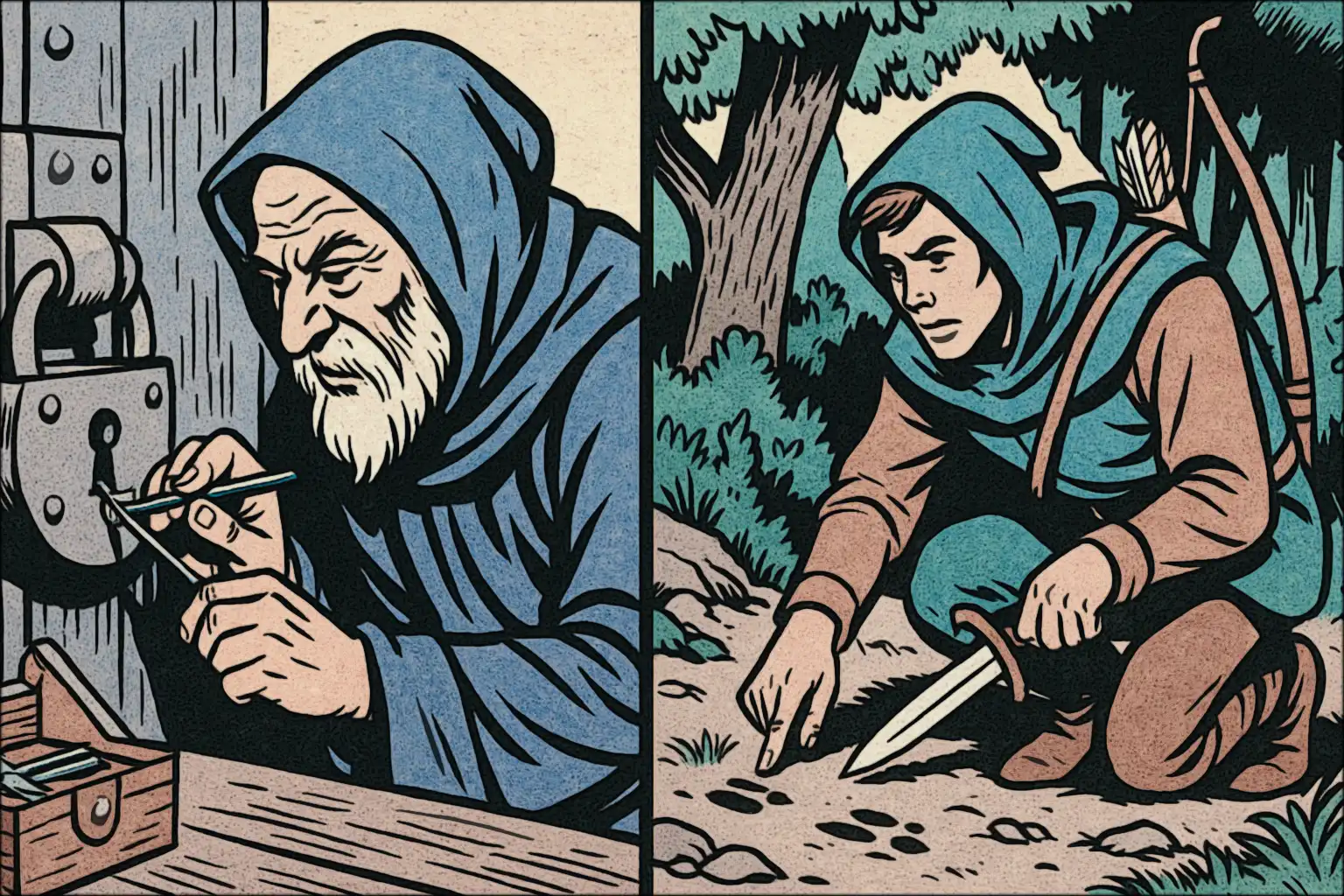
Beyond the clash of arms and the incantations of the arcane, the world of Creatures & Chronicles is rich with myriad challenges that demand a different kind of expertise. Non-Weapon Proficiencies represent a vast array of specialized skills, esoteric knowledge, practical crafts, and innate talents that an adventurer might acquire through rigorous training, dedicated study, inherited aptitude, or the hard-won lessons of experience. These abilities are the threads that weave the intricate tapestry of a character's capabilities, allowing them to interact with the world in meaningful ways far beyond the battlefield.
Whether it is the ability to track a fearsome beast through the wilderness, decipher an ancient script, navigate by the stars, craft essential goods, or persuade a recalcitrant official, these proficiencies define what a character can *do*. They are the hallmarks of seasoned adventurers who are more than just their sword arm or their spellbook; they are resourceful individuals capable of overcoming diverse obstacles with cunning, knowledge, and practiced skill.
Acquiring and Utilizing Proficiencies
Gaining Proficiency Slots: At the dawn of their adventuring career, characters are endowed with a number of Non-Weapon Proficiency "slots." This initial endowment is primarily determined by their chosen class, reflecting the typical breadth of skills associated with that archetype. For instance, a Rogue, reliant on a wide range of subtle talents, or a Priest, often a repository of lore and practical knowledge, might begin with more slots than a single-minded warrior. Furthermore, a character's inherent intellect often plays a role, with those of keener minds (represented by a high Intelligence score) sometimes granted additional slots to represent their greater capacity for learning diverse skills. As characters gain experience and advance in levels, they will typically be awarded further proficiency slots, allowing them to deepen existing knowledge or branch out into new areas of expertise. The exact rate of gain often varies by class, with some (like Rogues) learning new skills more rapidly than others.
Choosing Proficiencies: Each proficiency has an associated "slot cost" (usually one or two slots, though some very specialized or powerful skills might cost more), representing the time and effort required to attain it. When a character has slots available, they may choose from a wide array of proficiencies, though some may be restricted to certain classes (a Warrior is unlikely to learn Spellcraft, for example, while proficiency in Armorer might be beyond a Mage). The selection of proficiencies is a crucial part of defining a character's unique capabilities and their role within an adventuring party.
The Role of Ability Scores & Proficiency Checks: Most Non-Weapon Proficiencies are linked to one of the character's six core ability scores (Strength, Dexterity, Constitution, Intelligence, Wisdom, or Charisma). This associated ability score reflects the primary attribute that underpins the skill. When a character attempts to use a proficiency in a challenging or uncertain situation, the Dungeon Master may call for a "Proficiency Check." This typically involves rolling a 20-sided die (d20) and aiming to roll equal to or *under* the relevant ability score. Some proficiencies may have a modifier (e.g., +1, -2) which is applied to the ability score before the check, making the skill easier or harder to succeed with. A successful check means the character has skillfully applied their knowledge or talent. Failure might mean no result, a partial success, or occasionally, a misinterpretation or minor mishap, depending on the situation and the skill in question.
The Unskilled Attempt: Attempting a task for which one lacks the relevant proficiency is not always impossible, but it is invariably more difficult and prone to failure. The DM might allow an attempt based purely on an ability score, often with a significant penalty, or declare the task too specialized to be attempted without the proper training.
A Glimpse into the Diverse World of Skills
The range of Non-Weapon Proficiencies is vast, covering nearly every facet of endeavor imaginable. What follows is an overview of many common (and some uncommon) skills that adventurers might learn. Note that each proficiency often carries with it a depth of knowledge and application far beyond a simple title. The descriptions provided offer a starting point for understanding their utility and the kinds of challenges they can help overcome.
Agriculture
Slots: 1; Ability: Intelligence; Modifier: +0; Classes: GeneralThis proficiency imparts a practical understanding of the farmer's craft. A character skilled in Agriculture knows the cycles of planting and harvest, methods for storing crops to prevent spoilage, the basics of animal husbandry (tending to livestock, assisting with births), and even rudimentary butchering techniques. While not the most glamorous of skills, it can be invaluable for survival in settled lands, for establishing a stronghold, or when trying to win the trust of rural communities. A successful check might allow a character to identify blighted crops, assess the health of livestock, or determine the best time to plant in an unfamiliar region.
Ancient History
Slots: 1; Ability: Intelligence; Modifier: -1; Classes: Priest, Rogue, MageThe world is littered with the remnants of civilizations long crumbled to dust, their secrets and sorrows buried beneath the weight of ages. A character proficient in Ancient History possesses knowledge of these bygone eras – their major empires, legendary figures, significant conflicts, and perhaps even whispers of their lost magic or technology. This skill allows for the identification of ancient artifacts, the interpretation of obscure iconography, and a general understanding of the historical context of ancient ruins or dungeons. The -1 modifier reflects the often fragmented and cryptic nature of such knowledge. (Note: The original description for this skill in the data file appears to be a duplicate of Agriculture; the description here is a more typical interpretation of Ancient History.)
Animal Handling
Slots: 1; Ability: Wisdom; Modifier: -1; Classes: GeneralThis skill grants an improved ability to manage and control domesticated animals, particularly pack animals (mules, horses, oxen) and other beasts of burden. A character with Animal Handling can more easily calm a spooked mount, coax a stubborn animal to move, or secure loads effectively. A successful proficiency check might allow a character to quiet an agitated animal that would otherwise bolt or refuse to cooperate. Those without this proficiency often find such creatures exasperatingly difficult to manage, succeeding only on a fortunate whim (perhaps a 20% chance, at the DM's discretion).
Animal Lore
Slots: 1; Ability: Intelligence; Modifier: +0; Classes: WarriorMore than just handling, Animal Lore is the understanding of wild creatures in their natural habitats. A proficient character can interpret animal behaviors – recognizing signs of hunger, territoriality, mating displays, or the presence of young. Such observations can reveal nearby water sources, the presence of game, the passage of predators, or even impending natural dangers like fires or earthquakes. The character can also attempt to imitate animal calls with surprising accuracy; a successful check means the imitation is convincing enough to fool animals (and most humanoids not intimately familiar with the specific creature), potentially luring them closer or frightening them away. This skill also grants an edge in setting snares or traps for hunting, as the character better understands the habits of their quarry. The DM makes proficiency checks for observation secretly, as a misinterpretation (a failure by 5 or more) can lead to dangerously incorrect assumptions.
Animal Training
Slots: 1; Ability: Wisdom; Modifier: +0; Classes: GeneralThis demanding proficiency allows a character to train a specific type of creature (chosen when the proficiency is taken) to obey commands and perform tricks. Common choices include dogs, horses, falcons, or even more exotic beasts with animal-level intelligence (though these are more challenging). A trainer can work with up to three creatures simultaneously. Training for a general task (e.g., "guard and attack," "carry rider," "hunt") takes three months of dedicated work. Teaching a specific trick (e.g., "fetch that object," "attack that specific person") requires 2d6 weeks. At the end of the training period, a proficiency check determines success; failure means the animal is untrainable in that specific task by that trainer. An animal can typically learn 2d4 tasks or tricks. This skill also allows for the taming of young, wild animals, a month-long process requiring a successful check to make them suitable for later training.
Appraising
Slots: 1; Ability: Intelligence; Modifier: +0; Classes: RogueA keen eye for value is essential for those who deal in treasure and finery. The Appraising proficiency allows a character to estimate the monetary worth and authenticity of items like antiques, artwork, jewelry, and gemstones. The item must be examined firsthand. A successful check (made secretly by the DM) provides an accurate estimate (e.g., to the nearest 100 or 1000 gold pieces, depending on value) and can identify fakes. A failed check yields no useful estimate. A roll of 20 on the die signifies a disastrous misjudgment of value, always to the character's detriment (e.g., vastly overvaluing a worthless trinket or undervaluing a priceless artifact).
Armorer
Slots: 2; Ability: Intelligence; Modifier: -2; Classes: WarriorWith the proper materials, tools, and a suitable forge, a character proficient as an Armorer can craft any type of armor described in the Player's Handbook. The time required is considerable: two weeks of work *per point of Armor Class* the armor provides below AC 10 (e.g., a shield, AC 9, takes two weeks; full plate, AC 1, takes eighteen weeks). Upon completion, a proficiency check is made. Success yields serviceable armor. Failure by 4 or less results in flawed armor that is 1 AC point worse than intended (though it looks correct) and may break if struck by a critical hit (natural 19 or 20), immediately worsening the wearer's AC by an additional 4 points and hampering movement until removed (1d4 rounds). For precisely fitted armors like field plate or full plate, the intended wearer must be available for fittings at least weekly.
Artistic Ability
Slots: 1; Ability: Wisdom; Modifier: +0; Classes: GeneralThis proficiency reflects a natural talent in a chosen form of art, such as painting, sculpture, musical composition, poetry, or another approved medium. The character possesses an inherent understanding of aesthetics like color, form, rhythm, and tone. While a check isn't always necessary to simply create, one can be made to determine the quality of a work. A natural 1 on the check might indicate a masterpiece of lasting value, while a significant failure could result in something uninspired or even jarringly bad. This innate talent also grants a +1 bonus to proficiency checks related to specific artistic performances (like playing an instrument if also proficient) and to Appraising checks for objects of art.
Astrology
Slots: 2; Ability: Intelligence; Modifier: +0; Classes: Priest, MageThe celestial bodies are believed by many to hold sway over the fates of mortals. An Astrologer can study the stars and planetary conjunctions, and by knowing an individual's precise birth date and time, attempt to forecast vague omens or general trends for their immediate future (typically the next 30 days). This requires careful observation and calculation. A successful proficiency check might reveal a general event – a coming conflict, a fateful meeting, a period of good fortune or ill. The DM determines the nature of the portent, often tying it into upcoming adventures. A failed check yields no insight, while a natural 20 results in a wildly inaccurate or misleading prediction. Due to the narrative implications, DMs may require this proficiency to be used at the end of a session to allow time for preparation. Knowledge of Astrology also grants a +1 bonus to Navigation checks when the stars are visible.
Blacksmithing
Slots: 1; Ability: Strength; Modifier: +0; Classes: GeneralThe rhythmic clang of hammer on anvil is the song of the Blacksmith, a shaper of raw iron into tools of utility and implements of survival. This proficiency grants the ability to work a forge, manage a coal-fed fire with bellows, and craft a variety of iron objects. While the specialized arts of weaponsmithing and armoring are separate (and more demanding) proficiencies, a Blacksmith can produce essential items such as crowbars, grappling hooks, horseshoes, nails, hinges, plowshares, and other common iron goods. This skill is vital for repairing damaged metal gear, fortifying structures, or creating custom tools needed for an adventure.
Blind-fighting
Slots: 2; Ability: (Special); Modifier: N/A; Classes: Rogue, WarriorSome warriors and rogues hone their senses to an almost preternatural degree, learning to fight effectively even when their sight is obscured by magical darkness, dense fog, or the gloom of a lightless dungeon. This demanding proficiency (costing two slots) significantly mitigates the penalties for fighting in poor or no visibility. In total darkness, a character with Blind-fighting suffers only a -2 penalty to attack rolls (instead of the usual -4). In dim light like starlight or moonlight, this penalty is reduced to just -1. Importantly, the character suffers no Armor Class penalties due to darkness against foes within melee reach. Furthermore, special abilities normally reliant on sight (like a thief's backstab, if the DM rules it relies on visual targeting) might still be usable, perhaps at reduced effectiveness or requiring a successful check. This skill is primarily for close-quarters combat; it offers no special protection against missile fire or threats outside immediate melee range. Movement in darkness is also less hampered. Against invisible foes, the attack penalty is reduced to -2, though the character still cannot pinpoint their exact location without other means.
Bowyer/Fletcher
Slots: 1; Ability: Dexterity; Modifier: -1; Classes: WarriorThe art of crafting bows and arrows is a patient and precise skill. A character proficient as a Bowyer/Fletcher can construct various types of bows (long, short, composite) and fletch arrows. While metal arrowheads typically require a Weaponsmith, all other components fall under this purview. Crafting a long or short bow takes about a week; composite bows, with their complex laminations, might take two. A skilled Fletcher can produce roughly 1d6 arrows per day. Upon completion, a proficiency check determines the quality. Success yields a durable, reliable weapon. Failure means the item has a limited lifespan: arrows might break on the first shot, and bows might snap if the user rolls a natural 1 on an attack. Some DMs might allow an optional rule: if a player opts for a higher risk, a failed check renders the item useless, but a natural 1 on a successful check might create a masterwork bow of exceptional range or quality, perhaps even suitable for later enchantment.
Brewing
Slots: 1; Ability: Intelligence; Modifier: +0; Classes: GeneralThe transformation of simple grains and herbs into hearty ales, potent meads, or fine wines is a skill valued in taverns and monasteries alike. A character with the Brewing proficiency understands the alchemy of fermentation. They can develop recipes, select quality ingredients, set up and manage the brewing process (controlling temperature and timing), and properly age the finished product. This skill can provide a source of income, a way to curry favor, or simply ensure the adventuring party never lacks for good cheer (or a potent brew to share with potential informants).
Carpentry
Slots: 1; Ability: Strength; Modifier: +0; Classes: GeneralFrom humble stools to sturdy stockades, the work of a Carpenter shapes the wooden structures of the world. This proficiency allows a character, given the appropriate tools and materials (lumber, nails, saws, etc.), to construct and repair simple wooden items and structures. This includes furniture like cabinets, chairs, and tables, but also more complex items like small boats, chests, wheels, and even sections of wooden fortifications. In a pinch, a skilled carpenter might improvise shelter, reinforce a door, or build a crude raft.
Charioteering
Slots: 1; Ability: Dexterity; Modifier: +2; Classes: WarriorGuiding a team of galloping beasts while balancing on a bouncing, two-wheeled platform is a skill demanding courage, balance, and a firm hand. Proficiency in Charioteering allows a character to manage a chariot with considerable expertise – driving at full speed, executing sharp turns, and urging their team to sudden bursts of effort. While driving, a proficient charioteer can even make attacks, albeit with a -2 penalty to their attack roll (in addition to any other applicable modifiers for ranged attacks or difficult maneuvers). This skill is rare but can be decisive in specific martial cultures or grand arena battles.
Cobbling
Slots: 1; Ability: Dexterity; Modifier: +0; Classes: GeneralA good pair of boots can be an adventurer's best friend, and the Cobbler is the master of their creation and repair. This proficiency covers the making and mending of shoes, boots, and sandals. The character understands how to select and prepare leather, measure and fit footwear for comfort and durability, and use the specialized tools of the cobbler's trade (awls, knives, hammers, lasts). In a world where adventurers spend countless hours on their feet, the ability to repair or reinforce footwear can be a significant boon.
Cooking
Slots: 1; Ability: Intelligence; Modifier: +0; Classes: GeneralThe difference between a nourishing, morale-boosting meal and a charred, unpalatable mess often lies in the skill of the cook. A character proficient in Cooking can prepare tasty and wholesome meals even from basic or foraged ingredients. While a proficiency check isn't needed for simple fare, it might be required when attempting to create a truly magnificent feast for a noble, to stretch meager rations to feed many, or when forced to work with unusual or substandard ingredients (like trying to make goblin jerky palatable). Good cooking can lift spirits, aid recovery, and even be a diplomatic tool.
Dancing
Slots: 1; Ability: Dexterity; Modifier: +0; Classes: GeneralFrom the graceful etiquette of a royal ballroom to the boisterous jigs of a country festival, proficiency in Dancing allows a character to move with poise and rhythm. A skilled dancer is familiar with a variety of styles, can learn new dances quickly, and may even be able to teach basic steps to others. While often a social grace, dancing can sometimes play a role in rituals, performances that might earn coin or favor, or even in situations requiring agility and coordination (at the DM's discretion, perhaps a check to navigate a crowded room or a floor of shifting tiles).
Direction Sense
Slots: 1; Ability: Wisdom; Modifier: +1; Classes: GeneralSome individuals possess an almost uncanny internal compass. Characters with Direction Sense have an innate awareness of which way is north, a subtle but constant guide as long as they are on their native Prime Material Plane. This doesn't prevent them from getting lost in a maze or a magically disorienting landscape, but it provides a fundamental bearing that can be invaluable when maps are scarce or misleading. The +1 modifier to their Wisdom score for checks related to this proficiency underscores its intuitive nature.
Disguise
Slots: 1; Ability: Charisma; Modifier: -1; Classes: RogueThe art of becoming someone else – or at least, appearing to be – is a vital tool for spies, infiltrators, and those who prefer to operate from the shadows. Proficiency in Disguise allows a character to alter their appearance through the clever application of makeup, hair dyes, padding, prosthetics, and appropriate costuming. A successful disguise, which can take 1d3 hours to prepare, can change perceived age, skin tone, facial features, and even allow for the convincing imitation of an accent (if the character has heard it). The success of a disguise is often contested by the Perception or Insight of those observing, and the -1 modifier reflects the inherent difficulty of completely fooling astute onlookers.
Endurance
Slots: 2; Ability: Constitution; Modifier: N/A (provides direct benefits); Classes: WarriorThe life of an adventurer is one of constant physical exertion – long marches, strenuous climbs, and desperate battles. The Endurance proficiency, typically costing two slots, allows a warrior to push their body beyond normal limits. A character with this skill can engage in a forced march for a full day without suffering the usual penalties for exhaustion. Furthermore, they gain a robust +2 bonus to all Constitution checks related to resisting physical stress, fatigue, or privation (such as holding one's breath, staving off the effects of extreme weather, or resisting non-magical diseases that test physical resilience).
Engineering
Slots: 2; Ability: Intelligence; Modifier: -3; Classes: Priest, MageThe design and construction of complex structures and machines, from mighty siege engines to intricate canal locks, falls under the purview of Engineering. This intellectually demanding proficiency (costing two slots and carrying a -3 modifier due to its complexity) allows a character to prepare detailed plans for devices like catapults, trebuchets, and grist mills, or for large edifices such as fortresses, bridges, and dams. A successful proficiency check means the design is sound and workable, assuming the necessary materials and labor can be acquired. This skill represents theoretical knowledge and design capability; actual construction often requires other proficiencies like Carpentry or Stonemasonry, or the oversight of skilled laborers.
Etiquette
Slots: 1; Ability: Charisma; Modifier: +0; Classes: GeneralNavigating the complex social currents of high society, royal courts, or even the rigid hierarchies of powerful guilds requires an understanding of proper Etiquette. A character with this proficiency knows the correct forms of address for nobles and officials, the appropriate conduct for ceremonies and formal gatherings, and the subtle cues of body language and conversation that can make or break a social interaction. This skill can be crucial for gaining audiences, negotiating with dignity, or simply avoiding a disastrous faux pas that could lead to insult or even conflict.
Fire-building
Slots: 1; Ability: Wisdom; Modifier: -1; Classes: GeneralIn the cold, dark wilderness, a fire can mean the difference between life and death. The Fire-building proficiency grants the knowledge and skill to start a fire even in adverse conditions, given some form of fuel and a means to create a spark (like flint and steel). The character understands how to find or prepare dry tinder, arrange kindling and fuel for optimal airflow, and shelter a nascent flame from wind and rain. While anyone can build a fire in ideal conditions, a proficiency check is typically only required when circumstances are dire – damp wood, high winds, or a lack of readily available tinder.
Fishing
Slots: 1; Ability: Wisdom; Modifier: -1; Classes: GeneralThe patient art of coaxing sustenance from rivers, lakes, and seas is a valuable skill for any traveler. Proficiency in Fishing encompasses the use of hook and line, nets, and even spears for catching fish. A skilled fisher knows how to identify promising fishing spots (reading the water, understanding currents and depths), select or prepare appropriate bait or lures, and effectively clean and preserve their catch to prevent spoilage. While not always glamorous, fishing can provide vital rations when other food sources are scarce.
Forgery
Slots: 1; Ability: Dexterity; Modifier: -1; Classes: RogueThe meticulous craft of imitating documents and handwriting is a dangerous but potentially powerful tool. Forgery allows a character to create convincing duplicates of official decrees, military orders, letters of passage, or even personal signatures. To forge a general document, having seen a similar example is usually sufficient. Forging a specific person's signature requires an authentic sample and incurs a -2 penalty to the proficiency check. Duplicating a lengthy handwritten document by a specific individual is even harder, needing a substantial sample of their writing and imposing a -3 penalty. Crucially, the DM rolls all Forgery checks in secret; the forger always believes their work is successful until it is tested. A successful forgery will pass scrutiny by most, but those intimately familiar with the original handwriting or other experts in Forgery might detect it with careful examination. A natural 20 on the check results in a laughably obvious fake. Conversely, this proficiency also allows a character to examine a document and attempt to determine its authenticity; success reveals the truth, failure yields an uncertain result, and a natural 20 on this check means the character confidently (and wrongly) misjudges its nature.
Gaming
Slots: 1; Ability: Charisma; Modifier: +0; Classes: Rogue, WarriorTaverns, barracks, and back alleys are alive with the clatter of dice, the shuffle of cards, and the hushed bets over games of chance and skill. Proficiency in Gaming represents a knack for understanding odds, reading opponents, and perhaps a bit of dextrous cheating in various common games (DM to determine specific games known, e.g., dice games like Liar's Dice, card games, strategy board games). This skill might be used to win money, gather information in a relaxed setting, or even as a way to pass time and build camaraderie. Success in a game often involves a contested check against an opponent's Gaming proficiency or their Wisdom/Intelligence.
Gem Cutting
Slots: 2; Ability: Dexterity; Modifier: -2; Classes: Rogue, MageRaw, uncut gemstones often hide their true brilliance and value. Gem Cutting is the delicate and precise art of shaping these rough stones – cleaving, faceting, and polishing them to reveal their inner fire and maximize their worth. This proficiency requires specialized tools and a steady hand. A successful check can significantly increase a gemstone's value (perhaps by 50% to 100% or more, DM's discretion), while a failed check might result in a poorly cut stone of diminished value, or even shatter a delicate gem if the failure is severe. This skill is highly prized by jewelers and those who deal in valuable treasures.
Haggle
Slots: 1; Ability: Charisma; Modifier: +0; Classes: GeneralThe art of negotiation is key to thriving in any marketplace. Proficiency in Haggling allows a character to effectively bargain over prices for goods and services, whether buying or selling. A successful check might secure a better price (e.g., 10-25% discount when buying, or a similar premium when selling), convince a reluctant merchant to part with a rare item, or obtain more favorable terms in a contract. This skill relies on quick wits, a confident demeanor, and an understanding of perceived value. It's often resolved with a contested Charisma check against the merchant or individual being haggled with.
Healing
Slots: 2; Ability: Wisdom; Modifier: -2; Classes: PriestBeyond the divine power to mend flesh and knit bone through prayer, some individuals possess a deep understanding of mundane Healing arts. This proficiency, typically favored by Priests but sometimes learned by others dedicated to alleviating suffering, encompasses the diagnosis of ailments, the treatment of common injuries (binding wounds, setting broken bones, preventing infection), and knowledge of basic medicines and poultices (often overlapping with Herbalism). While it cannot replicate the miraculous effects of healing magic, mundane Healing can stabilize a dying companion, speed natural recovery, identify poisons or diseases, and offer comfort. A successful check might allow a character to restore a few lost hit points after a period of rest and care, or negate a penalty from a lingering injury. The -2 modifier reflects the complexity and gravity of dealing with the fragile nature of life.
Heraldry
Slots: 2; Ability: Intelligence; Modifier: +0; Classes: GeneralThe intricate symbols, colors, and designs emblazoned on shields, banners, and tabards are not mere decoration; they are the language of Heraldry, speaking of lineage, allegiance, and status. A character proficient in Heraldry can identify noble houses, knightly orders, and other significant organizations by their heraldic devices. This knowledge can be crucial for navigating political landscapes, recognizing allies or foes on the battlefield, or understanding the history and affiliations of individuals encountered. It may also allow the character to design appropriate heraldry for themselves or a burgeoning organization.
Herbalism
Slots: 2; Ability: Intelligence; Modifier: -2; Classes: Priest, MageThe forests, fields, and swamps of the world are a natural apothecary for those with the knowledge to unlock their secrets. Proficiency in Herbalism allows a character to identify various plants and fungi, understand their properties (medicinal, poisonous, edible, or otherwise useful), and know how to properly gather, prepare, and preserve them. This skill is vital for creating healing salves, antitoxins, sleep aids, or even subtle poisons. A successful check might allow the character to find specific herbs needed for a ritual, concoct a remedy for a common ailment, or identify dangerous flora before an unwary companion partakes. The -2 modifier reflects the precision needed to distinguish between beneficial and harmful plants, which often look deceptively similar.
Hunting
Slots: 1; Ability: Wisdom; Modifier: -1; Classes: WarriorSecuring fresh game in the wilderness is a fundamental survival skill. Proficiency in Hunting encompasses the knowledge of animal behavior, tracking (though less specialized than the Tracking proficiency itself), preferred habitats, and the effective use of hunting weapons (bows, spears, slings) and techniques (stalking, ambushing, driving game). A successful check when actively hunting in an appropriate environment indicates that the character has managed to find and bring down game sufficient to feed a small group for a day or so. The type and size of game will vary by terrain and season.
Juggling
Slots: 1; Ability: Dexterity; Modifier: -1; Classes: RogueThe art of keeping multiple objects in the air simultaneously is more than just a street performer's trick; it demonstrates exceptional hand-eye coordination and dexterity. Proficiency in Juggling allows a character to skillfully manipulate several small items (balls, daggers, torches – carefully!). This can be used for entertainment, distraction, or perhaps even in more creative applications, such as subtly passing an object or creating a confusing display in a tight spot. The -1 modifier reflects the concentration and precision required.
Jumping
Slots: 1; Ability: Strength; Modifier: +0; Classes: RogueWhether leaping across a narrow chasm, vaulting a low wall, or bounding onto a higher ledge, the ability to Jump effectively can be a lifesaver. This proficiency enhances a character's natural jumping distance (both running long jumps and standing high jumps). A successful proficiency check (often against their Strength score) might allow them to clear an obstacle they otherwise couldn't, or to land safely from a moderate height. Factors like encumbrance and a running start will significantly affect the difficulty and distance achievable.
Languages, Ancient
Slots: 1 (per language); Ability: Intelligence; Modifier: +0; Classes: Priest, MageThe echoes of forgotten empires and dead gods resonate in the cryptic script of Ancient Languages. This proficiency allows a character to read, write, and speak one specific ancient tongue (chosen when the slot is spent, e.g., Old Elvish, Draconic, the liturgical language of a dead faith). Understanding these languages can unlock secrets in ancient texts, decipher magical inscriptions, or communicate with ancient beings who still speak these timeworn dialects. Each additional ancient language requires another proficiency slot.
Languages, Modern
Slots: 1 (per language); Ability: Intelligence; Modifier: +0; Classes: GeneralThe world is a tapestry of diverse cultures, each with its own tongue. Proficiency in Modern Languages allows a character to read, write, and speak one specific common living language other than their native tongue (e.g., Common, Dwarvish, Elvish, Orcish, Halfling). This is essential for communication, trade, diplomacy, and gathering information when traveling through different lands or interacting with various peoples. Each additional modern language requires another proficiency slot.
Leatherworking
Slots: 1; Ability: Intelligence; Modifier: +0; Classes: GeneralFrom sturdy armor to reliable bags and saddles, leather is a ubiquitous and versatile material. Proficiency in Leatherworking grants the ability to treat and tan hides, and to craft various leather goods. This includes making and repairing leather armor, as well as creating items like backpacks, saddlebags, waterskins, pouches, straps, and harnesses. A skilled leatherworker can significantly extend the life of gear or create custom items suited to specific adventuring needs.
Local History
Slots: 1; Ability: Charisma; Modifier: +0; Classes: Priest, RogueWhile Ancient History deals with empires long past, Local History focuses on the more recent tales, legends, and notable events of a specific town, region, or community. A character proficient in Local History for a particular area (chosen when the slot is spent) can recall important local figures, genealogies of prominent families, common folklore, superstitions, the locations of nearby landmarks or old ruins, and details of significant past events (battles, feuds, disasters, booms, or busts). This knowledge is often gathered through conversation and an ear for gossip, hence its link to Charisma. It can be invaluable for navigating social situations, uncovering forgotten clues, or understanding the current attitudes and concerns of the local populace.
Mining
Slots: 2; Ability: Wisdom; Modifier: -3; Classes: GeneralThe earth holds vast riches, but wresting them forth is a difficult and dangerous endeavor. Proficiency in Mining, a demanding skill costing two slots and carrying a -3 modifier, allows a character to identify promising locations for various ores and gems. This requires at least a week of surveying a four-square-mile area. A successful (secretly rolled by the DM) proficiency check indicates the character has found the best potential site in that area to begin mining operations (though it doesn't guarantee a rich find, as the DM determines actual mineral presence). Once a mine is established, a character with this proficiency is needed to supervise the work, understanding the techniques for excavation, timbering shafts to prevent collapse, and recognizing different types of rock and ore. Most adventurers will hire an NPC for long-term mine supervision, but the initial assessment can be crucial.
Mountaineering
Slots: 1; Ability: Strength/Dexterity (DM's choice based on situation); Modifier: +0; Classes: WarriorScaling sheer cliffs, traversing treacherous ridges, and navigating icy slopes are the challenges embraced by those proficient in Mountaineering. This skill encompasses the use of climbing gear (ropes, pitons, crampons), knowledge of safe climbing techniques, an understanding of mountain weather patterns, and the ability to find or create paths in difficult alpine terrain. A successful check allows for safer and faster movement through mountainous regions, and may be required to overcome specific obstacles like rock faces or glaciers. The relevant ability (Strength for raw power, Dexterity for agility and balance) may vary with the specific task.
Musical Instrument
Slots: 1 (per instrument type); Ability: Dexterity; Modifier: -1; Classes: Priest, RogueMusic hath charms to soothe the savage breast, entertain a king, or simply liven a dreary campfire. Proficiency with a Musical Instrument allows a character to play one specific type of instrument (e.g., lute, flute, harp, drum, viol – chosen when the slot is spent) with competence. This can be used for performance (potentially earning coin or favor), as part of a bardic display, or in rituals that involve music. The -1 modifier reflects the skill needed to produce pleasing melodies. Learning additional instrument types requires dedicating further proficiency slots.
Negotiator
Slots: 1; Ability: Charisma; Modifier: +0; Classes: Rogue, Priest, MageBeyond simple haggling over market prices, true Negotiation involves the art of diplomacy, mediation, and deal-making in more complex or high-stakes situations. A proficient Negotiator can skillfully argue a case, find common ground between opposed parties, broker treaties, or arrange complex agreements. This skill relies on persuasive language, an understanding of motivations, and the ability to remain calm and articulate under pressure. Success often involves contested Charisma checks or achieving specific objectives set by the DM (e.g., securing an alliance, averting a conflict, obtaining a specific concession).
Navigation
Slots: 1; Ability: Intelligence; Modifier: -2; Classes: Priest, Warrior, MageFinding one's way across trackless wastes, open seas, or through labyrinthine forests requires more than just a good sense of direction; it requires Navigation. This proficiency involves the use of maps, compasses (if available), celestial bodies (stars, sun, moon), and natural landmarks to determine location and plot a course. A successful check allows the character to avoid getting lost, estimate travel times, and reach their intended destination efficiently. The -2 modifier reflects the inherent difficulties of navigating in unfamiliar or challenging environments. (Note: Proficiency in Astrology grants a +1 bonus to Navigation when stars are visible, potentially negating part of this modifier.)
Pottery
Slots: 1; Ability: Dexterity; Modifier: -2; Classes: GeneralThe humble art of shaping clay into durable and useful vessels is a skill found in nearly every culture. Proficiency in Pottery allows a character to work with clay, using a potter's wheel or hand-building techniques, to create items such as bowls, cups, jugs, and storage jars. This also includes knowledge of firing techniques to harden the clay. While perhaps not directly combat-related, this skill can be used to create containers for supplies, trade goods, or even components for certain traps or alchemical processes. The -2 modifier reflects the finesse required to create well-formed and structurally sound pottery.
Reading Lips
Slots: 2; Ability: Intelligence; Modifier: -2; Classes: RogueIn situations where sound is muffled, conversations are held at a distance, or silence is paramount, the ability to Read Lips can be an invaluable tool for gathering information. This demanding proficiency (costing two slots and carrying a -2 modifier) allows a character to attempt to understand spoken words by observing the lip movements of a speaker they can clearly see. Success depends on factors like distance, clarity of speech, and whether the language being spoken is known to the character. A successful check might reveal key phrases or the general gist of a conversation that would otherwise be unheard.
Reading/Writing
Slots: 1; Ability: Intelligence; Modifier: +1; Classes: Priest, Mage (often assumed for these classes, but can be taken by others)In a world where literacy is far from universal, the ability to Read and Write the character's native language (or Common, if that is their native tongue) is a significant advantage. This proficiency opens up a world of knowledge through books, scrolls, maps, and letters. It allows for communication across distances and the recording of important information. While Priests and Mages are often assumed to be literate as part of their training, other classes may take this proficiency to represent a more scholarly bent or a specific upbringing. The +1 modifier reflects the fundamental advantage that literacy provides in understanding and interacting with the written word.
Religion
Slots: 1; Ability: Wisdom; Modifier: +0; Classes: Priest, MageUnderstanding the diverse pantheons, dogmas, rituals, and histories of various faiths is the domain of the Religion proficiency. A character with this skill can identify holy symbols, recall the tenets and major figures of different gods or belief systems, understand common religious customs and taboos, and may have knowledge of ecclesiastical hierarchies or sacred sites. This can be crucial for interacting respectfully (or disrespectfully, if intended) with devout individuals, navigating religious institutions, or understanding the motivations behind faith-driven actions. For Priests, this often represents deeper knowledge of their own faith and a broader understanding of others.
Riding, Airborne
Slots: 2; Ability: Wisdom; Modifier: -2; Classes: General (DM discretion for mount availability)To take to the skies on the back of a griffon, hippogriff, giant eagle, or even a dragon is an exhilarating and often perilous experience. Proficiency in Riding Airborne creatures is a rare and coveted skill, reflecting the ability to manage and control such magnificent (and often temperamental) mounts in three-dimensional space. This includes understanding their unique behaviors, securing oneself properly, and guiding them through aerial maneuvers. The high slot cost and modifier reflect the extreme difficulty and danger involved. Access to such mounts is, of course, a significant factor and usually the result of extraordinary circumstances or great achievement.
Riding, Land-Based
Slots: 1; Ability: Wisdom; Modifier: +3; Classes: GeneralHorses, warhorses, mules, camels, and other terrestrial mounts are common companions for adventurers. Proficiency in Riding Land-Based creatures allows a character to handle such animals with confidence and skill. This includes mounting and dismounting smoothly, controlling the animal at various gaits (walk, trot, canter, gallop), guiding it over difficult terrain, and managing it in combat situations (e.g., attacking from horseback, controlling a spooked mount). The +3 modifier indicates that this is a relatively common and easily learned skill for those who put in the effort, making proficient riders significantly more effective with their mounts than those without the training.
Rope Use
Slots: 1; Ability: Dexterity; Modifier: +0; Classes: GeneralA length of good rope is one of an adventurer's most versatile tools, and knowing how to use it effectively is a key skill. Proficiency in Rope Use encompasses the ability to tie a wide variety of useful knots (bowline, sheepshank, clove hitch, etc.), secure lines for climbing or rappelling, rig simple block and tackle systems for lifting heavy objects, and quickly coil or uncoil rope without tangling. A character with this skill can also assess the quality and condition of ropes, and perhaps even splice or repair damaged sections. In many situations, a well-tied knot or a securely anchored rope can mean the difference between success and disaster.
Running
Slots: 1; Ability: Constitution; Modifier: -6; Classes: WarriorWhile all characters can run, some warriors train to achieve remarkable feats of speed and stamina. The Running proficiency allows a character to move at a faster pace for longer durations. The -6 modifier is applied to a Constitution check made to continue running beyond normal endurance limits, or to perform sprints at exceptionally high speeds for short bursts. This skill might allow a character to outpace pursuers, deliver urgent messages across long distances, or cover ground quickly in tactical situations. (Note: Specific benefits, like increased movement rate or duration of sprints, would be detailed by the DM, likely building upon base movement rules.)
Seamanship
Slots: 1; Ability: Dexterity; Modifier: +1; Classes: GeneralWhether sailing a mighty caravel across the open ocean or poling a humble skiff through treacherous swamp waters, Seamanship is the proficiency of those who make their way upon the waves. This skill includes knowledge of basic boat handling, rigging, knot-tying specific to sailing, understanding currents and tides, basic weather prediction at sea, and the general maintenance and repair of small watercraft. A character with Seamanship is less likely to suffer from seasickness and can contribute effectively as a crew member on larger vessels. The +1 modifier reflects the practical, hands-on nature of this skill.
Seamstress/Tailor
Slots: 1; Ability: Dexterity; Modifier: -1; Classes: GeneralThe ability to create, mend, and alter clothing is a practical art. A proficient Seamstress or Tailor can work with various fabrics, take measurements, cut patterns, and skillfully stitch garments. This can range from repairing torn adventuring gear to crafting fine clothing for courtly appearances, or even creating disguised outfits. This skill can save money on repairs, allow for the customization of clothing for better fit or utility (e.g., adding hidden pockets), or be used to create trade goods.
Set Snares
Slots: 1; Ability: Dexterity; Modifier: -1; Classes: Rogue, WarriorForaging for food in the wild can be greatly enhanced by the ability to Set Snares and simple traps for small game. This proficiency involves understanding animal behavior and habitats to choose optimal trap locations, knowledge of how to construct various types of snares (e.g., noose traps, deadfalls) from natural materials, and how to camouflage them effectively. A successful check, made when setting snares in an area with small game, increases the likelihood of catching food. (Note: This is distinct from, but complementary to, the Hunting proficiency, focusing specifically on passive trapping rather than active pursuit.)
Singing
Slots: 1; Ability: Charisma; Modifier: +0; Classes: GeneralThe power of the human voice raised in song can stir hearts, lift spirits, or tell epic tales. Proficiency in Singing allows a character to perform vocal music with skill and appeal. This can range from rousing battle chants and mournful dirges to lively tavern shanties or intricate operatic arias (depending on the character's training and style). A good singer might earn coin, gain favor, inspire comrades, or simply be a welcome addition to any campfire gathering. The quality of a performance might be judged by a Charisma check, potentially modified by the audience and situation.
Spellcraft
Slots: 1; Ability: Intelligence; Modifier: -2; Classes: Priest, MageMagic is a complex and often dangerous art, and understanding its theoretical underpinnings is the domain of Spellcraft. This proficiency allows a character to identify spells as they are being cast (if they can see the caster and know the spell), recognize the effects of ongoing magical effects, understand basic magical theory (schools of magic, types of magical energy), and perhaps even attempt to decipher the function of magical items or scrolls through careful examination. A successful check might also allow a character to determine the properties of a potion or the school of a spell being researched. The -2 modifier reflects the arcane and often counter-intuitive nature of magical principles.
Stonemasonry
Slots: 1; Ability: Strength; Modifier: -2; Classes: GeneralWorking with stone, from quarrying massive blocks to carefully shaping and setting them into enduring structures, is the craft of the Stonemason. This proficiency allows a character to understand the properties of different types of stone, use stonemasonry tools (hammers, chisels, wedges), and construct or repair stone walls, foundations, arches, and other structures. This skill is vital for building fortifications, repairing ancient ruins, or even carving intricate statues or inscriptions, given enough time and the right tools. The -2 modifier reflects the physically demanding and precise nature of the work.
Survival (General and Specific Terrains)
Slots: 2 (per specific terrain); Ability: Intelligence; Modifier: +0; Classes: WarriorThe ability to survive in harsh, unforgiving environments is a hallmark of the seasoned warrior and explorer. While a general understanding of wilderness lore is useful, true expertise often lies in mastering survival techniques for specific terrains. Each of the following – Arctic, Desert, Mountain, Steppe, Tropical, and Woodland Survival – is a distinct proficiency requiring its own two-slot investment.
A character proficient in a specific survival type understands the unique hazards of that land: the effects of extreme weather and how to mitigate them, methods to locate or gather drinkable water (even in arid or frozen wastes), and techniques for finding basic (though not necessarily appetizing) food where none is apparent. They can instruct and aid others in similar situations. When actively trying to find food or water, a proficiency check is made; failure means no further attempts that day.
It must be stressed that this skill alleviates only a portion of the suffering. The food found is often meager, water scarce. Overconfidence can be deadly. These proficiencies represent a fighting chance against the elements, not a guarantee of comfort or safety.
Swimming
Slots: 1; Ability: Strength; Modifier: +0; Classes: GeneralWhether crossing a rushing river, exploring a flooded ruin, or making a daring escape from a sinking ship, the ability to Swim can be indispensable. This proficiency allows a character to stay afloat and propel themselves through water with reasonable competence. A successful Strength-based check might be required to swim for extended periods, against strong currents, or while encumbered. Those without this proficiency may thrash about with little effect, quickly tiring and risking drowning.
Tightrope Walking
Slots: 1; Ability: Dexterity; Modifier: +0; Classes: RogueTo traverse a narrow ledge high above a chasm, or to balance precariously on a taut rope strung between two points, requires exceptional balance and nerve. Proficiency in Tightrope Walking grants this ability. Characters with this skill can move with relative confidence across such perilous spans, though a Dexterity-based proficiency check is often required, especially if hurried, under attack, or in adverse conditions like high winds. Failure could result in a dramatic fall.
Tracking
Slots: 2; Ability: Wisdom; Modifier: +0; Classes: WarriorThe art of following prey or foes by the subtle signs they leave behind – footprints, broken twigs, disturbed earth – is the specialty of the Tracker. This demanding proficiency (costing two slots) allows a character to discern and follow trails over various terrains. Success depends on the age of the trail, the nature of the ground, weather conditions, and the skill of those being tracked at covering their passage. A successful Wisdom-based check allows the character to follow the trail; failure might mean the trail is lost, or precious time is wasted on a false lead.
Tumbling
Slots: 1; Ability: Dexterity; Modifier: +0; Classes: RogueRogues and other nimble individuals often learn the art of Tumbling to enhance their agility and defensive capabilities. This proficiency allows a character to perform acrobatic maneuvers such as forward rolls, backflips, and dives. In combat, a successful Dexterity-based check might allow a tumbler to dive through an enemy’s legs to gain a flanking position, to quickly roll away from an area-of-effect attack, or to reduce damage from a fall by landing skillfully. The DM adjudicates the specific benefits of a successful tumble based on the situation.
Ventriloquism
Slots: 1; Ability: Intelligence; Modifier: -2; Classes: RogueThe uncanny ability to "throw one's voice," making it appear to emanate from a different location (or even from an inanimate object like a statue or a puppet), is the skill of Ventriloquism. This can be used for distraction, deception, or elaborate pranks. A successful Intelligence-based check (with a -2 modifier due to the difficulty) convinces listeners that the sound originated from the chosen point, provided it is within a reasonable distance and the ventriloquist is not obviously seen speaking.
Weaponsmithing
Slots: 3; Ability: Intelligence; Modifier: -3; Classes: WarriorThe forging of fine blades, sturdy axe heads, and balanced spear points is a master craft, demanding both strength and intellect. Proficiency in Weaponsmithing (a significant investment of three slots and carrying a -3 modifier) allows a character, given a proper forge, tools, and raw materials, to create any of the common metal weapons found in the Player's Handbook. This complex skill involves understanding different types of metal, tempering techniques, and the balance and ergonomics of effective weaponry. The time and cost involved are significant, but the ability to craft or repair one's own arms (or those of companions) can be invaluable.
Weather Sense
Slots: 1; Ability: Wisdom; Modifier: -1; Classes: GeneralExperienced travelers, sailors, and farmers often develop a keen Weather Sense, an intuitive ability to predict upcoming changes in weather conditions. By observing cloud formations, wind patterns, animal behavior, and other subtle environmental cues, a character with this proficiency can make a Wisdom-based check (with a -1 modifier) to forecast general weather trends for the next 12 to 24 hours (e.g., "fair weather to continue," "rain likely by evening," "a storm is brewing"). This foresight can be crucial for planning journeys or preparing for adverse conditions.
Weaving
Slots: 1; Ability: Intelligence; Modifier: -1; Classes: GeneralThe transformation of raw fibers like wool, cotton, or flax into cloth is achieved through the ancient skill of Weaving. A proficient character can operate a loom (or use simpler hand-weaving techniques) to create fabrics of various qualities and patterns. This skill can be used to produce cloth for clothing, blankets, tapestries, or sails. While time-consuming, it can be a source of income, a way to create personalized items, or a means to repair damaged textiles. The -1 modifier reflects the patience and attention to detail required.
Mountain and Arctic Survival skills have saved my life more times than I can count. The difference between finding shelter during a blizzard and freezing to death often comes down to proper training. -Thorgar the Explorer
Chapter VI:
Experience and Advancement
The journey from novice to legend is marked not merely by the passage of time, but by the crucible of challenge, the fires of adversity, and the wisdom gleaned from triumph and failure alike. In Creatures & Chronicles, this growth is quantified through Experience Points (XP) – the numerical representation of a character's increasing prowess, knowledge, and capability. As these points accumulate, characters ascend to higher levels, unlocking new abilities, improved combat efficiency, and greater magical potential.
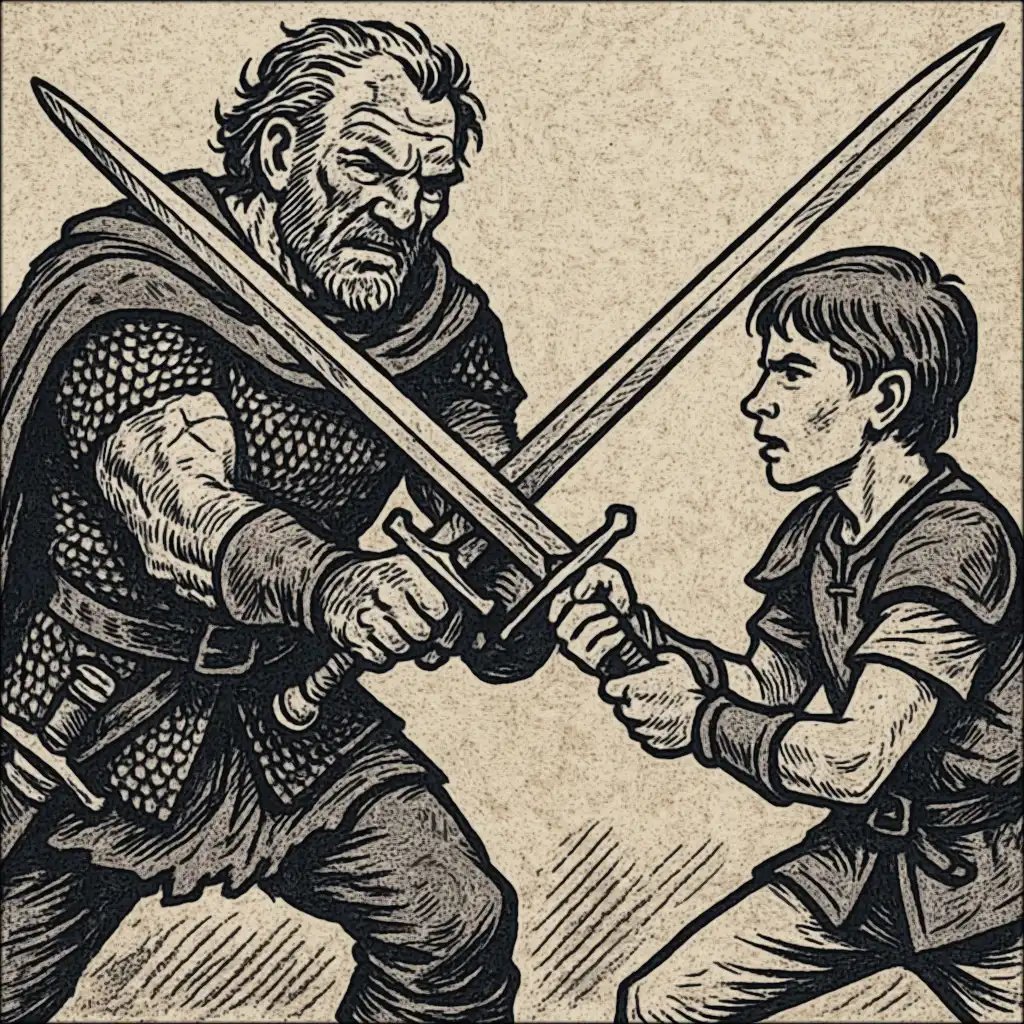
The Nature of Experience
Experience points represent not merely what a character has witnessed, but what they have truly internalized and learned from. The seasoned adventurer who has faced a dragon's breath and lived to tell the tale gains more than just a story – they gain knowledge of draconic behavior, reflexes honed by mortal danger, and perhaps a new appreciation for flame-resistant attire. This practical wisdom, more than simple survival, is the essence of experience.
Sources of Experience: The Game Master awards experience points for various accomplishments and challenges:
-
Combat Victories: Defeating foes in battle is perhaps the most common source of XP. The experience awarded typically depends on the creature's power relative to the character's level, with truly challenging encounters yielding greater rewards. A first-level adventurer slaying a dragon might gain enough XP to advance several levels at once, while that same dragon would provide minimal experience to a 15th-level hero. -
Treasure Acquisition: The procurement of significant wealth often yields experience, representing not just material gain but the challenges overcome to obtain it. This is typically calculated as a percentage of the treasure's monetary value. -
Quest Completion: Fulfilling mission objectives, whether assigned by patrons or self-directed, usually provides substantial experience rewards that reflect the significance and difficulty of the accomplishment. -
Problem Solving: Deducing a villain's plans, discerning the weakness of an otherwise invulnerable creature, solving a complex puzzle guarding an ancient treasure – these intellectual victories deserve recognition equal to martial ones. -
Roleplaying Excellence: Players who embody their characters with consistency, creativity, and depth may receive discretionary XP awards, encouraging the narrative aspects of the game.
Beyond mere numerical accumulation, experience represents the maturation of a character's capabilities and identity. A fighter's growing prowess reflects not just stronger muscles but improved technique, tactical awareness, and battlefield instinct. A mage's expanding spell repertoire signifies deeper understanding of arcane principles and more precise control of magical energies. A cleric's increasing divine favor manifests as more potent spellcasting and stronger connection to their deity.
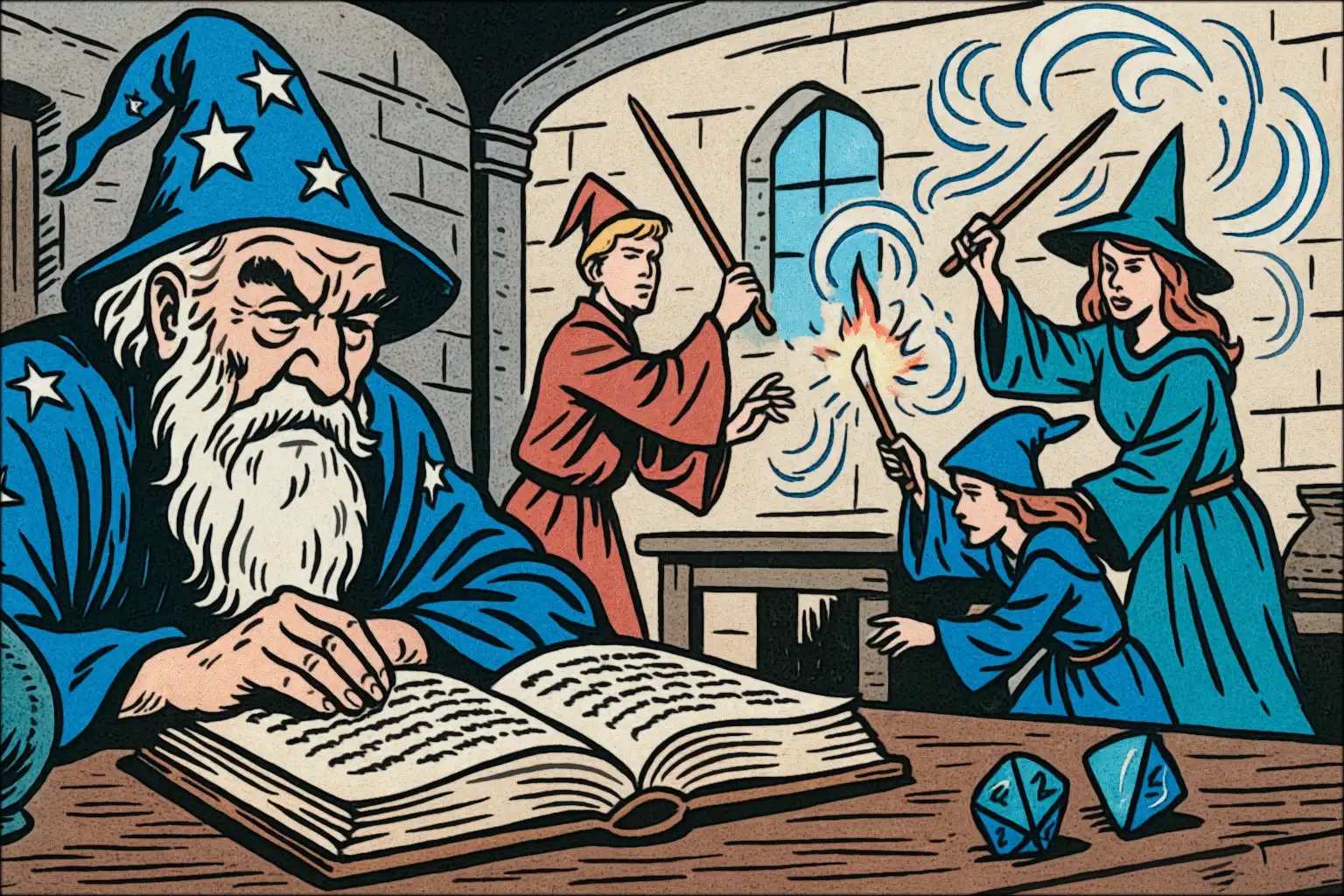
The Path of Advancement: Upon accumulating sufficient experience points to qualify for a new level, characters typically must seek out appropriate training before their improved capabilities manifest fully. This training might involve:
-
Warriors: Intensive combat drills, sparring with masters, and studying battle tactics. -
Mages: Researching new spells, practicing increasingly complex incantations, and refining mental disciplines. -
Clerics: Extended prayer and meditation, communing with their deity, and performing sacred rites. -
Rogues: Practicing advanced techniques with a guildmaster, learning new methods of deception and infiltration.
This training period typically requires safe haven, time (often 1-4 weeks), and possibly monetary expense proportional to the new level being attained. Some Game Masters may require characters to find specific mentors or training facilities for certain level advancements, particularly at higher levels or for specialized abilities.
Experience Requirements by Class
The path of advancement differs significantly between classes, reflecting the varying complexity of their respective disciplines. Mages, whose craft demands intensive study of intricate arcane formulae, typically require more experience to advance than fighters, whose training, though physically demanding, follows more straightforward principles of martial improvement.
The following tables present the experience point thresholds required to attain each level for the primary character classes. Note that these requirements are cumulative – a fighter requires 1,900 XP to reach 2nd level, then an additional 2,350 XP (for a total of 4,250) to reach 3rd level.
| Level | Fighter XP | Hit Dice | THAC0 |
|---|---|---|---|
| 1st | 0 | 1d10 | 20 |
| 2nd | 1,900 | 2d10 | 19 |
| 3rd | 4,250 | 3d10 | 18 |
| 4th | 7,750 | 4d10 | 17 |
| 5th | 16,000 | 5d10 | 16 |
| 6th | 35,000 | 6d10 | 15 |
| 7th | 75,000 | 7d10 | 14 |
| 8th | 125,000 | 8d10 | 13 |
| 9th | 250,000 | 9d10 | 12 |
| 10th | 500,000 | 9d10+3 | 11 |
| 11th | 750,000 | 9d10+6 | 10 |
| 12th | 1,000,000 | 9d10+9 | 9 |
| Level | Cleric XP | Hit Dice | THAC0 |
|---|---|---|---|
| 1st | 0 | 1d8 | 20 |
| 2nd | 1,550 | 2d8 | 20 |
| 3rd | 2,900 | 3d8 | 20 |
| 4th | 6,000 | 4d8 | 18 |
| 5th | 13,500 | 5d8 | 18 |
| 6th | 27,000 | 6d8 | 18 |
| 7th | 55,000 | 7d8 | 16 |
| 8th | 110,000 | 8d8 | 16 |
| 9th | 220,000 | 9d8 | 16 |
| 10th | 450,000 | 9d8+2 | 14 |
| 11th | 675,000 | 9d8+4 | 14 |
| 12th | 900,000 | 9d8+6 | 14 |
| Level | Mage XP | Hit Dice | THAC0 |
|---|---|---|---|
| 1st | 0 | 1d4 | 20 |
| 2nd | 2,400 | 2d4 | 20 |
| 3rd | 4,800 | 3d4 | 20 |
| 4th | 10,250 | 4d4 | 20 |
| 5th | 22,000 | 5d4 | 20 |
| 6th | 40,000 | 6d4 | 19 |
| 7th | 60,000 | 7d4 | 19 |
| 8th | 80,000 | 8d4 | 19 |
| 9th | 140,000 | 9d4 | 19 |
| 10th | 250,000 | 10d4 | 19 |
| 11th | 375,000 | 11d4 | 17 |
| 12th | 750,000 | 11d4+1 | 17 |
| Level | Thief XP | Hit Dice | THAC0 |
|---|---|---|---|
| 1st | 0 | 1d6 | 20 |
| 2nd | 1,250 | 2d6 | 20 |
| 3rd | 2,500 | 3d6 | 20 |
| 4th | 5,000 | 4d6 | 19 |
| 5th | 10,000 | 5d6 | 19 |
| 6th | 20,000 | 6d6 | 19 |
| 7th | 40,000 | 7d6 | 17 |
| 8th | 70,000 | 8d6 | 17 |
| 9th | 110,000 | 9d6 | 17 |
| 10th | 160,000 | 10d6 | 15 |
| 11th | 220,000 | 10d6+2 | 15 |
| 12th | 440,000 | 10d6+4 | 15 |
Benefits of Advancement
As characters attain higher levels, they receive various improvements to their capabilities. The exact benefits vary by class, but typically include:
-
Improved Hit Points: Characters roll their class Hit Die and add their Constitution modifier. If the result is less than a certain minimum (often 3), they may take that minimum instead. After reaching name level (usually 9th), characters typically receive a fixed number of hit points per level rather than rolling. -
Better THAC0: A character's ability to hit opponents in combat improves as they gain levels, with the rate of improvement varying by class. Fighters progress most rapidly (improving every level), while Mages advance most slowly. -
Saving Throw Improvements: Characters become more resistant to various hazards as they gain experience, with saving throw values decreasing (improving) at specific level thresholds. -
Class Abilities: Many classes gain unique abilities at certain levels. Thieves improve their special skills (Pick Pockets, Hide in Shadows, etc.), Clerics gain stronger turning abilities against undead, and Fighters receive more weapon proficiency slots. -
Spell Advancement: Spellcasting classes gain access to more spells per day and higher-level spells as they advance. The exact progression varies by class and is detailed in their respective class descriptions. -
Proficiency Slots: Characters typically gain additional weapon and non-weapon proficiency slots at certain level intervals (often every 3-4 levels), allowing greater specialization or diversification of skills.
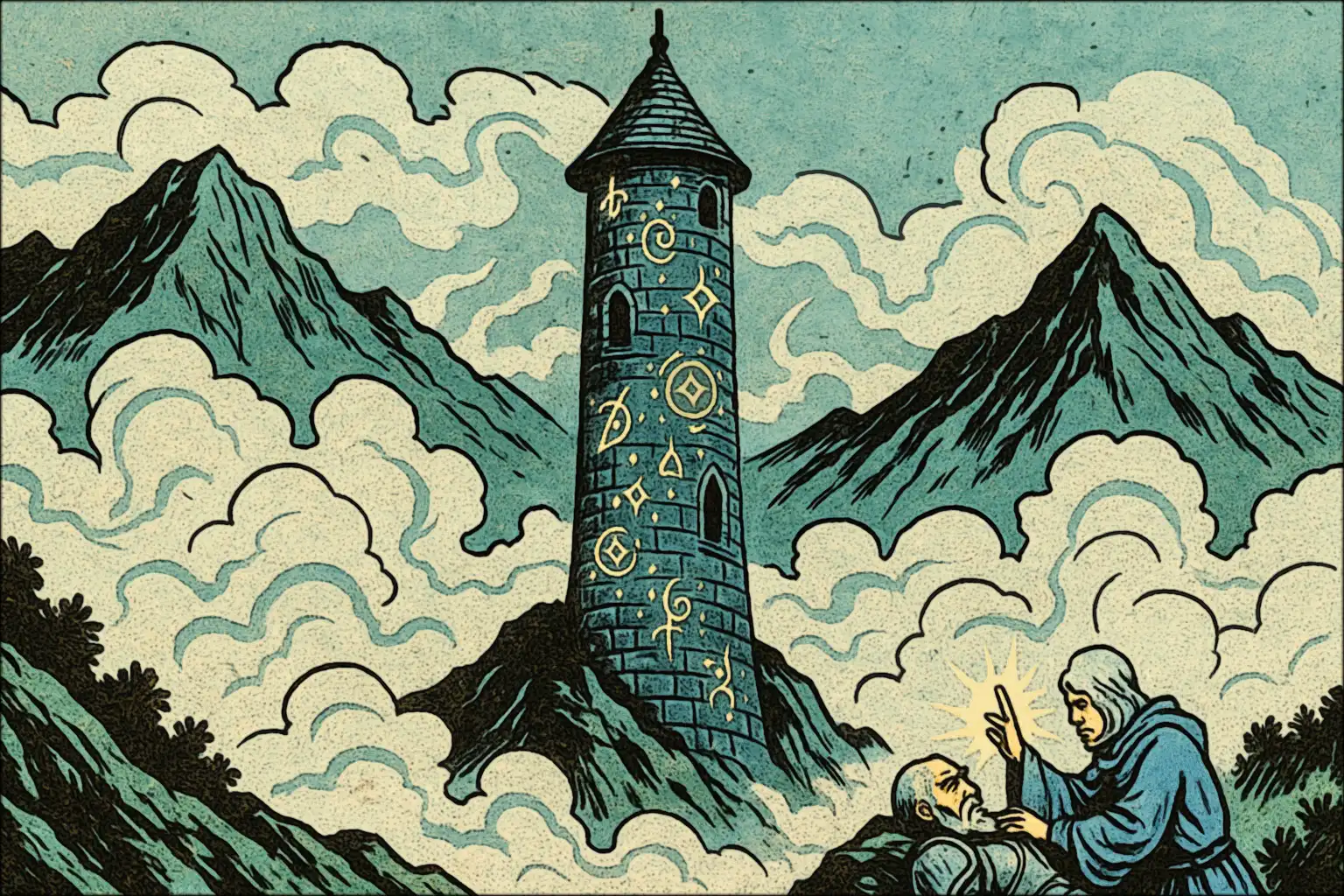
The High Levels: While most campaigns focus on character development from 1st through 9th or 12th level, the rules accommodate advancement to much higher levels – potentially up to 20th level or beyond. These lofty heights represent legendary status, where characters wield powers comparable to demigods and may undertake quests with world-shaping consequences.
The Tapering of Advancement: As characters reach higher levels, the rate of improvement in certain areas begins to taper. Hit points increase more slowly after name level, THAC0 improvements become less frequent for some classes, and the XP requirements between levels grow increasingly steep. This reflects the reality that even legendary heroes face diminishing returns as they approach the upper limits of mortal potential.
Multiclass Advancement: Characters with multiple classes (primarily non-human races) divide their earned experience equally among all their classes, advancing in each simultaneously but more slowly than single-classed characters. This represents the challenge of mastering multiple disciplines concurrently rather than focusing on a single path.
To calculate the experience needed for your next level, consult the appropriate class table. Remember that racial level limits may restrict advancement in certain classes for non-human characters. For example, Dwarves cannot typically advance beyond 9th level as Clerics or 12th level as Fighters, while Halflings face limits on Fighter advancement (typically 8th level) and cannot become Mages at all.
"Each battle scar tells a story, each callus represents a thousand practice swings, each spell mastered recalls countless hours of study. The veterans among us did not become formidable overnight – they paid in blood, sweat, and years what no shortcut can provide." – Lord Commander Darian Thorn, Master of Swordcraft
Chapter VII:
Equipping for Adventure
In the vast and perilous realms of Creatures & Chronicles, an adventurer is only as effective as their equipment allows. The seasoned explorer knows that the proper tools can spell the difference between triumph and doom in the lightless depths of a forgotten dungeon or the monster-haunted wilderness. From the simplest torch to the most enchanted blade, each piece of gear serves a vital purpose and merits careful consideration.
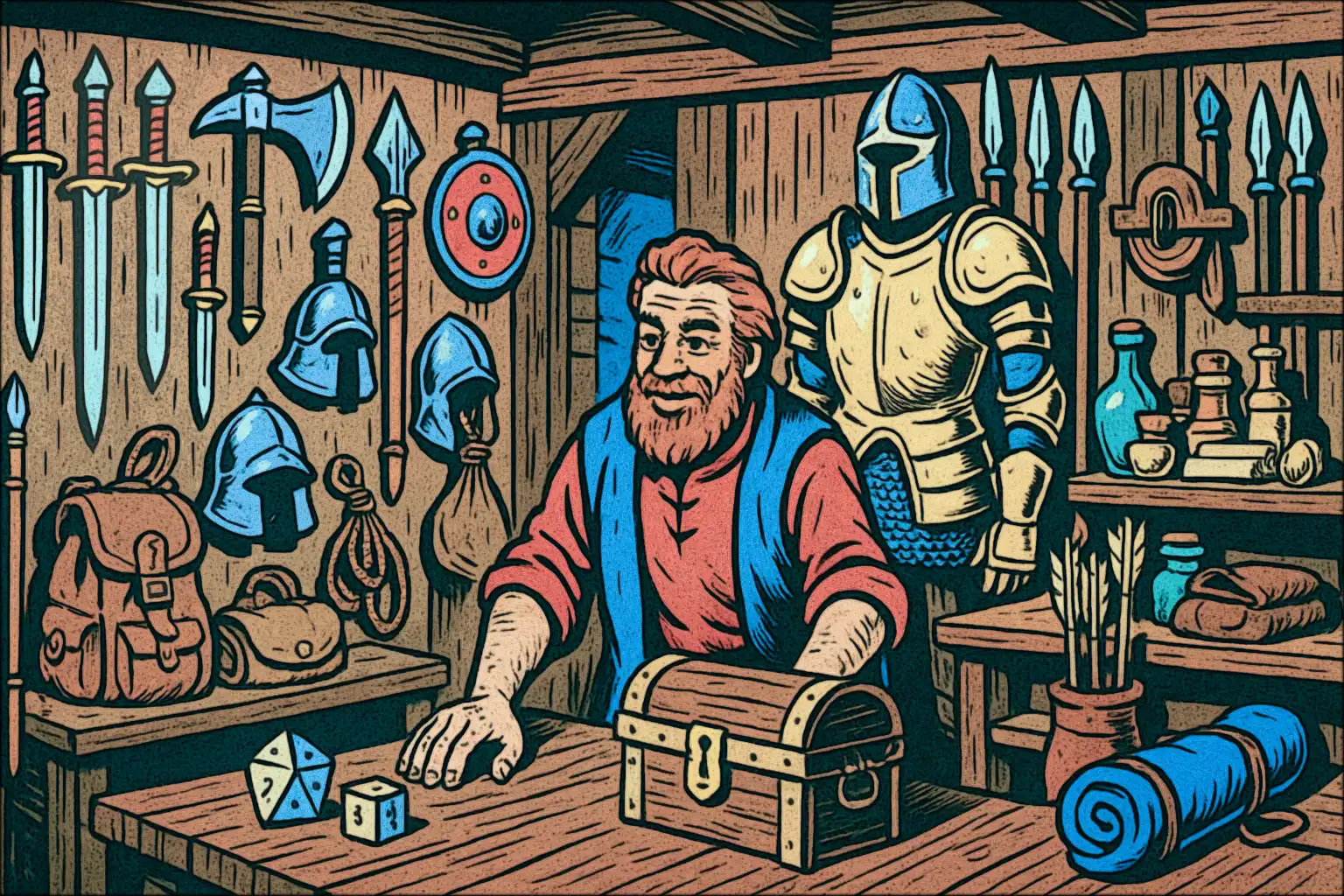
Essential Adventuring Gear
Beyond the obvious requirements of weapons and armor, the prudent adventurer will not venture forth without a carefully assembled collection of tools and supplies. The standard adventurer's kit includes essential items that address the most common challenges faced in the field.
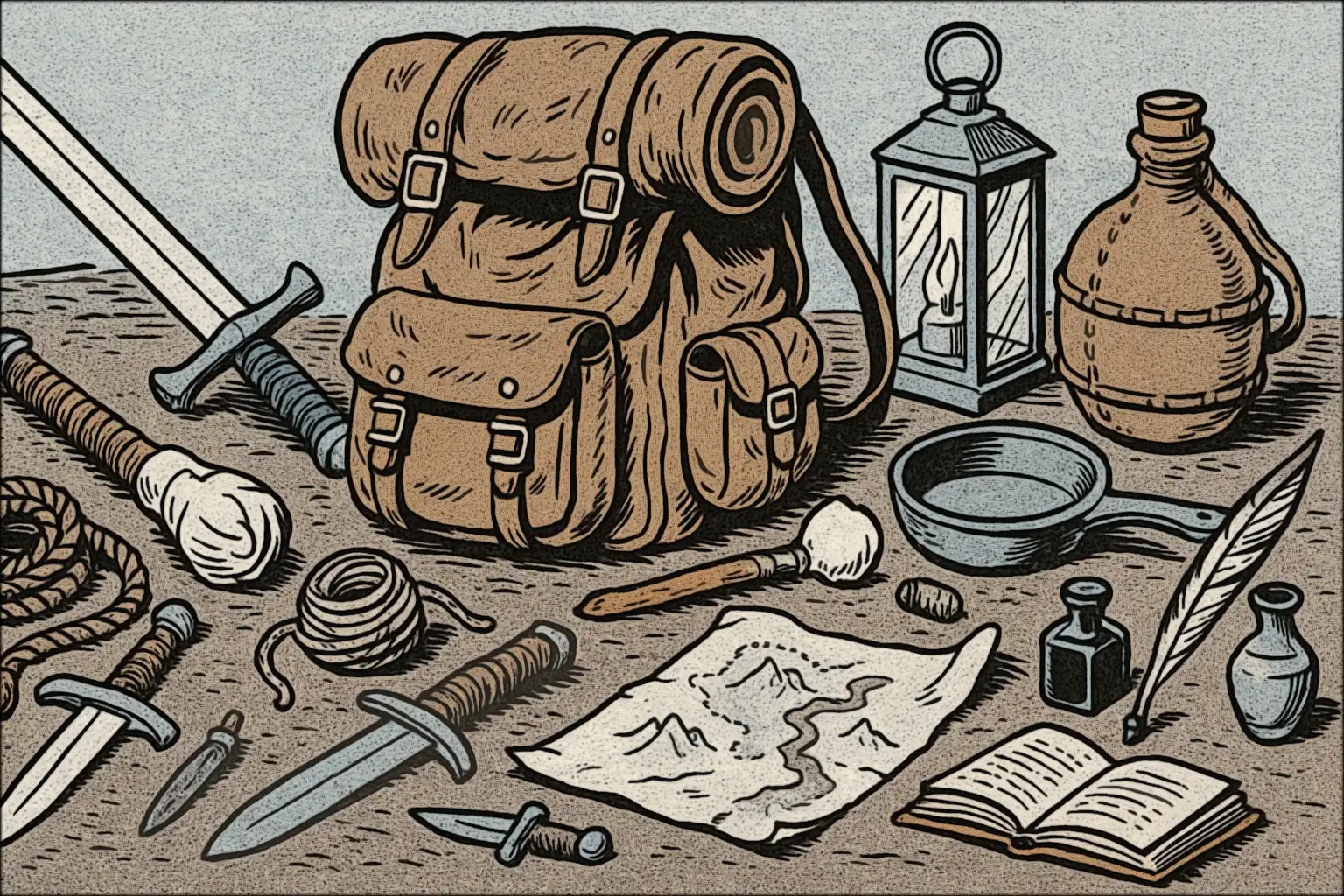
The Adventurer's Pack: While contents may vary based on personal preference and anticipated hazards, a typical adventurer's pack includes:
-
Backpack: A sturdy backpack with multiple compartments allows for organized storage and quick access to essential items. The quality of construction directly impacts durability in harsh conditions. -
Bedroll/Blanket: Essential for rest in the wilderness, providing warmth and some protection from the hard ground. A waterproof groundcloth is often included. -
Fire-Starting Equipment: Flint and steel (10 sp) are the reliable standby, while tinderboxes (5 sp) offer convenience. In damp conditions, prepared tinder or special fire-starting compounds (1 gp) may be necessary. -
Light Sources: Torches (1 cp each) provide bright light for 1 hour but require a free hand; oil lanterns (10 gp) burn for 6 hours per flask of oil (1 sp) and can be hung from hooks; bullseye lanterns (15 gp) project light in a concentrated beam. -
Rope: A 50' coil of hemp rope (1 gp) is among the most versatile tools, useful for climbing, binding, and countless improvisations. Silk rope (10 gp) offers greater strength at reduced weight and is preferred by climbers and thieves. -
Waterskin/Wineskin: Typically holding 2 quarts of liquid (5 sp), multiple skins are recommended for extended journeys away from reliable water sources. -
Trail Rations: Preserved foods (5 sp per day) designed for travel—dried meats, hard cheeses, nuts, dried fruits, and hardtack. While rarely delicious, they resist spoilage for weeks or even months. -
Small Sacks/Pouches: For organizing specific gear, separating components, or storing found treasures (1-5 cp each). -
Belt Pouch: Easily accessible storage for items needed at a moment's notice—coins, gems, spell components, or healing potions (5 sp). -
Whetstone: For maintaining edged weapons in the field (2 cp). -
Watertight Scroll Case: Protects maps, documents, and scrolls from the elements (1 gp).
Specialized Equipment: Different adventuring professions require unique tools. The following specialized equipment is considered essential for their respective practitioners:
-
Thieves' Tools (30 gp): A collection of fine picks, tension wrenches, and delicate probes used for disarming traps and opening locks. Without these tools, a thief suffers severe penalties to their skills. Quality sets may grant bonuses to skill checks. -
Holy Symbol (25 gp): Typically worn as a pendant or mounted on a shield, this symbol of divine authority is required for clerics to channel their deity's power. Each faith has its unique symbol, and using another's may be considered blasphemous. -
Spellbook (50 gp, empty): The mage's most precious possession, containing their arcane knowledge. Constructed of high-quality vellum bound in protective covers, often with locks or protective enchantments. Additional blank pages for new spells cost 10 gp each. -
Component Pouch (25 gp): A specialized belt pouch containing common material components for spellcasting—bits of fur, feather, wax, sulfur, and other substances organized for quick retrieval during casting. -
Healer's Kit (50 gp): Bandages, needles, gut for stitching wounds, herbs, ointments, and small tools. Grants a bonus to natural healing checks and may be required for certain healing proficiencies. -
Climber's Kit (80 gp): Includes pitons, hammers, specialized boots, chalk, and harnesses. Essential for serious mountaineering or dungeon exploration with vertical challenges. -
Disguise Kit (25 gp): Makeup, hair dyes, small props, and tools for altering appearance. Used primarily by thieves for infiltration or by performers.
Beyond these basics, a multitude of specialized items exist for specific challenges—grappling hooks for scaling walls, crowbars for forcing doors, chalk for marking passages, parchment and ink for mapping, field glass for scouting, and countless others. The wise adventurer anticipates likely obstacles and prepares accordingly.
Weapons of War and the Hunt
The selection of appropriate weaponry is a deeply personal choice that reflects one's combat philosophy, physical capabilities, and tactical role within an adventuring company. While skill ultimately trumps the specific choice of weapon, understanding the characteristics and specialized uses of various armaments allows for informed decisions that maximize one's effectiveness in battle.

Weapon Characteristics: Each weapon in Creatures & Chronicles is defined by several key attributes:
-
Damage Type: Weapons deal one of three damage types—Slashing (S), Piercing (P), or Bludgeoning (B)—which interact differently with various armors and creature resistances. -
Damage Dice: The potential damage inflicted by a successful hit, often with different values for man-sized (Small/Medium) and larger opponents. For example, a longsword deals 1d8 damage to Small/Medium creatures but 1d12 to Large ones. -
Weight: Measured in pounds, affecting encumbrance and potentially determining who can effectively wield the weapon. -
Speed Factor: A numerical rating indicating how quickly the weapon can be brought to bear in combat, affecting initiative. Lower numbers (like 3 for a dagger) are faster than higher ones (like 10 for a pike). -
Size: Weapons are categorized as Small (S), Medium (M), or Large (L), affecting which races can use them effectively. Halflings and gnomes face penalties with Large weapons, for instance. -
Hands Required: Most weapons require one hand, but larger or unwieldy weapons (polearms, two-handed swords) require both hands to use effectively. -
Range: For thrown or projectile weapons, the effective distance is measured in tens of feet, typically with three values for short/medium/long range.
The following table presents a selection of common weapons available to adventurers, organized by type:
| Weapon | Cost | Weight | Size | Type | Speed | S/M Damage | Large Damage |
|---|---|---|---|---|---|---|---|
| Long Sword | 15 gp | 4 lbs | M | S | 5 | 1d8 | 1d12 |
| Dagger | 2 gp | 1 lb | S | P | 2 | 1d4 | 1d3 |
| Short Sword | 10 gp | 3 lbs | S | S/P | 3 | 1d6 | 1d8 |
| Two-handed Sword | 50 gp | 15 lbs | L | S | 12 | 1d10 | 3d6 |
| Battleaxe | 5 gp | 7 lbs | M | S | 7 | 1d8 | 1d8 |
| Mace | 8 gp | 6 lbs | M | B | 7 | 1d6+1 | 1d6 |
| Warhammer | 2 gp | 6 lbs | M | B | 4 | 1d4+1 | 1d4 |
| Club | 3 sp | 3 lbs | M | B | 3 | 1d6 | 1d3 |
| Quarterstaff | 3 sp | 4 lbs | L | B | 4 | 1d6 | 1d6 |
| Shortbow | 30 gp | 2 lbs | M | P | 7 | 1d6 | 1d6 |
| Longbow | 75 gp | 3 lbs | L | P | 8 | 1d8 | 1d8 |
| Light Crossbow | 35 gp | 7 lbs | M | P | 7 | 1d4+1 | 1d4+1 |
| Heavy Crossbow | 50 gp | 14 lbs | M | P | 10 | 1d6+1 | 1d6+1 |
Encumbrance: The Burden of Adventure
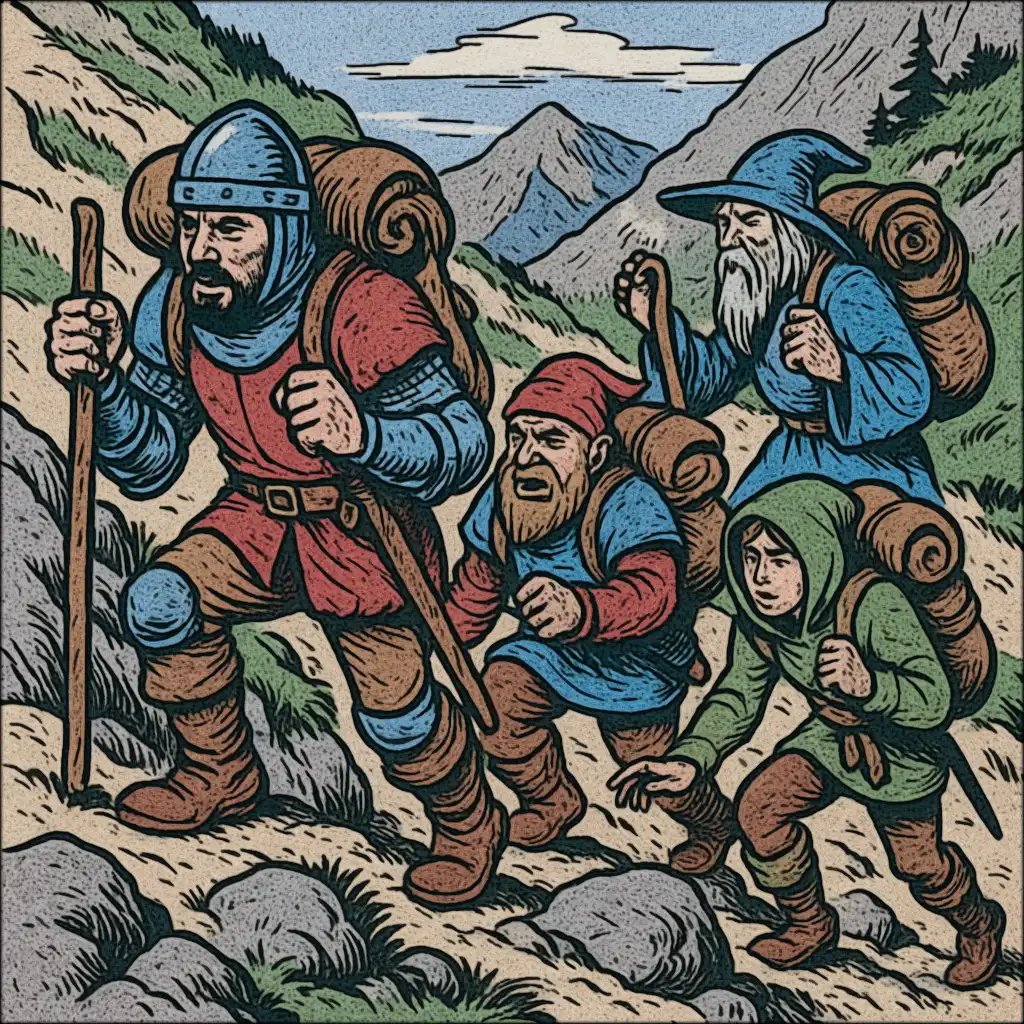
The allure of bringing every potentially useful item on an expedition must be balanced against the harsh realities of physical limitations. While a comprehensive array of equipment prepares one for varied challenges, excessive burden hampers movement, accelerates fatigue, and may prove fatal when swift retreat becomes necessary. Encumbrance in Creatures & Chronicles is a significant tactical consideration.
Carrying Capacity: A character's maximum carrying capacity depends primarily on their Strength score. The following guidelines apply:
-
Unencumbered: Carrying up to (Strength × 10) pounds incurs no penalties. -
Lightly Encumbered: Carrying up to (Strength × 15) pounds reduces movement by 25%. -
Moderately Encumbered: Carrying up to (Strength × 20) pounds reduces movement by 50% and imposes a -1 penalty on attack rolls. -
Heavily Encumbered: Carrying up to (Strength × 25) pounds reduces movement by 75% and imposes a -2 penalty on attack rolls and a -1 penalty to Armor Class. -
Maximum Burden: Characters cannot normally carry more than (Strength × 25) pounds.
Note that certain racial abilities or magical items may modify these limits. Dwarves, for example, have greater endurance for heavy loads, while magical bags of holding contain extradimensional spaces that reduce the effective weight of their contents.
Movement Effects: The base movement rate for most human-sized characters is 12", representing the distance covered in a combat round (approximately 10 seconds) under normal conditions. Each level of encumbrance reduces this rate as noted above. Thus, a lightly encumbered character moves at 9", moderately encumbered at 6", and heavily encumbered at 3".
Weight Management Strategies: Experienced adventurers employ various strategies to manage encumbrance:
-
Central Caches: Establishing hidden supply caches in dangerous regions -
Pack Animals: Mules (30 gp) can carry up to 400 pounds but cannot navigate difficult dungeon terrain -
Prioritization: Distinguishing between essential gear and situational items -
Weight Distribution: Evenly distributing heavy items among party members -
Efficient Equipment: Selecting gear with multiple uses (a quarterstaff serves as both weapon and walking stick)
Chapter VIII:
Wealth & Commerce
The economy of Creatures & Chronicles is based on a standardized currency system, with coins of different metals representing fixed values that remain largely constant throughout civilized regions. Understanding this system is essential for navigating markets, negotiating services, and managing one's wealth effectively.
Standard Currency: The most common coins in circulation include:
-
Copper Piece (cp): The basic unit of currency, commonly used for everyday purchases among commoners. -
Silver Piece (sp): Worth 10 copper pieces, silver represents a day's wages for unskilled labor. -
Gold Piece (gp): Worth 10 silver pieces or 100 copper pieces, gold is the standard medium of exchange for significant transactions. -
Platinum Piece (pp): Worth 5 gold pieces (50 silver or 500 copper), platinum coins are rare and typically used only by the wealthy.
Other forms of wealth include gems, jewelry, art objects, and trade goods. These alternatives to coin often maintain their value across different regions and avoid the encumbrance issues of large quantities of metal currency.
Starting Equipment: Newly created adventurers typically begin with equipment appropriate to their class, background, and initial wealth. A fighter might start with 50-200 gold pieces, while a mage might have 20-80. This initial sum must cover weapons, armor, adventuring gear, and any specialized tools required by one's profession.
The Cost of Living: Beyond equipment, adventurers face ongoing expenses:
-
Lodging: From 1 sp per night (common room of an inn) to 10 gp or more (luxury accommodations) -
Meals: 3 cp (poor) to 5 sp (excellent) per day -
Stabling: 5 sp per day for mount care and feeding -
Equipment Maintenance: Approximately 1% of item value per month -
Healing Services: From 10 gp (minor wounds) to hundreds (major restoration) -
Training: 100 gp per level × level being attained (for level advancement)
"The greatest asset in a dungeon is not the sharpest sword or the most potent spell, but the most critical piece of equipment you failed to pack. Remember: A simple wooden wedge costing a few copper may save your life when jammed beneath a closing stone door." – Torvald the Prepared, Guild Quartermaster
The Living Economy: Wealth, Trade, and Fortune in the Realms
Step into any bustling market square in Creatures & Chronicles and you'll find a world alive with the music of commerce: the clink of coins, the shouts of hawkers, the subtle dance of negotiation, and the ever-present possibility of profit—or loss. The economy is not just a backdrop, but a living system of rules, risks, and opportunities for the clever and the bold.
Currency & Coinage: The Weight of Wealth
Coins are more than numbers on a ledger—they are tangible, weighty, and sometimes a burden. Fifty coins of any type weigh a pound, and a full purse can slow even the hardiest adventurer. The four standard coins are:
- Copper Piece (cp):
The coin of the common folk. A loaf of bread, a mug of ale, or a night in a flea-ridden stable. - Silver Piece (sp):
The backbone of daily trade. Ten copper to a silver; a good meal, a night at a decent inn, or a new set of boots. - Gold Piece (gp):
The adventurer's standard. Ten silver to a gold; a suit of chain mail, a fine horse, or a bribe that might open doors. - Platinum Piece (pp):
The rarest and most valuable. Five gold to a platinum; used for large transactions, noble ransoms, or the deepest pockets.
Gems, jewelry, and trade goods are the currency of the wealthy and the wise—easy to carry, hard to counterfeit, and always in demand.
Buying & Selling: The Art of the Deal
Every vendor in the realms has a story, a mood, and a price. When you approach a merchant's stall, the price you see is only the beginning. Here's how a transaction unfolds:
- Step 1: Find Your Item.
Vendors display their wares—armor, weapons, potions, and oddities. Some items (especially magical or rare) may not be for sale, or may require a special quest or favor. - Step 2: Determine the Base Price.
Each item has a base price and currency (e.g., 15 gp for a longsword). - Step 3: Vendor Mood & Randomness.
The vendor's mood (ranging from surly to delighted) modifies the price (from 0.51× to 1.5×), as does a small random factor (0.9–1.1). A grumpy blacksmith may charge double; a grateful herbalist may offer a bargain. - Step 4: Pay or Haggle.
You may accept the price, attempt to haggle (see below), or try to barter with goods or favors. - Step 5: Complete the Transaction.
If you buy, the item is added to your inventory and the cost deducted (all calculated in copper for precision). If you sell, the item is removed and you receive payment.
Note: Vendors remember you. If you anger or cheat them, their mood and prices may change for future visits.
Haggling: The Dance of Silver Tongues
Haggling is a contest of wits, charm, and nerve. It is a special skill that can be used to negotiate with vendors. By using charm and persuasion, you can lower the price of an item you want to but, or get a better deal on an item you want to sell. Here's how it works:
- Step 1: Make an Offer.
You propose a price (higher or lower than the vendor's offer). - Step 2: Charisma Check.
Roll a d20, add your Charisma, and compare to a target number based on the vendor's agreeableness and mood. The more you push, the harder the check. - Step 3: Success or Failure.
Success means the vendor's mood improves and the price moves in your favor. Failure may sour relations, raise prices, or even lock you out of future deals. - Step 4: Final Offer.
You may make a final offer, but if rejected, the item may be removed from the vendor's inventory for you.
Edge Case: If you repeatedly fail or insult a vendor, they may refuse to deal with you, or even spread word of your reputation.
Bribes: Greasing the Wheels
Sometimes, coin speaks louder than words. Bribes are resolved with a special Charisma check, factoring in the NPC's agreeableness, personality (good/evil), and lawfulness. Here's the process:
- Step 1: Offer a Bribe.
State the amount (in gold pieces) and your intent. - Step 2: Calculate Effectiveness.
The GM determines the bribe's impact: evil and chaotic NPCs are more susceptible; good and lawful ones may be insulted or even hostile. Highly good/lawful NPCs always reject bribes. - Step 3: Charisma Check.
Roll a d20, add Charisma, and apply modifiers for the bribe's effectiveness. If you succeed, the NPC is swayed; if you fail, consequences may follow.
Edge Case: If you attempt to bribe a paladin or judge, expect outrage, legal trouble, or worse. Failed bribes can damage your reputation or close off story paths.
Gambling: Rogue's Gambit and the Lure of Luck
Taverns, back alleys, and noble parlors alike host games of chance. The most famous is Rogue's Gambit—a fast-paced card game of risk and reward.
- Step 1: Place Your Bet.
Wager any mix of coins you possess. - Step 2: Play the Game.
Both player and dealer are dealt three cards (one face-down). Reveal cards, aiming for a total as close to 21 as possible without going over. - Step 3: Call, Fold, or Cheat.
You may call (stick with your hand), fold (forfeit your bet), or, if you have the "Cheat" proficiency, attempt to cheat (Charisma check). Getting caught can have consequences. - Step 4: Resolve the Outcome.
Closest to 21 wins. Winner takes the pot; loser forfeits their bet.
Edge Case: Some establishments ban known cheaters, or may call the city watch. Gambling debts can become story hooks—or trouble.
Charisma & Social Skills: The Adventurer's True Currency
In Creatures & Chronicles, Charisma is more than a number—it's your passport to better deals, open doors, and second chances. Vendor mood and agreeableness persist between encounters, and your reputation can precede you.
High Charisma lowers prices, improves haggling, and makes bribes and gambles more likely to succeed.Low Charisma can close doors, raise prices, and make every negotiation an uphill battle.
Note: The GM may grant bonuses for clever roleplay, creative offers, or memorable in-character banter.
Barter & Creative Transactions: Beyond the Coin
Not every deal is sealed with coin. Barter—trading goods, favors, or secrets—is always possible, especially in remote villages or among those who value the unusual. The GM sets values, but the same price logic applies.
Edge Case: Some NPCs may only accept barter, or may demand a quest or service in lieu of payment. Creative solutions are encouraged!
Chapter IX:
Bestiary
Goblins: The Scrabbling Scourge
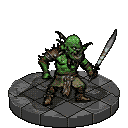
Among the myriad banes of settled lands and unwary travelers, the Goblin stands as a testament to malevolent persistence. These small, wiry humanoids, often with sallow green or dull grey skin, possess oversized heads with pointed ears and eyes that gleam with a greedy, cruel cunning. Their frames, though seemingly slight, are deceptively strong for their size, adapted to the harsh life of scavenging and opportunistic predation.
Goblins are typically found infesting forgotten ruins, dark forests, and the shadowed underbellies of mountains, their lairs often squalid, chaotic warrens reeking of filth and stolen goods. They are inherently cowardly creatures, preferring to attack in overwhelming numbers or through ambush, utilizing crude but effective tactics. When faced with determined resistance or the prospect of a fair fight, their courage often wavers, leading to swift retreats if the tide turns against them.
Their society, if such it can be called, is a brutal hierarchy dominated by the strongest and most cunning, with lesser goblins living in constant fear of their overlords. They are often subservient to more powerful evil creatures, serving as expendable shock troops or miserable slaves. While not known for their craftsmanship, goblins are adept at fashioning crude weapons – often rusted blades, sharpened sticks, or ill-maintained shortbows – and rudimentary armor from scavenged materials. Their intelligence, while not profound, is sharp enough for basic problem-solving, trap-setting, and a surprising capacity for petty cruelty and mischief. They are driven by a base avarice, their treasure troves (if any) usually consisting of pilfered trinkets, copper coins, and items of dubious value, often jealously guarded.
Though an individual goblin presents little threat to a seasoned adventurer, their tendency to appear in large, chattering hordes, their penchant for traps, and their surprising ferocity when cornered should never be underestimated. They are the biting fleas of the wilderness, a constant, irritating presence whose collective threat can quickly escalate from nuisance to dire peril.
Orcs: The Brutal Hand of Ruin
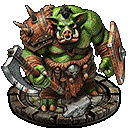
Orcs are the brutal, green-skinned bane of civilized lands, a race seemingly forged for unending war and wanton destruction. Taller and broader than humans, with stooped postures, brutish snouts, and tusks jutting from their lower jaws, their mere appearance is an embodiment of savage intent. The Orc Axeman, a common warrior in their violent tribal societies, exemplifies their straightforward and brutal approach to conflict.
Clad in scavenged pieces of armor – often dented breastplates, mismatched pauldrons, and crude helms – and wielding heavy, roughly-hewn axes, these warriors are a terrifying sight on the battlefield. They favor overwhelming force and direct assault, charging into the fray with guttural war cries, their axes cleaving through armor and flesh with terrifying efficiency. While not known for their tactical acumen, their sheer ferocity and resilience make them formidable opponents.
Orcish tribes typically dwell in squalid dens within dark forests, mountain caves, or fortified ruins, often warring amongst themselves when not raiding weaker settlements. Their society is dominated by strength, with chieftains and champions ruling through intimidation and brute force. They harbor a deep-seated hatred for elves and dwarves, and often serve as shock troops for more powerful evil entities, their chaotic evil alignment driving them to acts of cruelty and despoilment. Though their intelligence is generally low, they possess a base cunning and a surprising adaptability in combat, learning quickly from past encounters. An Orc Axeman encountered alone might be a manageable threat, but they are seldom found so; more often, they surge forth in devastating warbands, their numbers and raw aggression capable of overwhelming even well-defended positions. Their morale, while not unshakable, is bolstered by numbers and the promise of plunder.
Skeletons: The Clattering Dead

The chill of the grave clings to these animate assemblages of bone, mockeries of life given unholy motion by fell necromancy or ancient curses. A Skeleton Warrior is the reanimated remains of a once-living combatant, stripped of flesh and feeling, leaving only a dry, rattling husk driven by a malevolent will or the commands of its dark master. Their empty sockets often burn with a faint, cold light, hinting at the unnatural energies that bind them.
Typically found guarding forgotten tombs, haunting desecrated battlefields, or serving as tireless sentinels for necromancers, Skeleton Warriors retain a semblance of their former martial prowess. They are often equipped with the rusted, decaying remnants of their mortal armaments – pitted swords, notched axes, or brittle spears – and sometimes bear shields or wear fragments of ancient armor. Though lacking the wit of living foes, they are relentless and utterly fearless, driven by a singular purpose until destroyed.
The very nature of their construction makes them uniquely resilient to certain forms of attack; edged and piercing weapons may glance off bone or pass harmlessly through gaps in their structure. Crushing, bludgeoning attacks, however, prove particularly effective at shattering their brittle forms. Skeletons are immune to effects that target the mind or living physiology, such as fear, charm, or poison, and feel no pain nor fatigue. They are often encountered in silent, disciplined ranks, their movements eerily coordinated, their advance marked by the dry clatter of bone on bone. While an individual skeleton might not possess great cunning, their unyielding nature and the dread they inspire make them a persistent threat, especially when encountered in numbers.
Trolls: The Regenerating Ravagers
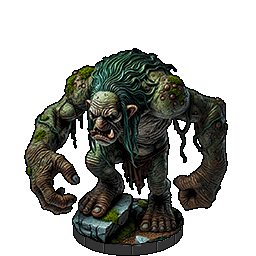
Few creatures inspire such primal fear in the hearts of adventurers as the Troll. These gaunt, towering humanoids, with their rubbery, mottled green or grey skin, are infamous for their ravenous hunger and, most terrifyingly, their nigh-unstoppable ability to regenerate from the most grievous wounds. Their long, powerful limbs end in razor-sharp claws capable of shredding armor and flesh with equal ease, and their wide maws are filled with teeth designed for tearing. A troll's eyes burn with a dull, malevolent hunger, reflecting their singular drive: to consume.
Trolls are ambush predators, their coloration allowing them to blend into the shadowed depths of forests, the gloom of caves, or the desolate quiet of wastelands. They are possessed of a brutish cunning, often hurling massive rocks to stun or injure prey before closing in for a savage assault with tooth and claw. Their attacks are relentless, driven by an insatiable appetite.
The true horror of facing a troll lies in its extraordinary regeneration. Wounds close and knit back together almost instantly, and even severed limbs may continue to writhe and attack independently for a short time. To permanently slay a troll, adventurers must resort to fire or acid, as these are the only known forces that can sear their flesh beyond its capacity to heal. Without such measures, even a dismembered troll, left for dead, might eventually reform and rise again, a chilling prospect for any who have faced their fury.
Though primarily driven by instinct, trolls are not without a crude societal structure. Packs are often led by dominant females, who may also possess rudimentary shamanistic abilities, bolstering their kin. These leaders guide their packs to new hunting grounds or orchestrate raids on unfortunate settlements. Troll lairs, typically fetid dens littered with the bones of past victims and scavenged valuables, are dangerous but potentially rewarding targets. Their greed and insatiable hunger, however, can sometimes be exploited by clever adventurers. While they fight with a terrifying lack of self-preservation, the searing kiss of flame or the sting of acid can sometimes drive them into a panicked retreat. Encountering a troll demands courage, teamwork, and, above all, a ready supply of fire.
Ogres: The Dim-Witted Brutes

Ogres are hulking, powerfully built humanoids, standing significantly taller and broader than a human, their frames thick with corded muscle. Their dull, often warty skin ranges in color from a sickly ochre to a bruised purple-grey, and their features are crude and brutish, with low, sloping foreheads and piggish eyes that gleam with a dim, greedy light. They are the quintessential bullies of the monster world, relying on their formidable strength and intimidating presence to terrorize weaker creatures and travelers.
Typically clad in crudely stitched hides and furs, and often armed with oversized, roughly fashioned clubs or spiked bludgeons, Ogres are not subtle combatants. They charge into battle with guttural roars, swinging their weapons with devastating force, capable of shattering shields and felling smaller opponents with a single blow. While possessed of considerable natural toughness, their lack of sophisticated armor makes them vulnerable to well-aimed strikes.
Ogres are generally of low intelligence, driven by simple desires: food (preferably fresh meat), shiny objects, and the brutal satisfaction of dominating those weaker than themselves. They often dwell in small family groups or unruly gangs in caves, dilapidated ruins, or dark forests, preying on travelers or raiding isolated homesteads. Their lairs are usually squalid, littered with gnawed bones and stolen goods. While primarily chaotic and evil, their dull wits can sometimes be exploited, and they are susceptible to being tricked or led into traps by clever adventurers. Though formidable in a direct confrontation due to their sheer strength and surprising speed for their bulk, their lack of discipline and tactical thinking makes them less of a threat than their size might suggest, especially when faced by a coordinated party.
Kobolds: The Craven Hoarders
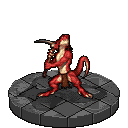
Kobolds are small, reptilian humanoids, often no taller than a human child, with scaly hides that range from rust-red to dark brown, and dog-like or rat-like snouts filled with tiny, sharp teeth. Their eyes, beady and quick, reflect a craven and resentful nature. They are commonly found infesting dark, subterranean warrens, mines, or the cramped, forgotten corners of larger dungeons, where their diminutive size and sensitivity to bright light offer them an advantage.
These creatures are inherently cowardly, preferring to rely on sheer numbers, crude traps, and ambushes from hidden positions rather than direct confrontation. Individually weak, their strength lies in their vast numbers and their surprising aptitude for constructing simple but often effective traps – pit traps, tripwires, and deadfalls are common features of their lairs. Kobolds are often armed with small, poorly maintained weapons like short spears, daggers, or slings, and may wear scraps of leather or hide as makeshift armor.
Kobold society is typically tribal and hierarchical, dominated by the strongest or most cunning individuals, though their leadership is often tenuous and prone to infighting. They possess a particular affinity for mining and will laboriously dig out intricate tunnel systems, often stumbling upon valuable ore veins or, more dangerously, awakening slumbering subterranean beasts. Kobolds harbor an intense racial hatred for gnomes, viewing them as rivals for territory and resources, and this enmity often fuels vicious skirmishes. Despite their low intelligence and generally fearful disposition, they are known for their surprising tenacity when defending their lairs or their meager hoards, which usually consist of shiny trinkets, stolen tools, and small amounts of copper or silver. Their yapping cries and the clatter of their small weapons often herald their presence long before they are seen, a warning of the numerous, if individually unimpressive, threat they represent.
Giant Spiders: Weavers of Shadowed Silk
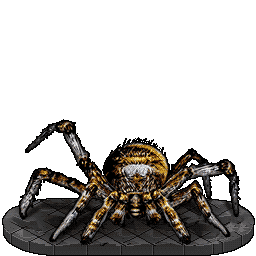
In the darkest forests, forgotten ruins, and lightless subterranean caverns, lurk the monstrous arachnids known simply as Giant Spiders. These eight-legged horrors, far exceeding the size of their mundane kin, are patient and deadly predators, their bodies often covered in coarse, dark hairs, and their multiple eyes gleaming with cold, alien hunger. Their fangs, dripping with potent venom, are formidable weapons capable of delivering a swift and agonizing end to the unwary.
Giant Spiders are masters of ambush, spinning vast, intricate webs of sticky silk in areas of heavy traffic or strategic chokepoints. These webs, often nearly invisible in dim light, serve not only to ensnare prey but also to alert the spider to the presence of intruders through vibrations. They are remarkably agile for their bulk, capable of skittering across walls and ceilings with unnerving speed, dropping onto unsuspecting victims from above or scuttling out from hidden crevices.
The bite of a Giant Spider is feared not just for the piercing wound it inflicts, but for the debilitating venom that accompanies it. This poison can vary in its effects, from causing intense pain and paralysis to inducing a slow, creeping death if not treated. Giant Spiders often cocoon their captured prey in layers of silk, preserving them for later consumption. While not typically creatures of high intellect, they possess a predatory cunning honed by generations of successful hunting. Their lairs are often eerie, silk-draped chambers, littered with the desiccated husks of past meals and sometimes containing clutches of their leathery eggs. Facing a Giant Spider often means contending not only with its venomous bite and entangling webs but also navigating treacherous terrain designed to give the arachnid every advantage.
Wolves: Hunters of the Wild Pack
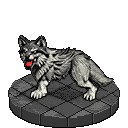
The haunting howl of the Wolf echoing through shadowed forests or across snow-swept plains is a primal sound that speaks of wildness, cunning, and the ever-present dance of predator and prey. These intelligent and highly social canines are formidable hunters, their lean, powerful bodies built for speed and endurance, their senses keenly attuned to the slightest sign of quarry. Their coats vary from grey and brown to black or even pure white in arctic climes, providing excellent camouflage in their native terrains.
Wolves are pack hunters, relying on coordinated tactics, relentless pursuit, and sheer numbers to bring down prey often larger and stronger than themselves. A typical pack is led by an alpha pair, the strongest and most experienced individuals, who direct the hunt and maintain order within the group. Their primary weapon is a powerful bite, their jaws capable of crushing bone, and their sharp fangs designed to tear flesh.
While often viewed as malevolent due to their predatory nature and the threat they pose to livestock and unwary travelers, wolves are primarily driven by the instinct to survive and provide for their pack. They are fiercely territorial, marking their domains and defending them vigorously against intruders, including other wolf packs or encroaching humanoids. Their intelligence, though animalistic, allows them to learn from experience, avoid obvious traps, and display surprising patience and cunning when stalking prey. Though they rarely carry treasure in the conventional sense, their lairs – often secluded dens in caves, beneath tangled roots, or in remote thickets – may sometimes contain the remnants of past victims, including any valuables those unfortunate souls carried. An encounter with a lone wolf might be a manageable affair, but facing an entire pack, operating with chilling coordination under the direction of its alphas, is a far more dangerous prospect.
Thornhide Basilisk: The Stone-Eyed Sovereign of the Swamp
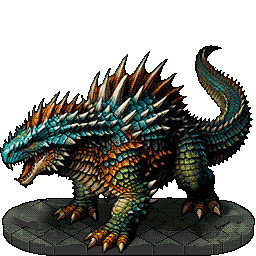
Deep within the tangled, murky hearts of ancient swamps and desolate, forgotten places, dwells the Thornhide Basilisk, a creature of fearsome legend and chilling reality. This formidable reptilian predator, often solitary, is distinguished by its incredibly tough, bark-like hide, from which protrude countless sharp, sturdy thorns, offering both excellent protection and a passive threat to any who draw too near. Its lineage is whispered to be as ancient as the primordial landscapes it inhabits, a living remnant of an age when such monstrosities held dominion over the wild.
The Thornhide Basilisk moves with a deliberate, reptilian grace, its large, powerful body supported by sturdy limbs. But its primary weapon, and the source of its dread reputation, lies in its eyes – orbs of searing, unnatural light that pulse with an inner power. To meet the gaze of a Thornhide Basilisk is to invite a horrifying transformation, for its stare possesses the dreadful ability to turn living flesh to cold, unyielding stone. So potent is this petrifying gaze that some legends claim it can calcify the very air around it, leaving shimmering, crystalline traces of its passage.
While its gaze is its most infamous attribute, the Basilisk is also a capable physical combatant, its thorny hide deflecting blows and its powerful jaws capable of delivering a painful bite, though it often prefers to rely on its petrifying stare to subdue prey or deter threats. Alchemists covet its thorny scales for their reputed magical properties, and warriors sometimes seek the grim glory of having faced such a legendary beast. Yet, others believe this ancient creature, having witnessed the passing of uncounted centuries, holds a unique wisdom, a prize for those who can survive its deadly trial. To encounter the Thornhide Basilisk is to confront a primal terror, a test of courage and will against a creature that embodies the unforgiving and often magical nature of the world's darkest corners.
Bandit Archer: Death from the Shadows
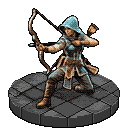
While many bandits prefer the brutal immediacy of melee, some specialize in delivering death from a distance.The Bandit Archer is a common, yet dangerous, foe found within the ranks of outlaw bands. These individuals are skilled in the use of bows or crossbows, providing ranged support for their comrades or picking off vulnerable targets from positions of cover.
Often possessing keener eyes and steadier hands than their brawling counterparts, Bandit Archers are adept at finding advantageous positions – be it high ground, dense thickets, or shadowy ruins – from which to launch their volleys.They typically wear lighter armor, if any, to maintain mobility and are armed with hunting bows, shortbows, or occasionally crossbows, their quivers filled with arrows or bolts, sometimes crudely fletched but no less deadly.
Bandit Archers understand the value of surprise and will often initiate an ambush with a well-aimed shot before melee combatants engage.They are more likely to target spellcasters or other lightly armored individuals first, seeking to neutralize key threats.While they share the general self-preservation instincts of all bandits and are prone to flee if a battle turns sour, a well-positioned group of archers can inflict significant casualties before an adventuring party can close the distance or find cover.Dealing with Bandit Archers often requires tactical thinking, utilizing terrain for protection, and prioritizing their elimination to prevent a steady rain of missiles.
Lizardfolk: The Scaled Marsh-Dwellers
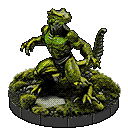
Lizardfolk are resilient, reptilian humanoids most commonly found in swamps, marshes, and dense, humid jungles. Their bodies are covered in tough, scaly hides – typically in shades of green, brown, or grey – that provide excellent natural protection and camouflage within their watery domains. Standing roughly human height, though often more powerfully built, Lizardfolk possess strong tails used for balance and sometimes as weapons, and their hands and feet are tipped with sharp claws. Their heads are distinctly reptilian, with snouts, unblinking eyes, and often a crest or frill.
These creatures are primarily tribal, living in communal villages often constructed from mud, reeds, and timber, cleverly concealed within the dense vegetation of their chosen habitats. They are skilled hunters and fishers, well-adapted to an amphibious lifestyle, capable of holding their breath for extended periods and moving swiftly through water. While often perceived as primitive or savage by other races, Lizardfolk possess a practical intelligence and a deep understanding of their natural environment. Their society, though seemingly simple, is often bound by ancient traditions and a strong sense of communal identity.
In combat, Lizardfolk are formidable opponents. Their scaly hides offer good natural armor, and they fight fiercely with their claws and powerful bites. Many tribes also fashion crude but effective weapons from bone, stone, and wood, such as spears, clubs, and javelins, and some learn to use captured metal weaponry. They are territorial and will aggressively defend their lands and hunting grounds from intruders. While not inherently evil, their alien mindset, territorial nature, and occasional practice of sacrificing captives to their primitive deities often lead to conflict with more civilized races. Their guttural, hissing language is difficult for outsiders to comprehend, further contributing to misunderstandings and hostility.
Hobgoblins: The Disciplined Scourge
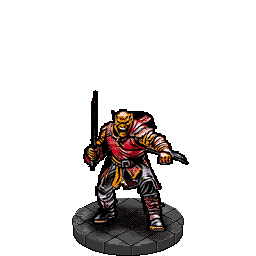
Larger and far more disciplined cousins of the common goblin, Hobgoblins are a formidable militaristic race, their societies organized into rigid hierarchies and driven by conquest and martial prowess. Their brutish, often hairy faces, typically orange-red to dark reddish-brown, are set with fierce, intelligent eyes that betray a cunning and malevolent nature. Standing as tall as humans, though generally broader and more powerfully built, Hobgoblins exude an aura of menace and regimented cruelty.
Unlike their smaller kin, Hobgoblins are not prone to cowardice or disorganized rabble. They are known for their strict military discipline, their warriors often clad in well-maintained (if crudely fashioned) armor and wielding a variety of effective weaponry, from swords and axes to polearms and bows. They train rigorously, fight with coordinated tactics, and maintain their equipment with a care rarely seen among other goblinoid races. This martial focus makes them a significantly more dangerous foe than their goblin or orcish counterparts, capable of forming disciplined battle lines and executing complex maneuvers.
Hobgoblin tribes or "legions" often establish fortified lairs in strategic locations, such as mountain passes, defensible ruins, or underground complexes, from which they launch raids and wage wars against neighboring communities. They are inherently lawful evil, their societies valuing strength, obedience, and efficiency above all else. While they despise most other races, they hold a particular enmity for elves. They are known to take slaves, forcing captives to labor in their mines or serve as fodder in their armies. Though their intelligence is not exceptional, it is sufficient for strategic thinking, fortification, and the effective leadership of their troops. Encountering Hobgoblins often means facing a well-armed, well-armored, and disciplined force that will fight fiercely and with a grim determination rarely seen in other monstrous humanoids.
Gnolls: The Hyena-Fiends of Ruin

Gnolls are savage, hyena-headed humanoids notorious for their insatiable hunger, chaotic brutality, and terrifying cackling laughter that often echoes across desolate plains or through shadowed ruins. Taller than humans, with lean, rangy bodies covered in mangy, often spotted fur, they possess powerful jaws capable of crushing bone and a demeanor that blends unnerving cunning with a primal ferocity. Their eyes burn with a feral hunger, and their presence often heralds slaughter and despoilment.
These creatures roam in aggressive, loosely organized warbands, driven by an endless craving for flesh and plunder. They are nomadic by nature, rarely settling in one place for long, preferring to sweep through an area, consuming all they can before moving on, leaving a trail of devastation in their wake. Gnoll warbands are often accompanied by packs of hyenas, with whom they share a strange kinship and an equally rapacious appetite.
In combat, Gnolls are fearsome opponents, relying on their numbers, surprising speed, and savage strength. They often fight with a reckless abandon, their attacks fueled by bloodlust. While they may use crude armor scavenged from their victims and wield a variety of weapons – often heavy, bone-breaking clubs, crudely fashioned spears, or captured swords and axes – their most fearsome weapon is often their powerful bite. Gnoll society is brutal and hierarchical, with the strongest and most vicious individuals dominating the pack. They are typically chaotic evil, delighting in cruelty and showing little regard for pacts or alliances beyond the immediate needs of their warband. Though not known for their intellect, they possess a low cunning and an instinct for ambuscade and overwhelming their foes through sheer ferocity.
Hill Giants: The Crude Colossi
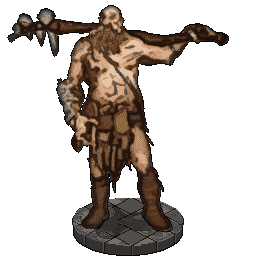
Hill Giants are hulking, brutish figures, the least intelligent but often most numerous of the giant-kin. They tower over lesser creatures, their immense frames covered in rough, often dirt-caked skin, and their features coarse and ill-tempered. These dim-witted behemoths are driven by simple, primal urges: hunger, greed, and a dull, simmering aggression towards anything smaller than themselves.
Typically clad in crudely stitched animal hides or scavenged rags, Hill Giants favor massive clubs – often uprooted trees or roughly hewn boulders lashed to sturdy branches – as their primary weapons. Their sheer strength allows them to wield these ponderous armaments with devastating effect, crushing armor and bone with single, earth-shattering blows. Despite their size, they can move with surprising speed when roused to anger or enticed by the promise of food. A favored tactic, particularly when confronting foes at a distance, is to hurl massive rocks, which they can throw with surprising accuracy and tremendous force.
Hill Giants make their lairs in caves, deep forest groves, or roughly constructed stone hovels in hilly, untamed regions. Their dwellings are invariably squalid and reek of filth and decaying food, littered with the bones of past meals and whatever crude treasures they have managed to bully from weaker creatures or steal from unwary travelers. They are often found in small family groups or loose tribes, their social structure based on raw strength and intimidation, with the largest and most aggressive individuals dominating the others. While their low intelligence makes them susceptible to clever ruses and traps, their immense strength, considerable toughness, and savage ferocity make them a dire threat to any who cross their path.
Frost Giants: The Icy Titans of the North
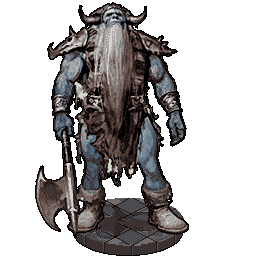
Hailing from the desolate, frozen expanses of the world, Frost Giants are formidable and cruel titans, their hearts as cold as the icy winds that howl across their domains. They are massive figures, significantly larger and more imposing than their Hill Giant cousins, with skin the pale blue-white of glacial ice and hair often like spun frost or frozen snow. Their eyes gleam with a chilling, malevolent intelligence, and their voices rumble like distant avalanches.
Frost Giants are clad in thick furs and hides, often adorned with bones and trophies taken from their victims, and wield immense weapons suited to their prodigious strength – typically colossal axes, greatswords, or hammers, sometimes crafted from enchanted ice or magically hardened bone. They are masters of their arctic environments, moving with surprising agility across frozen tundra and treacherous mountain peaks. Like other giants, they are fond of hurling massive boulders at their foes, their throws capable of shattering fortifications and crushing smaller creatures. They possess an innate resistance to cold, making them impervious to the biting chill of their homelands and many forms of cold-based magic.
These icy behemoths make their lairs in vast ice caves, glacial fortresses, or crude strongholds built from rock and frozen timber. They are often found in warring clans or raiding parties, driven by a fierce territoriality and a lust for plunder and slaves. Frost Giants are known for their savage cruelty and their disdain for "lesser" races, particularly those who dwell in warmer climes. They are skilled hunters, preying on arctic beasts and unfortunate travelers alike, and their hoards often contain rich treasures plundered from raided settlements or lost expeditions. More intelligent and cunning than Hill Giants, they are capable of tactical thought and often employ ambushes or exploit the harsh terrain to their advantage. An encounter with a Frost Giant is a terrifying prospect, their immense power and chilling presence a true test of an adventurer's mettle.
White Dragons (Small): The Icy Harbingers
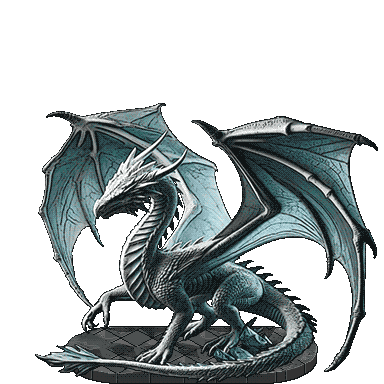
Even in their lesser forms, White Dragons embody the brutal, primal essence of winter's fury. These are not the grand, ancient wyrms of legend, but smaller, though no less malevolent, members of their kind. Their scales, ranging from brilliant white to a dull, icy grey, often glisten like fresh-fallen snow or ancient glacial ice, providing natural camouflage in their frigid domains. Their eyes, typically a pale, piercing blue or icy silver, gleam with a feral cunning and an inherent cruelty.
Though smaller than their elder kin, Small White Dragons are still formidable predators. They possess a powerful bite and sharp claws, capable of rending flesh and armor. Their most terrifying weapon, however, is their breath – a cone of numbing, flesh-freezing cold that can incapacitate or kill outright. They are agile for their size, often using the frozen terrain of their lairs to their advantage, ambushing prey from snowdrifts or icy crags.
White Dragons, regardless of age, are known for their low intelligence compared to other dragon types, relying more on brute strength, animalistic cunning, and their devastating breath weapon than on intricate schemes. They are driven by instinct, hunger, and a territorial possessiveness. Their lairs are typically found deep within glaciers, hidden in ice caves, or atop snow-swept mountain peaks. The very presence of a White Dragon often brings a supernatural chill to the surrounding area, sometimes manifesting as perpetual winter or unnatural blizzards. They hoard treasures with a preference for items that shimmer and reflect light, such as gemstones, polished metals, and objects encased in ice, guarding their icy caches with jealous ferocity. In local folklore, White Dragons are often depicted as harbingers of endless winter, their appearance a dire omen of hardship and frozen death.
Black Dragons (Small): The Corrosive Vipers of the Mire
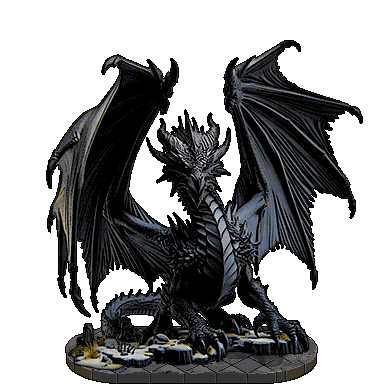
Lurking in the fetid depths of ancient marshes, stagnant swamps, and shadowed, forgotten waterways, the Small Black Dragon is a creature of vile temperament and corrosive power. Their scales, often appearing as polished obsidian or dark, oily slicks, shimmer with a malevolent iridescence, perfectly suited for concealment in their murky domains. Their eyes, typically a baleful yellow or molten gold, glow with a keen, cruel intelligence and a deep-seated spite.
Even as lesser members of their potent lineage, Small Black Dragons are fearsome predators, combining surprising agility with stealth and a penchant for vicious ambushes. They are adept at using their environment, often lying in wait submerged in murky waters or hidden within dense, fog-choked thickets. Their primary physical weapons are a powerful bite and rending claws, but their most dreaded attack is their breath – a stream or gout of potent, flesh-eating acid capable of dissolving armor, stone, and living tissue with horrifying speed. This acid is not merely a weapon but a tool, used to carve out lairs and deter intruders.
Black Dragons are infamous for their cunning and sadistic nature. They delight in the suffering of others and are known to toy with their prey. Their lairs are often dismal, cave-like structures or tangled, overgrown nests within the heart of blighted swamps. It is said that the very presence of a Black Dragon corrupts the surrounding land, turning vibrant ecosystems into desolate, acidic mires where only the hardiest and most malevolent creatures can thrive. They are fiercely intelligent and territorial, often employing traps or manipulating lesser creatures to guard their hoards. Black Dragons show a particular fondness for treasures that are ancient, corroded, or have a history of sorrow and loss, seeing a dark beauty in decay.
Green Dragons (Small): The Verdant Deceivers

Dwelling within the emerald depths of ancient forests, tangled jungles, and mist-shrouded woodlands, the Small Green Dragon is a master of camouflage and cunning. Their scales, a vibrant mosaic of greens, browns, and sometimes mottled yellows, allow them to blend seamlessly with the dense foliage of their chosen domains. Their eyes, often a deep, knowing emerald or a unsettling amber, reflect a sharp, manipulative intelligence.
Even in their smaller forms, Green Dragons are sly and treacherous predators. While possessing the typical draconic arsenal of bite and claws, their preferred method of attack often involves guile, ambush, and their insidious breath weapon – a billowing cloud of noxious, poisonous gas that can choke and incapacitate victims, leaving them vulnerable. They are patient hunters, often observing prey for extended periods, learning their habits before striking with calculated precision.
Green Dragons are infamous for their deceitful and manipulative nature, enjoying verbal sparring, riddles, and psychological games as much as physical confrontation. They might attempt to charm or trick unwary travelers into revealing secrets or leading them to treasure. Their lairs are typically well-hidden caves beneath ancient trees, overgrown ruins deep within forests, or grottoes concealed by waterfalls and dense vegetation. The flora and fauna around a Green Dragon\'s lair often seem unnaturally lush or subtly twisted, reflecting the dragon\'s influence. They have a particular fondness for hoarding magical artifacts, scrolls, and items of historical or intellectual value, often plundered from elven ruins, forgotten temples, or unwary scholars.
Wraiths: The Soul-Draining Specters
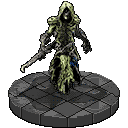
From the shadowed places where great sorrow or profound evil has stained the world, Wraiths emerge as chilling specters of malevolence. These incorporeal undead are beings of pure hatred and negative energy, their forms often appearing as dark, humanoid silhouettes with vaguely defined features and eyes that burn with a cold, hungry light. They glide silently, untouched by physical barriers, their very presence exuding an unnatural chill that seeps into the bones of the living.
Wraiths are driven by an insatiable hunger for life force and an undying animosity towards all living things. They are often found haunting ancient ruins, forgotten crypts, or sites of tragic death, drawn to places where the veil between life and death is thin. While they can pass through solid objects, their touch is chillingly real and carries a dreadful consequence.
The most terrifying aspect of a Wraith is its life-draining touch. A successful strike from a Wraith not only inflicts chilling damage but also drains a portion of the victim\'s vital essence, a phenomenon known as Energy Drain. This horrific ability can weaken even the mightiest warrior, sapping their strength, experience, and will to live. Those slain by a Wraith\'s draining touch may themselves rise as spectral undead under the Wraith\'s control, their souls forever lost. Wraiths are intelligent and cunning foes, often using their incorporeality to ambush victims, passing through walls or floors to strike without warning. They are resistant to most forms of conventional weaponry; only magical weapons, silver, or certain spells can reliably harm their spectral forms.
Winter Wolves: The Frost-Fanged Hunters
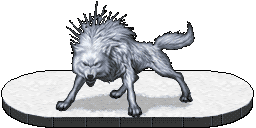
Larger and far more formidable than their common lupine cousins, the Winter Wolf is a creature of the icy plains and snow-laden forests, a predator perfectly adapted to the harshest frozen environments. Their thick coats are typically pure white or shot through with silver and pale blue, providing excellent camouflage amidst snow and ice. Their eyes often gleam with a cunning, malevolent light, and their breath mists in even the coldest air, sometimes carrying a hint of unnatural frost.
Winter Wolves are not mere beasts; they possess a notable intelligence and a cruel disposition. They hunt in packs, employing sophisticated tactics to surround and bring down prey, which can include hardy arctic animals as well as unwary travelers or isolated settlements. Their fangs are long and sharp, capable of inflicting grievous wounds, but their most dangerous attribute is often their chilling breath. A Winter Wolf\'s breath is a cone of numbing cold that can freeze flesh, slow opponents, and coat the ground in treacherous ice.
These formidable hunters are fiercely territorial and often serve as mounts or hunting companions for Frost Giants or other malevolent denizens of the frozen north. Their lairs are typically secluded dens or ice caves, often littered with the frozen remains of their kills. While not known for hoarding treasure in the same way as dragons, valuable items might occasionally be found amongst the possessions of their unfortunate victims. A pack of Winter Wolves, with their combination of physical prowess, chilling breath, and cunning pack tactics, presents a deadly threat to any who venture into their frozen domains.
Giant Rats: The Scurrying Swarm

Ubiquitous in the dark and forgotten corners of the world, Giant Rats are a loathsome pestilence and a common threat to novice adventurers and unprepared settlements alike. Considerably larger than their mundane kin, often reaching the size of a small dog or even a badger, these oversized rodents possess mangy fur, beady eyes that gleam with a primal hunger, and long, sharp incisors capable of delivering surprisingly painful bites.
Giant Rats thrive in environments shunned by others – sewers, dilapidated basements, forgotten dungeons, and garbage heaps. They are opportunistic scavengers and surprisingly aggressive predators when their numbers give them courage. While a single Giant Rat might be easily dispatched, they are rarely encountered alone. Their true danger lies in their tendency to swarm, overwhelming foes with a tide of gnashing teeth and disease-ridden claws.
These creatures are driven by a constant, gnawing hunger and a primal instinct to propagate. Their nests are often squalid, hidden affairs, and they breed prolifically. Though possessed of only animalistic cunning, they are quick to exploit weaknesses and will often target the injured or isolated. Their bites, while not particularly powerful individually, carry a significant risk of disease, which can prove more debilitating than the wounds themselves. Though they hoard no treasure, their presence often indicates decay, neglect, and the proximity of other, greater dangers lurking in the shadows.
Zombies: The Shambling Plague
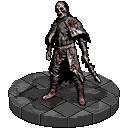
The Zombie is a horrifying testament to the power of necromancy, a reanimated corpse given unnatural locomotion but stripped of will, intellect, and the spark of true life. These pitiful creatures are often the recently deceased, their bodies bearing the marks of their demise or the slow decay of the grave. Their skin is typically pallid, bruised, or rent with open sores, and their movements are slow, clumsy, and unnervingly persistent. A low, guttural moan is often the only sound they emit, a hollow echo of the life they once possessed.
Zombies are driven by a singular, mindless compulsion: to find and consume the flesh of the living. They possess no fear, no sense of self-preservation, and will shamble relentlessly towards any living creature they detect, often in great numbers. Their attacks are crude, typically consisting of grasping claws and snapping teeth, but the sheer weight of their numbers and their unyielding advance can overwhelm even stalwart defenders.
The creation of a Zombie is often the result of dark rituals, potent curses, or the lingering effects of unholy ground. They are frequently encountered in graveyards, ancient battlefields, or places blighted by dark magic. While individually slow and unintelligent, a horde of Zombies presents a significant threat. They are difficult to turn aside and will continue their advance until utterly destroyed. Fire and potent holy magic are particularly effective against these shambling horrors, as conventional blows may only slow their inexorable march. The sight of a Zombie is a grim reminder of mortality and the dark forces that seek to pervert it.
Zombie Warriors: The Undead Soldiery
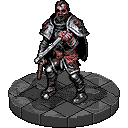
Among the shambling ranks of the undead, Zombie Warriors stand as a more formidable threat. These are the reanimated corpses of individuals who possessed martial skill in life – soldiers, guards, or adventurers whose bodies have been twisted into unthinking servitude. While sharing the mindless hunger and slow gait of common Zombies, they often retain fragments of their former prowess, or at least the decaying remnants of their armor and weaponry.
A Zombie Warrior is distinguished by its tattered wargear – perhaps a rusted helmet clinging to its desiccated scalp, a dented breastplate hanging loosely on its emaciated frame, or a rotted shield still strapped to an unfeeling arm. Their grip may still clutch a decaying sword, axe, or spear, wielded with a clumsy but surprisingly forceful strength. Though their movements are stiff and uncoordinated, the muscle memory of combat, however faded, makes their attacks more dangerous than those of their lesser kin.
These undead soldiers are often found guarding cursed tombs, ancient armories, or the lairs of necromancers who value their greater resilience and offensive capability. They are just as relentless as common Zombies but can withstand more punishment before succumbing to final rest. The clatter of their ancient arms and armor often heralds their approach, a grim warning of a tougher fight than a mere shambler might provide. Defeating a Zombie Warrior often means contending not just with its undead nature but also with the lingering echoes of its martial past.
Zombie Ogres: The Hulking Pestilence

When the already formidable physique of an Ogre succumbs to the corrupting touch of necromancy, the result is a truly horrifying monstrosity: the Zombie Ogre. These towering undead behemoths retain the immense size and brute strength of their living counterparts but are twisted into shambling engines of decay and mindless aggression. Their thick, often rotting hides hang loosely on their massive frames, and their dull, vacant eyes betray no hint of the dim cunning they might have possessed in life.
A Zombie Ogre is a terrifying sight, often still wielding a massive club or tree trunk with clumsy yet devastating force. Their slow, ponderous movements belie the incredible power behind their blows, each capable of shattering bone and pulping flesh. Beyond their sheer physical might, Zombie Ogres carry a potent aura of disease and decay. Their very touch, or even proximity, can transmit foul sicknesses, making them a vector for pestilence as well as a physical threat.
These hulking abominations are typically the work of powerful necromancers or the result of potent curses afflicting areas where Ogres dwell. They are often used as shock troops by undead armies or as guardians for sites of immense evil. Their low intelligence makes them predictable, but their incredible resilience, raw power, and the diseases they carry make them exceptionally dangerous foes. Overcoming a Zombie Ogre requires not only martial prowess but also a strong constitution and a prayer to ward off the corrupting sickness that clings to them.
Stirges: The Blood-Draining Pests
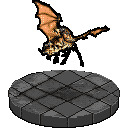
Stirges are grotesque, avian creatures that combine the worst aspects of a large mosquito and a predatory bird. Roughly the size of a small hawk, they possess leathery, bat-like wings, a feathered body, and a long, needle-sharp proboscis designed for one grisly purpose: to pierce flesh and drain blood. Their small, beady eyes fixate on warm-blooded prey with an unnerving intensity, and the leathery flap of their wings often precedes their swift, darting attacks.
These monstrous blood-feeders are commonly found in dark, damp places such as caves, old ruins, and dense, shadowed forests. They are drawn to the scent of living creatures and often attack in flocks, their numbers making up for their individual fragility. A Stirge will attempt to latch onto its victim with its sharp claws and then plunge its proboscis deep to begin its horrifying blood drain. Once attached, they are difficult to dislodge and will continue to feed until either sated or killed.
While a single Stirge might pose little more than a nuisance, a swarm can quickly overwhelm an unprepared victim, leaving them weakened and exsanguinated. Their attacks are swift, and they are surprisingly agile flyers, capable of navigating cluttered environments with ease. The primary danger from Stirges, beyond the immediate blood loss, is the weakening effect of multiple attached feeders and the potential for distraction in a more complex combat encounter. The sight of these creatures often evokes a visceral disgust, a natural revulsion to their parasitic nature and their relentless pursuit of vital fluids.
Jungle Stirges: The Venomous Blight of the Tropics
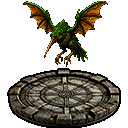
Deep within the sweltering, verdant expanses of tropical jungles, a more venomous and aggressive breed of Stirge has evolved – the Jungle Stirge. While sharing the repulsive avian form and blood-draining habits of their common kin, these creatures are often larger, with duller, mottled plumage that allows them to blend seamlessly with the dense foliage. Their proboscis may be thicker, and their eyes possess an even more predatory gleam.
Jungle Stirges are adapted to the intense competition and myriad dangers of their environment. They are more resilient and possess a keener predatory instinct. Like other Stirges, they attack in flocks, seeking to overwhelm their prey with numbers. However, the Jungle Stirge harbors an additional terror: a potent paralyzing poison delivered with their bite. Victims not only suffer from the debilitating blood drain but may also find their limbs growing heavy and unresponsive, leaving them vulnerable to the relentless swarm or other jungle predators.
These venomous pests are a true blight upon jungle trails and ancient, vine-choked ruins. Their lairs are often in hollow trees, dense thickets, or the shadowy eaves of crumbling temples. The combination of their blood drain and paralyzing poison makes encounters with Jungle Stirges particularly perilous, turning a potential nuisance into a fight for survival. The humid air of their domain often carries the faint, metallic scent of blood and the unnerving, leathery beat of their wings.
Jungle Vipers: The Silent Strikers of the Undergrowth

The dense, humid jungles are home to countless perils, and among the most insidious are the Jungle Vipers. These reptiles, often adorned with vibrant and intricate patterns that allow them to melt into the dappled light and lush foliage of their habitat, are masters of ambush. They range in size, but even smaller specimens can deliver a potent dose of venom, making them a constant threat to those who tread carelessly through their domain.
Jungle Vipers are patient hunters, often lying in wait for hours or even days, perfectly still, amidst tangled roots, low-hanging branches, or within the leafy detritus of the jungle floor. Their senses are keenly attuned to the vibrations and movements of potential prey. When an unsuspecting creature passes within range, the viper strikes with blinding speed, its fangs injecting a powerful venom designed to swiftly incapacitate or kill.
The venom of a Jungle Viper can vary in its effects, from agonizing pain and rapid swelling to debilitating paralysis or even swift cardiac arrest. These snakes are generally solitary creatures, except during mating season, and are fiercely territorial. While they do not hoard treasure, their presence often indicates an environment teeming with life, both hazardous and benign. Navigating the territories of Jungle Vipers requires constant vigilance, a keen eye for camouflaged threats, and a healthy respect for the silent, venomous death that can strike from the shadows.
Jungle Savages: The Wild Tribes of the Green Hell
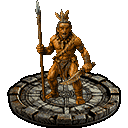
Deep within the impenetrable hearts of vast, untamed jungles, isolated tribes of humans have adapted to a brutal and primal existence. Known to outsiders as Jungle Savages, these peoples live in close, often harsh, harmony with their wild environment, their societies shaped by ancient traditions, superstitions, and the constant struggle for survival. Their appearance is often striking, with bodies adorned with tribal paints, animal fetishes, and crude jewelry crafted from bone, wood, and stone.
Jungle Savages are skilled hunters, trackers, and foragers, possessing an intimate knowledge of the jungle\'s dangers and bounties. They are often fiercely territorial and deeply suspicious of outsiders, whom they may view as spirits, demons, or simply unwelcome intruders. Their weaponry is typically crafted from natural materials – spears tipped with fire-hardened wood or sharpened stone, crude clubs, and sometimes bows strung with animal gut. While not inherently evil, their alien customs and aggressive defense of their lands can lead to violent conflict.
Encounters with Jungle Savages can vary greatly. Some tribes may be reclusive and avoid contact, while others might be openly hostile, viewing any encroachment as a threat. Their warriors, though often lightly armored or unarmored, are wiry, agile, and fight with a desperate ferocity born of their harsh environment. They may employ ambush tactics, use terrain to their advantage, and communicate with eerie calls that echo through the dense canopy. Understanding their motivations, which can range from protecting sacred sites to simple resource scarcity, is key to navigating interactions, though often, the first greeting is a flight of spears or a wild, charging yell.
Jungle Savage Bowmen: The Hidden Death from the Trees
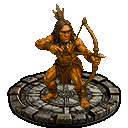
Complementing the fierce melee combatants of the wild jungle tribes are the Jungle Savage Bowmen, skilled archers who utilize the dense environment to their deadly advantage. Like their brethren, they are adorned with tribal markings and natural accoutrements, but their focus is on delivering death from a distance, often from concealed positions high in the canopy or deep within tangled undergrowth.
These bowmen are masters of stealth and camouflage, able to move silently through the jungle and pick out targets with surprising accuracy. Their bows are typically crafted from resilient jungle woods and strung with tough animal sinew, launching arrows fletched with vibrant bird feathers and tipped with sharpened wood, bone, or stone. While their individual arrows may not be as potent as those loosed from more sophisticated bows, a volley from several hidden bowmen can be devastatingly effective, sowing confusion and thinning ranks before a melee assault.
Jungle Savage Bowmen often work in concert with their melee counterparts, providing covering fire, targeting vulnerable enemies, or creating diversions. They are adept at using the verticality of the jungle, firing from elevated positions that make them difficult to spot and engage. An encounter with these archers is a true test of awareness, as the first sign of their presence is often the whistle of an incoming arrow or the sudden cry of a companion struck from an unseen foe. They embody the jungle\'s capacity for sudden, unexpected danger.
Cave Trolls: The Subterranean Brutes
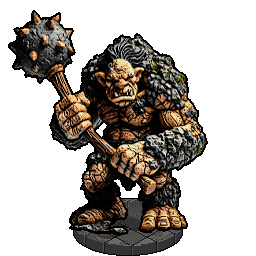
Deep beneath the earth, in lightless caverns and forgotten tunnel systems, dwell the Cave Trolls, a particularly brutish and formidable variant of their surface-dwelling kin.Larger and often more heavily built than common trolls, their hides are typically a sickly, pale grey or a mottled, earthy brown, adapted to the gloom of their subterranean existence.Their eyes, accustomed to darkness, often appear as dull, glowing embers, reflecting a primal cunning and an insatiable hunger.
Cave Trolls are known for their exceptional strength and resilience. Like all trolls, they possess a remarkable regenerative ability, their wounds knitting closed with terrifying speed.This makes them incredibly difficult to dispatch without the use of fire or acid, which can sear their flesh beyond its capacity to heal.They are often armed with massive clubs, crude stone axes, or simply their own powerful fists and rending claws, each blow capable of shattering stone and bone.
These subterranean horrors typically make their lairs in expansive cave systems, often near underground rivers or fungal forests.They are less ambush predators than their surface cousins, relying more on their sheer intimidating presence and brute force to overwhelm intruders or prey.Their lairs are usually squalid, littered with the remains of past meals – often including unfortunate miners, subterranean creatures, or other unwary explorers – and whatever crude treasures they have managed to accumulate.While their intelligence is low, they possess a territorial ferocity and will defend their domains with savage determination. The echoing roar of a Cave Troll in the darkness is a sound that has heralded the doom of many an unprepared adventurer.
Giant Centipedes: The Chittering Horror

Skittering forth from the damp, dark places of the world, the Giant Centipede is a horrifying sight to behold.These multi-legged arthropods, far exceeding the size of their lesser kin, can range from several feet to truly monstrous lengths. Their chitinous bodies are often a sickly brown, dull black, or unsettlingly vibrant shades, and their myriad legs carry them with an unnerving, rippling speed across any surface.
Giant Centipedes are ambush predators, often lurking in shadowy crevices, beneath rotting logs, or within the crumbling stonework of ancient ruins.They are drawn to warmth and movement, striking with surprising swiftness when prey comes within range. Their primary weapon is a vicious bite delivered by powerful mandibles, which often inject a potent venom.
The venom of a Giant Centipede can vary, but it frequently causes intense pain, swelling, and muscular paralysis.Larger specimens may possess venom capable of causing death if not quickly treated. Their tough exoskeletons provide a degree of natural armor, making them surprisingly resilient.Though not creatures of high intellect, they possess a predatory cunning and will often target vulnerable or isolated individuals. The chittering, scraping sound of their passage is often the only warning before their swift and venomous attack.
Spikeshell Behemoths: The Ancient Wardens
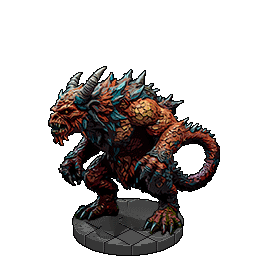
In the forgotten wilds, where the ancient trees whisper secrets of a bygone era, there lurks a creature of both myth and nightmare – the Spikeshell Behemoth. Clad in crimson scales that glisten like spilled blood under the moonlight, this primal force of nature is a terrifying sight. Legends speak of its origins as if it were a punishment from the gods, a guardian of nature's forbidden sanctums, or perhaps a remnant of a world that existed before the stars were named.Its body is a living fortress, armored with jagged scales and formidable spines, each a testament to countless battles with heroes long forgotten or beasts that dared challenge its dominion. The Spikeshell's eyes, glowing with the ferocity of a creature unchallenged for eons, betray a hint of ancient, unsettling wisdom—perhaps an intelligence that surpasses the feral growls it utters from deep within its massive throat.
Adventurers speak in hushed tones of its lair, often a secluded, primeval grove or a deep, craggy ravine, inevitably surrounded by the bones of the overbold and the scattered remains of those who sought to plunder the secrets it so fiercely guards. Its roar is said to be the herald of doom, a sound that shakes the earth and silences the forest's natural melody. The very air around the creature seems to shiver with the cold dread of its ancient presence.The Spikeshell Behemoth is no mere animal; it is often considered a creature of elemental fury, a living embodiment of the land's raw power. It has been whispered that it was born from the heart of the world itself, shaped from the chaotic energies that course through rock and root. It acts as a warden of the wilds, sometimes seeming to enact the will of unseen forces that strive to keep the balance between creation and oblivion.
Those who have seen it and lived to tell the tale often speak of the Spikeshell's most terrifying aspect: its seeming ability to understand, or perhaps sense, the hearts and intentions of those who enter its domain. It does not always hunt in the conventional sense; sometimes, it judges. Its judgments are swift, brutal, and as final as the setting sun. For in its gaze, one does not see merely a beast, but the embodiment of the wilds—untamed, unyielding, and unfathomable.To encounter the Spikeshell Behemoth is to face the ancient and unbridled essence of nature itself. It is to walk in a realm where humanity is not dominant but merely another thread in the intricate and often perilous tapestry of life. In the presence of such a creature, one must not ask for mercy, for it is as impartial as the mountains and as inexorable as the tides. The wise do not seek it out. The brave rarely challenge it. Only the foolish, the desperate, or those guided by an equally potent fate dare to disturb the Spikeshell Behemoth.
Dire Boars: The Unstoppable Fury
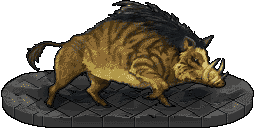
The Dire Boar is an enormous and terrifying creature, far larger and more dangerous than its smaller kin. Found in the deepest forests and wildest plains, the Dire Boar is a force of nature, known for its incredible strength and relentless aggression. Its hide is thick and tough, covered in coarse, bristly hair that seems almost impenetrable, often caked with mud and grime which acts as a crude, natural armor.These monstrous boars are fiercely territorial and will attack anything that enters their domain with unyielding ferocity. Their massive tusks, sharp as any spear, can rip through armor and flesh with ease, and their powerful charges can knock down even the sturdiest of foes, leaving them vulnerable to a flurry of goring attacks. A Dire Boar's senses are incredibly sharp, its piggish eyes missing little and its flared nostrils constantly testing the air for the scent of intruders, making it nearly impossible to sneak up on one.
The lair of a Dire Boar is often marked by torn-up trees, deep gouges in the earth, and a landscape ravaged by its immense strength and irritable temper. These creatures are not only dangerous but also possess a primal cunning, sometimes using their environment to ambush unsuspecting prey or to drive them into disadvantageous positions. Despite their bulk, Dire Boars are surprisingly fast and agile for their size, able to navigate rough terrain and dense undergrowth with alarming ease.In many legends, Dire Boars are seen as symbols of untamed wilderness and raw, destructive power. Hunters and warriors who manage to slay a Dire Boar are often hailed as heroes, their deeds sung in taverns, and the tusks of these creatures are highly prized as trophies, symbols of bravery, or even as components in powerful magical items. Their meat, though incredibly tough, is said to be rich and rewarding to those who can prepare it properly, sustaining a group for days.
Encountering a Dire Boar is a harrowing experience that requires both courage and strategy. These creatures do not back down easily, fighting with a berserk fury until slain or their target is destroyed. Defeating one is a testament to an adventurer's strength, skill, and often, sheer luck. The thrill of facing such a formidable beast is matched only by the danger it presents, making the Dire Boar a true challenge for any who dare to hunt it or foolishly stumble into its territory.
Huge Spiders: The Eight-Legged Nightmares
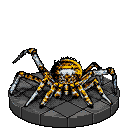
Beyond the already formidable Giant Spiders, there exist specimens of even greater size and terrifying potency – the creatures commonly dubbed Huge Spiders.These are not mere oversized arachnids; they are often ancient predators, solitary hunters that have grown to monstrous proportions through age, potent magic, or by feasting in areas rich with foul energies. Their carapaces can be as tough as boiled leather, and their many eyes gleam with a disturbing, malevolent intelligence that surpasses their smaller kin.
Huge Spiders are masters of ambush, capable of spinning colossal webs that can ensnare creatures as large as horses or ogres. Their lairs are chilling charnel houses, festooned with the desiccated husks of past victims, often hidden in the deepest, darkest parts of ancient forests, towering mountain crags, or sprawling underground complexes.The venom of a Huge Spider is exceptionally potent, capable of inducing swift paralysis, excruciating pain, or even rapid flesh decay, depending on the specific variant. They are cunning hunters, often employing hit-and-run tactics or luring prey into elaborate traps. Some are even rumored to possess rudimentary magical abilities or an unnatural control over lesser spiders.
Confronting a Huge Spider is a task for only the most prepared and courageous adventurers. Their sheer size, formidable fangs, potent venom, and the treacherous terrain of their lairs make them exceedingly dangerous foes. The chilling sight of such a monstrous arachnid descending from the shadows is an image that haunts the nightmares of many who have survived such an encounter.
Minotaurs: The Horned Fiends of the Labyrinth
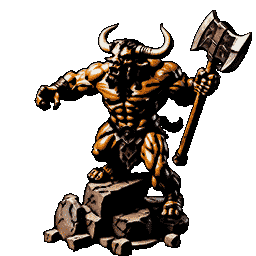
In the shadowed depths of sprawling mazes, ancient ruins, and forgotten undercities, the terrifying bellow of the Minotaur echoes – a sound that speaks of primal rage and brutal power.These monstrous humanoids, possessing the hulking body of a man and the savage head of a bull, are formidable adversaries, their immense strength matched by a cunning and often cruel intellect.Their thick hides, often matted with dried blood and filth, offer considerable protection, and their powerful horns are as deadly as any crafted weapon.
Minotaurs are often depicted as guardians of labyrinthine lairs, their natural sense of direction making them masters of disorienting and trapping their prey.They are driven by a savage hunger, not just for flesh, but for the thrill of the hunt and the despair of those lost within their domains.While some Minotaurs wield crude, oversized weapons – often massive axes or clubs – many rely on their sheer brute force, goring with their horns and crushing with their powerful fists.Legends tell of their creation as cursed beings, forever bound to their maze-like prisons, a testament to forgotten gods or arcane punishments.
They are surprisingly intelligent for their brutish appearance, capable of setting crude traps and employing cunning tactics to corner their victims.While typically solitary or found in small, warring groups, the presence of a Minotaur often signifies a place of great danger and ancient, malevolent power.The ground trembles with their heavy footfalls, and the air grows thick with the scent of blood and primal fury when a Minotaur is near.
Mummies: The Accursed Guardians of Ancient Tombs
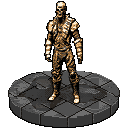
From the dust-choked crypts of forgotten pharaohs and the unhallowed tombs of ancient sorcerer-kings, the Mummy shambles forth – a horrifying testament to preservation through dark magic and undying curses.These are not mere animated corpses; Mummies are the preserved remains of powerful individuals, their bodies meticulously prepared and imbued with potent enchantments to serve as eternal guardians of their resting places and treasures.Wrapped in stained and decaying linen bandages, their desiccated forms often exude an aura of ancient malevolence and a chilling, musty odor of decay and forgotten spices.
Mummies are driven by an unwavering will to protect their tombs from any and all intruders. They are often slow but relentless, their touch capable of inflicting a terrible, supernatural disease known as Mummy Rot, which can swiftly wither the flesh and spirit of the afflicted.The mere sight of a Mummy can also inspire paralyzing fear in even the stoutest hearts, a supernatural dread born from the unnatural power that animates them.Fire is often their greatest weakness, the cleansing flames anathema to their preserved forms, but they are otherwise unnervingly resistant to conventional harm.
Legends whisper of the intricate rituals that create Mummies, rituals that bind their souls to their corpses and imbue them with a fraction of their former power, twisted by centuries of undeath.They possess a hateful intelligence and a memory of their past lives, making them cunning and often cruel foes.The air around a Mummy crackles with negative energy, and the silence of their tombs is often broken only by their dry, rasping groans or the soft, unnerving rustle of their ancient wrappings.
Owlbears: The Ferocious Feathered Fury

One of the most bizarre and unnervingly ferocious predators to stalk the wilderlands is the Owlbear.This unnatural hybrid combines the massive, powerful body and sharp claws of a bear with the head, piercing gaze, and razor-sharp beak of a giant owl.Covered in a thick coat of feathers and fur, typically in shades of brown, grey, and white, the Owlbear is a terrifying sight, its screeching hoot a chilling prelude to a savage attack.
Owlbears are notoriously aggressive and ill-tempered, attacking almost anything that encroaches upon their territory with little provocation.They are driven by a voracious hunger and possess incredible strength, capable of tearing through armor and flesh with their powerful claws and delivering a crushing, bone-shattering bite with their formidable beak.Despite their bulk, they can move with surprising speed and agility, particularly when charging their prey.
The origins of the Owlbear are a subject of much debate among sages – some believe them to be the result of a mad wizard's arcane experiments, while others posit they are a primal creature from a forgotten age.Regardless of their genesis, they are a persistent threat in temperate forests and hilly regions.They typically make their lairs in caves, dense thickets, or ruined structures, often littered with the bones of their victims.While not particularly intelligent, their sheer ferocity and unpredictable nature make them incredibly dangerous opponents.
Ice Ghosts: The Frigid Phantoms
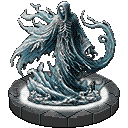
The Ice Ghosts, spectral remnants of once-powerful wizards or other beings who perished in frozen desolation, are bound to the icy peaks and glacial wastes where they met their untimely end.These ethereal entities are not just echoes of the past but beings trapped between realms, their residual magic warped and infused with the biting cold of eternal winter. Their forms are often indistinct, shimmering and translucent, wreathed in an aura of frost and emitting a palpable chill.
It is said their presence is marked by a sudden, unnatural drop in temperature and a haunting, frost-laden wind that seems to whisper ancient, sorrowful incantations or forgotten spells.They glide silently, often passing through physical barriers, their touch like shards of ice, capable of inflicting numbing cold and slowing the reactions of their victims. Some possess the ability to momentarily become even more ethereal, rendering them immune to physical attacks.
Travelers and adventurers beware, for the Ice Ghosts are known to guard long-lost arcane secrets, forgotten pathways, or treasures encased in ancient ice, fiercely protecting them from any who dare to venture too close to their frozen domains.Yet, some chilling tales also suggest that if approached with the right respect, a specific offering, or knowledge of their former lives, an Ice Ghost might impart cryptic wisdom from beyond the veil or even guide lost souls through treacherous, snow-blind paths, though such benevolence is rare and often tinged with an otherworldly sorrow.Encounters with these frigid phantoms leave indelible marks on those who experience them, a chilling reminder of the thin veil between life, death, and the mystic powers that linger in the world's coldest, most desolate reaches.
Wild Boars: The Bristling Fury of the Woods
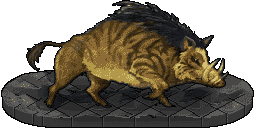
The Wild Boar is a formidable and often fearsome creature, known for its aggressive nature, powerful build, and surprising speed.These beasts roam temperate forests, dense woodlands, and occasionally open plains, their presence often marked by uprooted vegetation, deep tracks, and the musky scent they leave behind.With coarse, bristly hair covering a thick, tough hide, and sharp, upward-curving tusks, a Wild Boar is a dangerous opponent for any who dare to cross its path or stumble into its territory.
Wild Boars are highly territorial and will fiercely defend their domain, particularly sows with young.They are known to charge without warning, using their powerful tusks to gore and trample enemies with savage efficiency.Despite their seemingly reckless aggression, Wild Boars are cunning and resourceful, often using the terrain to their advantage during an attack, such as charging from dense underbrush or using their bulk to drive foes into disadvantageous positions.
Their thick hides provide substantial natural protection, making them resilient against various forms of attacks, and their keen senses of smell and hearing make them difficult to surprise.The Wild Boar's surprising speed for its bulk makes it a challenging quarry for hunters and a dangerous foe in combat. Those who manage to bring down a Wild Boar are often celebrated for their bravery and skill, as these creatures fight with a desperate tenacity.
In many cultures, Wild Boars are symbols of untamed strength, ferocity, and tenacity. Legends speak of boars of prodigious size and cunning that can only be defeated by the mightiest of heroes, and their tusks are often prized as trophies or fashioned into potent charms or weapon components.Despite their fierce reputation, Wild Boars are also respected for their role in maintaining the balance of their ecosystems, as their rooting habits help to clear underbrush and aerate the soil.Encountering a Wild Boar in the wild is an exhilarating and dangerous experience, one that requires both courage and strategy to survive. Adventurers are advised to approach with caution, for the wrath of a cornered or enraged Wild Boar is not easily escaped.
Wild Dogs: The Tenacious Pack Hunters
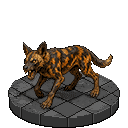
Common across plains, forests, and the fringes of civilization, Wild Dogs are a persistent and often underestimated threat. Smaller than wolves, these canids possess a lean, wiry build, with coats of fur that vary widely in color – from dusty browns and tans to mottled greys and blacks – allowing them to blend into diverse terrains. Their eyes gleam with a primal cunning, and their presence is often announced by a cacophony of yips, barks, and howls as they coordinate their hunts.
Wild Dogs are quintessential pack hunters, relying on numbers, relentless harassment, and surprising bursts of speed to wear down and overwhelm their prey. While an individual dog might pose little threat to a seasoned adventurer, a coordinated pack can be exceedingly dangerous. They are adept at flanking maneuvers, nipping at heels, and creating diversions to isolate weaker members of a group. Their primary weapons are their sharp teeth, delivering piercing bites that, while not individually devastating, can quickly accumulate into grievous wounds when delivered by multiple attackers.
These creatures are highly adaptable, thriving in a multitude of environments and feeding on a wide range of prey, from small game to the young or infirm of larger species. They are fiercely territorial, particularly when a den with pups is nearby, and will aggressively drive off intruders. Though not possessing high intelligence, they exhibit a strong pack instinct and a remarkable capacity for cooperative hunting. Their lairs are often simple dens dug into hillsides, beneath tangled roots, or in abandoned burrows. While they don't hoard treasure, their presence can often signal an area rich in game, or conversely, a region where livestock and unwary travelers are at significant risk.
Werewolves: The Moon-Cursed Savagery
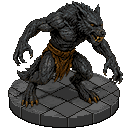
The Werewolf is a creature of chilling legend, a human cursed with the terrifying ability to transform into a savage, wolf-like beast or a monstrous hybrid form that blends the worst aspects of both. This affliction, often transmitted by the bite of another lycanthrope or through dark curses, warps the victim's body and mind, particularly under the light of the full moon, unleashing a primal ferocity and an insatiable bloodlust.
In their humanoid form, individuals afflicted with lycanthropy may show subtle signs of their condition – perhaps unusually sharp senses, a volatile temper, or an inexplicable restlessness during certain lunar phases. However, when the transformation takes hold, they become terrifying predators. As a wolf, they are larger and more cunning than natural beasts. In their hybrid form, they are towering figures of corded muscle, sharp claws, and powerful jaws filled with rending fangs, their eyes burning with a malevolent, animalistic intelligence.
Werewolves are most commonly found haunting desolate forests, mist-shrouded moorlands, and remote mountain regions, their territories often marked by the grisly remains of their kills. They are possessed of formidable strength, surprising speed, and senses far keener than any normal human or wolf. Their thick hides and resilient forms grant them considerable protection, and they are notoriously difficult to harm with conventional weaponry; only silver or magical armaments are consistently effective against their accursed forms.
While the transformation often brings with it a loss of self-control, subsumed by the beast's savage instincts, Werewolves are far from mindless. They possess a cunning intellect, allowing them to hunt effectively, avoid traps, and even outsmart their foes. Some retain more of their human intelligence than others, making them even more dangerous. Tales abound of werewolves living double lives, their human facade masking the nocturnal monster within, leading to tragic betrayals and horrifying revelations. The howl of a werewolf echoing through the night is a sound that chills the blood, a promise of savage violence and a reminder that the line between man and monster can be terrifyingly thin.
In Conclusion
The knowledge contained within these pages represents but a foundation upon which your adventures shall be built.The true essence of Creatures & Chronicles lies not in rules and statistics, but in the stories you create, the challenges you overcome, and the legends you forge through your actions.
Remember that while dice and rulebooks may guide your path, it is imagination and camaraderie that transform a mere game into an epic tale worthy of remembrance. May fortune favor your blade, wisdom guide your spells, and courage steel your heart as you venture forth into the unknown.
Herein concludes the Codex of the Realms, your faithful companion in the lands of Creatures & Chronicles. Guard it well, for knowledge is power, and in the depths of the dungeon or the heights of the mountains, power oft means survival.
I have carried this tome through three campaigns and countless dungeons. Its pages, worn at the edges and stained with both ale and the blood of goblins, have saved my company more times than I can recount. Treat it as a trusted friend, for that is what it shall become. -Alrandir the Sage